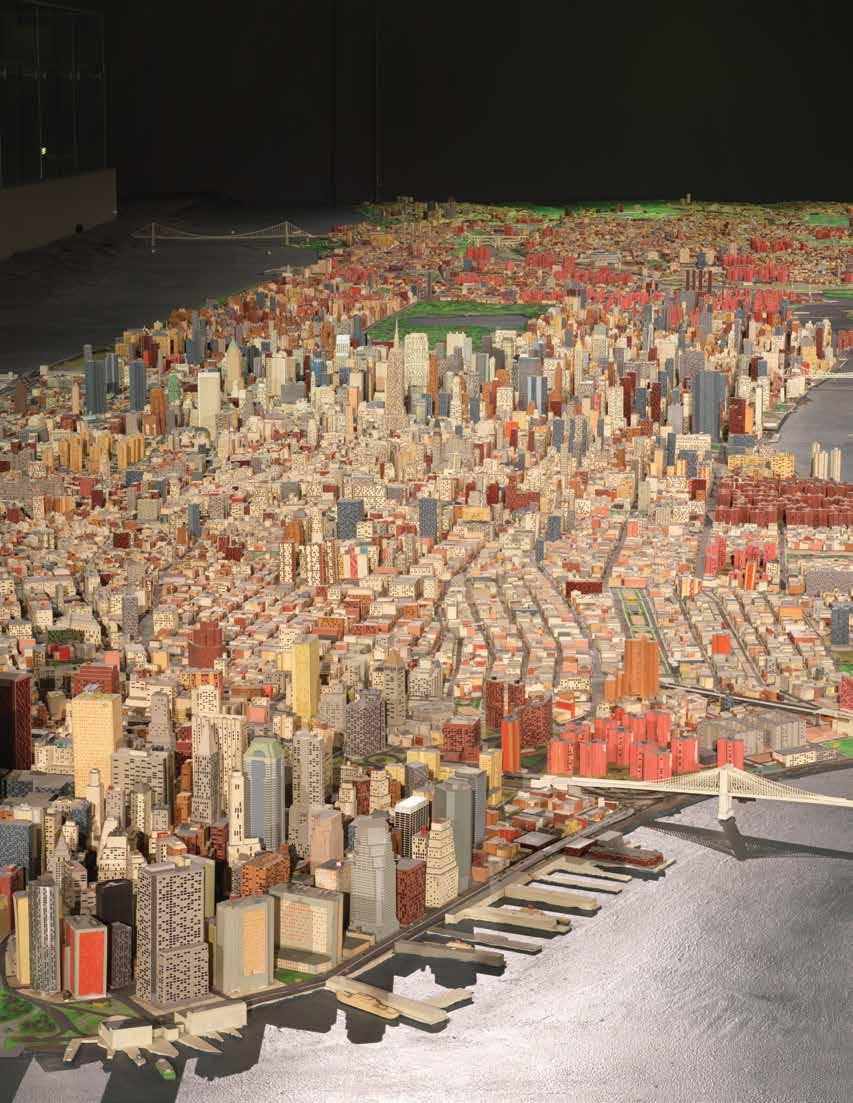
Quarterly The Journal of the white house historical association Spring 2023, Number 69
The White House and New York WHITE HOUSE HISTORY
the white house historical association
Board of Directors chairman
John F. W. Rogers
vice chairperson
Teresa Carlson treasurer
Gregory W. Wendt secretary
Anita B. McBride president
Stewart D. McLaurin
Eula Adams, Michael Beschloss, Gahl Hodges Burt, Merlynn Carson, Jean M. Case, Ashley Dabbiere, Wayne A. I. Frederick, Deneen C. Howell, Tham Kannalikham, Metta Krach, Barbara A. Perry, Ben C. Sutton Jr., Tina Tchen
national park service liaison: Charles F. Sams III
ex officio: Lonnie G. Bunch III, Kaywin Feldman, Carla Hayden, Katherine Malone-France, Debra Steidel Wall (Acting Archivist of the United States)
directors emeriti: John T. Behrendt, John H. Dalton, Nancy M. Folger, Knight Kiplinger, Elise K. Kirk, Martha Joynt Kumar, James I. McDaniel, Robert M. McGee, Harry G. Robinson III, Ann Stock, Gail Berry West
white house history quarterly
founding editor
William Seale (1939–2019)
editor
Marcia Mallet Anderson
editorial and production manager
Margaret Strolle
associate vice president of publishing
Lauren McGwin
senior editorial and production manager
editorial coordinator
Rebecca Durgin
consulting editor
Ann Hofstra Grogg
consulting design
Pentagram
editorial advisory
Bill Barker
Matthew Costello
Mac Keith Griswold
Scott Harris
Joel Kemelhor
Jessie Kratz
Rebecca Roberts
Lydia Barker Tederick
Bruce M. White
the editor wishes to thank The Office of the Curator, The White House
william g. allman is the former curator of the White House, having retired from the office in 2017 after forty years. He coauthored Something of Splendor: Decorative Arts from the White House, compiled the catalog of objects for The White House: Its Historic Furnishings and First Families, and contributed to The White House: An Historic Guide and the second edition of Official White House China: From the 18th to the 21st Centuries, and many other White House Historical Association publications.
thomas j. balcerski , a presidential historian, is associate professor of history at Eastern Connecticut State University. He is the author of Bosom Friends: The Intimate World of James Buchanan and William Rufus King.
joy b. ferro is president of Elements for Success and is a consultant at the White House Historical Association. She specializes in project and event management in the United States and abroad. Ms. Ferro’s love of New York runs deep and is a self-proclaimed “native” New Yorker.
matt green is a former engineer who quit his job in 2010 to walk across the U.S.A. Since 2012 he has been walking every block of every street in New York City, a journey of more than 9,000 miles.
scott harris is the Executive Director of University of Mary Washington Museums and an editorial adviser for White House History Quarterly.
dean j. kotlowski is professor of history at Salisbury University. He has been a historical adviser to the National Archives, Richard Nixon Library, and U.S. Mint and has served four times as a Fulbright scholar. He is the author many books including the forthcoming Toward Self-Determination: Federal Indian Policy from Truman to Clinton.
kayli reneé rideout is a Ph.D. candidate in the American & New England Studies Program at Boston University. She studies American social history through decorative arts and material culture of the late 19th and early 20th centuries.
margaret strolle is an editorial and production manager at the White House Historical Association and a regular contributor to White House History Quarterly..
2
contributors
First Lady
Jacqueline Kennedy accepts a gift for the White House Collection from Sears, Roebuck and
five
Native
Tiffany’s Associated Artists to Decorate the White House
84 NANCY REAGAN, THE BARBIZON, And a World Gone By
90
“HATS ARE THE MOST IMPORTANT THING”: Jacqueline Kennedy’s Letter to Bergdorf Goodman
margaret strolle
94
PRESIDENTIAL SITES FEATURE: Herbert Hoover, Apt. 31A, and U.S. Presidents at the Waldorf-Astoria

dean j. kotlowski
116 REFLECTIONS
stewart d. m c laurin
3 contents 4 FOREWORD marcia mallet anderson 6 STREET SCENES A New York Pedestrian’s Chance Encounters with Presidential History matt green 26 BEFORE THE WHITE HOUSE New York’s Capital Legacy thomas j. balcerski 38 THE NEW YORK CITY DEATH AND BURIAL of President James Monroe scott harris 52 MADE IN NEW YORK For the White House william g. allman 72 A TIFFANY WHITE HOUSE INTERLUDE: President Chester A. Arthur Commissions Louis Comfort
kayli reneé rideout
joy ferro
ALAMY
Company of
portraits of
Americans painted by Charles Bird King. The gift is presented by Sears vice president, James T. Griffin, who holds up a portrait of Chief Shaumonekusse of the Oto tribe, December 6, 1962.
Only in New York
Before there was a 1600 Pennsylvania Avenue, or even a City of Washington, some of the earliest chapters of White House history were written in New York City. George Washington took the first presidential Oath of Office at Federal Hall on Wall Street in 1789 and lived in the first presidential mansions on Cherry Street and on Broadway before the young federal government was moved to Philadelphia in 1790. For more than two centuries, New York City has welcomed, accommodated, celebrated, and mourned Washington’s successors. Though all of these later presidents would reside in the White House in Washington, D.C., the lives of many included consequential years in New York. In a city so rich in history, many landmarks have inevitably been lost to time, while others—still standing or at least identified by markers on newer buildings—offer moments in White House history to millions of passersby. With this issue, White House History Quarterly explores the historical connections between New York City and the White House from the first Oath of Office to the present day.
Our visit to New York opens with a journey expertly led by Matt Green, who since 2011 has walked more than 9,400 miles of the city, block by block, embracing countless chance encounters with presidential history along the way. “There’s a big difference between reading about a place in a book and being there in person,” he explains. “What it feels to stand in front of it, to touch it, to discover something about it—all of a sudden it comes alive to me.” Through Green’s expedition we, too, discover such easily overlooked places as the site where Chester A. Arthur took the Oath of Office and bodegas named for Barack Obama, as well as the four-hundred-year-old tulip tree that has witnessed it all.
With his article “Before the White House: New York’s Capital Legacy,” presidential historian Thomas Balcerski takes us back to the New York that President Washington knew and traces the legacy of the sites where he was inaugurated and lived.
“After traveling far and wide in life, James Monroe continued his odyssey in death,” explains historian Scott Harris with his article, which traces a series of temporary entombments that ultimately took the fifth president’s remains from New York to Virginia.
Former White House Curator William G. Allman presents the many New York manufacturers whose works are among the most treasured objects in the White House Collection of decorative arts today. Included are furniture by Charles-Honoré Lannuier and Duncan Phyfe, pianos by Steinway & Sons, silver by Tiffany, and lighting by Edward F. Caldwell. One of the most legendary of these New York businesses is the focus of Kayli Reneé Rideout’s article “A Tiffany White House Interlude.” Rideout explores President Arthur’s commission of Louis Comfort Tiffany’s Associated Artists to decorate the White House in 1881. Their once-celebrated decor of the State Floors would last for barely twenty years before succumbing to inevitable changes in taste. Yet interest in Tiffany’s longlost jewel-toned glass screen, which once transformed the White House Entrance Hall, has never faded.
Reminding us that America’s first ladies have long been connected to New York, author Joy Ferro, recounts the story of future first lady Nancy Reagan who, in the late 1940s, pursued her early dreams on the stage while living at the Barbizon, a safe and respectable residential hotel for women on the Upper East Side.
Author Margaret Strolle takes us to a display on the seventh floor of Bergdorf Goodman to study a letter written by Jacqueline Kennedy, one of many first ladies who turned to New York for fashion. Determined that every detail of her look be perfect, she requested a personal shopper to select hats and gloves to complete her wardrobe.
For our presidential sites feature in this issue, historian Dean Kotlowski takes us to the Waldorf-Astoria, which has welcomed the presidents and first ladies at political and social events for more than a century. His article “Herbert Hoover, Apt. 31A, and U.S. Presidents at the Waldorf-Astoria” recounts the retirement of President Hoover, who was comfortable there for more than twenty years.
The two centuries of the entwined history we have begun to explore with this issue is made up of at least as many stories, both large and small, as the number of blocks and miles Matt Green has walked. So we devote a few of the final pages of this issue to a photographic sampling of those smaller, fleeting, and “only in New York.”
4 foreword marcia
anderson
quarterly
mallet
editor, white house history

5 white house history quarterly SHUTTERSTOCK
Crowds begin to gather for a ceremony at a replica of the Federal Hall building reconstructed in Bryant Park 1932. Erected to celebrate George Washington’s one-hundredth birthday, the temporary structure was intended to recreate the site where Washington took the oath of office in 1789.
David
Could you make the words dark enough to be legible?

6
STREET SCENES:
A New York Pedestrian’s Chance Encounters with Presidential History
 MATT GREEN
MATT GREEN
7 white house history quarterly
OPPOSITE: MATT GREEN / ABOVE: BRUCE WHITE FOR THE WHITE HOUSE HISTORICAL ASSOCIATION
Matt’s ongoing walk of New York City will ultimately cover every street in the five boroughs: the Bronx, Brooklyn, Manhattan, Queens, and Staten Island. The boroughs are clearly illustrated in this map made in 1900, when Staten Island was still known as Richmond. Matt has been on his journey for more than eleven years and has covered over 9,400 miles.

8
GETTY IMAGES white house history quarterly
Matt’s years of walking every street in the five boroughs of New York began December 31, 2011. Blindfolded by friends, he was driven to Amboy Road in Staten Island, a randomly selected location, where he removed the blindfold and started walking.
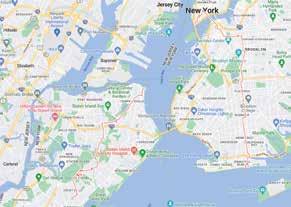
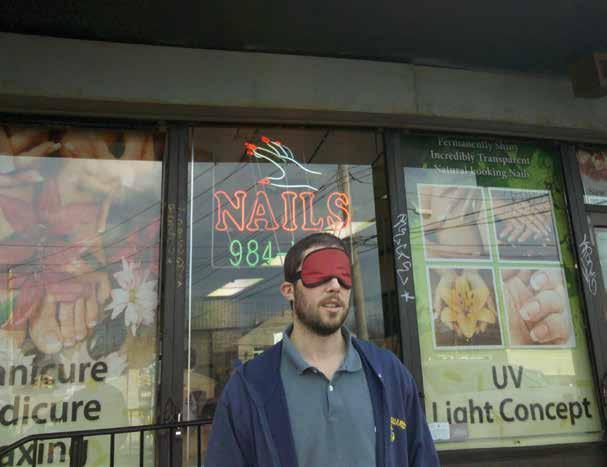
Disembarking the big orange ferry after a ride across New York Harbor from Staten Island, a few friends and I start to make our way uptown from the southern tip of Manhattan. Unlike the modernist numbered thoroughfares that methodically divide most of Manhattan into tidy rectangular blocks, the narrow streets down in this part of the island evoke an older era. They bend and meander, tracing the routes of the first roads laid out here by Dutch colonists almost four hundred years ago. Nearby Wall Street gets its
name from the wooden wall that once stood along its path, a protective barrier built at what was then the northern edge of the settlement known as New Amsterdam. And Wall Street, in turn, has given this neighborhood its name: the Financial District. But even as the area has been thoroughly shaped by the relentless, unsentimental tide of capitalism, there remains a romantic sense of history hanging in the air.
The friends joining me on this walk are marking the first day of my multiyear quest to walk every block of every street in the five boroughs of New York City. Adding in parks, cemeteries, beaches, and various other public spaces, it will end up being a journey of more than 9,000 miles on foot, all within the bounds of a single city. I don’t know it at the time, but it will take me well over a decade to complete.
We had started the day at a randomly selected location, the 4300 block of Amboy Road in Staten Island. I didn’t even know where I was until the friends who had driven me there took off my blindfold. The plan was to get my bearings and map out a
9 MATT GREEN
DAY 1: December 31, 2011
white house history quarterly

10 BRUCE WHITE FOR THE WHITE HOUSE HISTORICAL ASSOCIATION white house history quarterly
long walk to the ocean, celebrating New Year’s with a plunge in the chilly Atlantic. We decided to head north to the ferry and then across the bottom of Manhattan to the Brooklyn Bridge and on through Brooklyn to Brighton Beach. The 27 miles of blocks we’ll cover constitute just one puny little line on my progress map, the first tiny bite taken out of a truly immense apple.
A few blocks from the ferry terminal, at Broad and Pearl Streets, we pass Fraunces Tavern, a stout three-story brick building. The name is familiar to me—some kind of association with George Washington—but I’m not sure of the details.
Rather than read about the areas I’m going to walk ahead of time, I like to just walk, try my best to pay attention, and take lots of photographs. Then I research what I see afterward. I don’t know enough to decide what’s important beforehand; I just let things catch my eye and then I dig in from there. What I end up with is not a thorough, organized account of the city’s history but instead an idiosyncratic understanding that builds slowly and circuitously, often in unpredictable and oblique ways, as individual threads of discovery that seem insignificant on their own begin to weave a dense, tangled
web of connections across many years and miles. Which is a wordy way of explaining why it’s only later, after the day’s trek is done, that I read that Fraunces Tavern is where, not long after the final British troops left New York City in 1783 at the end of the Revolutionary War, General Washington bade a poignant farewell to an assemblage of officers of the Continental Army. One of those officers, Colonel Benjamin Tallmadge, penned his recollections some years later:
After the officers had taken a glass of wine General Washington said “I cannot come to each of you but shall feel obliged if each of you will come and take me by the hand.” General Knox being nearest to him turned to the Commander-in-chief who, suffused in tears, was incapable of utterance but grasped his hand when they embraced each other in silence. In the same affectionate manner every officer in the room marched up and parted with his general in chief. Such a scene of sorrow and weeping I had never before witnessed and fondly hope I may never be called to witness again.1

11 white house history quarterly
GETTY IMAGES
The landmarks Matt passed on his first day of walking every block in New York included Fraunces Tavern (seen opposite in 2023), where George Washington famously made a farewell toast to his officers at the end of the Revolutionary War. The colorful lithograph (above) depicting the moment was made by Nathaniel Currier in 1848.
DAY 30: January 29, 2012
experience. The ranch-style houses, the front yards, the trees planted along the sidewalks—all pleasant features of a lovely neighborhood but not the kinds of things that jump out and grab your attention as you pass by. But sometimes the wonder of a place’s present can be appreciated only in relation to its past.
A pedestrian could be forgiven for walking the three blocks of Charlotte Street in the South Bronx and coming away without a distinct memory of the
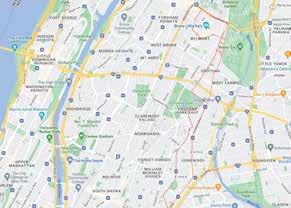
A pedestrian visiting Charlotte Street in 1977, for example, would likely have found the scene much more memorable, as Jimmy Carter discovered on an October morning of that year. A day after addressing the United Nations General Assembly on the subject of nuclear disarmament,2 President Carter headed uptown to witness firsthand the devastating urban decay that had ravaged the South Bronx. Iconic photos from his stop at Charlotte Street show him striding across vacant lots filled with rubble in what could be mistaken for
Matt’s walk in the South Bronx on Day 30 led him to Charlotte Street, an area also walked by President Jimmy Carter in 1977. What Carter found here was bleak—a dismal scene of urban decay. The area has since been so transformed that even the Bronx borough historian is not able to pinpoint the exact spot where this photograph of Carter’s visit was taken.
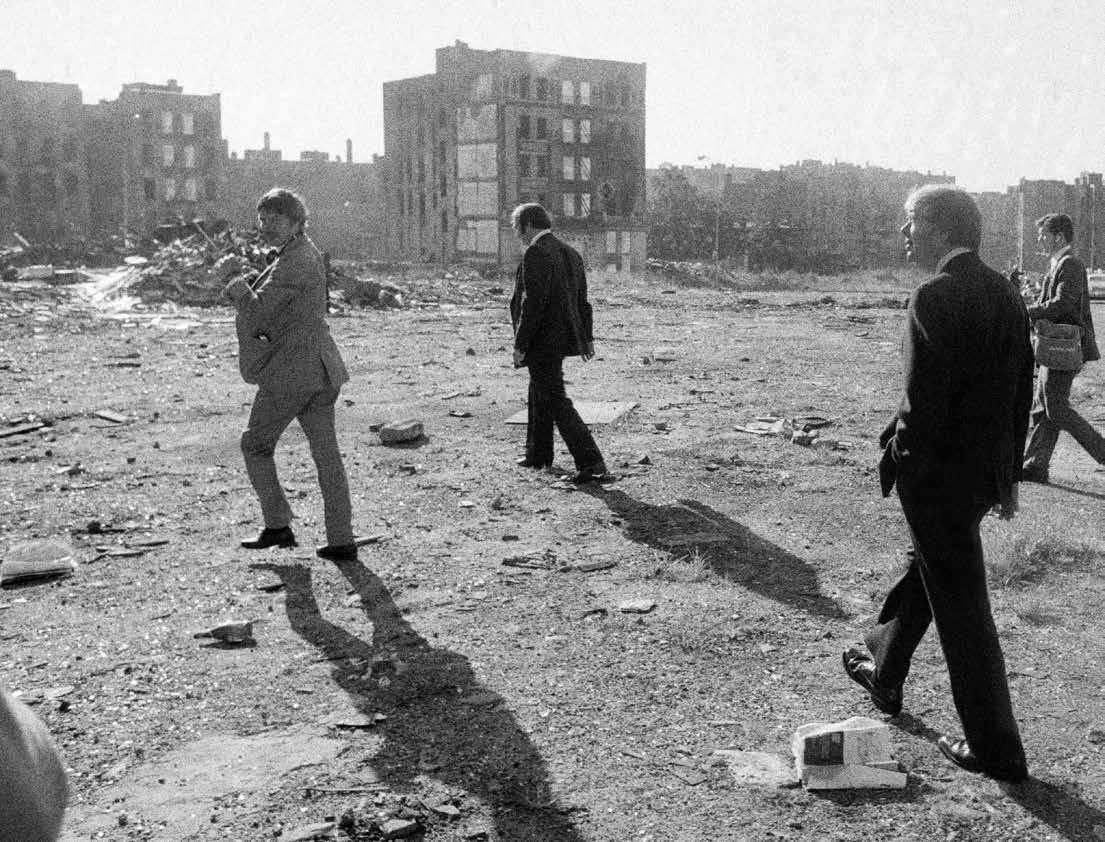
12 TERESA ZABALA/THE NEW YORK TIMES/REDUX
white house history quarterly
a bombed-out war zone.3 The Bronx borough historian, Lloyd Ultan, told the New York Times that he can’t even identify exactly where on Charlotte Street the photos were taken; there’s nothing that can serve as a landmark amid the utter desolation and emptiness.4

Today’s tranquil, ordinary Charlotte Street is a far cry from those dark days. It serves as a reminder of how quickly things can change when enough people with enough power decide a change needs to be made. But it also points to the lingering weight of stereotypes. Photos of the Bronx from the 1970s shape the public perception of the borough more than the modern-day reality does. And the reality, as you soon discover once you set foot there and say hi to a few folks, is that the Bronx, like everywhere else, is full of people who are exactly the same as
you, people trying to make a living, find love, care for their family, and do something meaningful with their time on earth.
I’m also struck by something else when I look at those photos of Jimmy Carter. I see a Georgia peanut farmer, fresh off grappling with the perils of international nuclear proliferation, now facing an overwhelming scene of urban despair here at home. The array of challenges facing anyone who dares to shoulder the weight of the presidency is so vast. It must be absolutely terrifying to take the Oath of Office and realize everything is now within your purview, all the struggles and anguish of an enormous nation in a tumultuous, ever-changing world. The ambition of anyone who could attempt such a thing is beyond me.
13 MATT GREEN white house history quarterly
The tranquil, treelined Charlotte Street that Matt photographed on a walk in 2012 bears no trace of the wreckage and rubble witnessed by Carter on his presidential visit.
Strolling through Manhattan’s East Village, passing a dense collection of row houses and apartment buildings on Second Street, I come upon a verdant enclave, a tiny cemetery occupying perhaps a quarter of a block. According to a sign on the fence, this is the New York City Marble Cemetery. It opened in 1831 and it’s the final resting place of a prominent merchant named Preserved Fish. I imagine him introducing himself at a party: “The name is Preserved Fish, but you can just call me Pickled Herring.”
As I later discover, the cemetery was also the notso-final resting place of an even more prominent figure: President James Monroe. After the death of his wife Elizabeth in 1830, he moved from his native Virginia to New York City to live with his daughter and her husband. He passed away the following year and was buried in the family vault of his son-in-law here at the cemetery.5 After twenty-seven years of peaceful repose, his remains were disinterred in 1858 and shipped to Hollywood Cemetery in Richmond, Virginia, in grand style, a move initiated by Virginia’s governor, Henry A. Wise, as an expression of state pride.6 At Hollywood, President Monroe is entombed in a granite sarcophagus surrounded by an ornate cast-iron Gothic structure known to locals as “The Birdcage.”7
Another twenty-seven years after President Monroe’s departure, a new president would be laid to rest in New York City, this one for keeps. If you’re wondering who I’m talking about, you’ll just have to puzzle out the answer to the age-old riddle: Who is buried in Grant’s tomb?

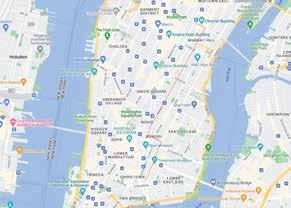
New York City Marble Cemetery was for a time—from 1831 until 1858—the resting place of President James Monroe. Matt’s walk through the East Village on Day 98 took him past this tiny cemetery. Monroe is now buried in Richmond, Virginia, and is not mentioned on the plaque that hangs on the front gates. However, the wealthy merchant Preserved Fish (seen above c. 1830) made it into the posted history.

14 white house history quarterly LEFT: BRUCE WHITE FOR THE WHITE HOUSE HISTORICAL ASSOCIATION / WIKIPEDIA
DAY 98: April 6, 2012
Unlike President Monroe, whose interment in New York was ultimately temporary, President Grant remains buried in Manhattan, in what is the largest mausoleum in North America. Matt’s walk took him to Grant’s Tomb on Day 1,941 (April 23, 2017).


15 white house history quarterly BOTH IMAGES: MATT GREEN
DAY 207: July 24, 2012
Heading down Pearl Street in Lower Manhattan, I pass under the Brooklyn Bridge, beneath a set of steel arches that support the roadway above. Chainlink construction fencing abounds, preventing curious passersby from getting a good look at the monumental stone anchorage of the bridge on either side of the street.
drawn to the south side of the street, to the rows of headstones in St. Peter’s Cemetery, the oldest Catholic cemetery on the island. But then I notice something unusual sticking out on the house-lined north side of the street: a large statue of a horse standing in a neatly planted bed of roses and shrubs.
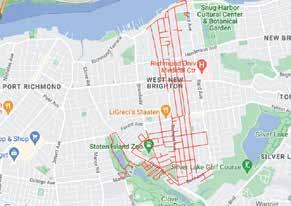
After examining the sporty metallic equine, its muscles and veins visibly rippling beneath its skin, I turn my attention to the adjacent house. It’s much grander and older-looking than its neighbors, Greek revival in style with a quartet of two-story Corinthian columns supporting the roof of a stately portico.
Researching the house later on, I learn that one former resident was Julia Gardiner Tyler, the second wife and widow of John Tyler, who moved here to live with her mother after the former president passed away in 1862. While her husband may have had a fairly undistinguished run as president, he did establish a handful of firsts appreciated by trivia buffs. Following the death of William Henry Harrison, he became the first vice president to ascend to the highest office in the land without being elected, earning him the derisive nickname “His Accidency.” He was also the first president to
Matt’s Day 207 walk led him once again under the Brooklyn Bridge. This photo he took in 2022 shows how construction fencing blocks the view of the bridge’s monumental stone supports.

16
DAY 904: June 21, 2014
white house history quarterly
Walking along Tyler Avenue in the West Brighton neighborhood of Staten Island, my eye is initially
MATT GREEN
lose a spouse while in office, and became the first to get married in office when he and Julia tied the knot in 1844.

Despite hailing from New York State, Julia came to adopt the southern sympathies of her plantation-owning husband, whose casket was laid to rest in Hollywood Cemetery in Richmond, Virginia, just a few years after James Monroe’s, draped not in the Stars and Stripes but in a Confederate flag.8 While living on Staten Island, Julia continued to advocate for southern causes during the Civil War. Two of her sons fought in the war on the Confederate side.9
And speaking of her offspring, here’s the most amazing bit of Tyler-related trivia that I find along the winding path of discovery that began with that odd horse statue: Julia and John have a living grandson. I repeat: John Tyler, who was born in 1790, has a living grandson, Harrison Ruffin Tyler, who is 94 years old.10 Harrison’s father, like his father before him, married a much younger woman after the death of his first wife, stretching out the generational timeline and making this astounding feat possible.11

17 white house history quarterly BOTH PHOTOGRAPHS: MATT GREEN
The widowed First Lady Julia Gardiner Tyler, a New York State native, lived in this grand Greek Revival house on Tyler Avenue in Staten Island following the death of President John Tyler in 1862. It was the nearby figure of a horse, so dramatically sculpted, that first drew Matt’s attention to the house on Day 904.
DAY 1,045: November 9, 2014
This ethnic career path was established the way so many others have been throughout time: A pioneer learns a specific trade and then teaches it to newer immigrants looking to establish a foothold in an unfamiliar country, in this case Afghans fleeing their homeland after the Soviet invasion began in 1979. The knowledge gets handed down over the generations, and, before you know it, and in a beautiful mishmash of cultures, you end up with an American city chock-full of Afghan-run chicken shops all named for a U.S. president who just so happened to share the first syllable of his last name with a certain American state featured prominently in the world’s most popular fried chicken brand.12
Barack Obama has a significant personal connection to New York City. He completed his undergraduate degree at Columbia University and spent a couple of years afterward living and working here. After all my walking, however, I’m starting to pick up on a different sort of relationship between the city and President Obama, one based not on residency but rather on the powerful symbolic quality of his presidency and the sense of possibility his election provided to many underrepresented communities. This relationship reveals itself little by little in the physical fabric of the city, expressed every now and again in a modest tribute like the name of a local business or a mural on the wall of a school.
But today, in Brooklyn’s Cypress Hills, I witness an unprecedented level of devotion to our forty-fourth president. I come across three different Obama-inspired bodega names within a seven-block stretch of Fulton Avenue: Obama Tobacco, Obama 44 Deli & Grocery, and King Barack Candy Store.
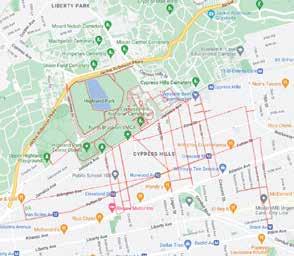
This brings to mind another memorable business name I encountered back in 2012 in Brownsville, Brooklyn: Obama Fried Chicken, a new addition to the proud New York tradition of presidential chicken. You can find a few Lincoln Fried Chicken shops around town, but the dominant player in this game is John F. Kennedy. There are dozens of Kennedy Fried Chicken joints cooking up birds all across the city. While they often have similar appearances and menus, the restaurants are generally run independently of each other and are largely owned and operated by Afghan immigrants.

18
white house history quarterly
MATT GREEN
Barack Obama, seen (above) walking to his car after arriving on Marine One at the Downtown Manhattan Heliport in 2010, attended college and worked in New York in the 1980s. The city’s affection for the president was evident in a seven-block stretch of Fulton Avenue Matt walked on Day 1,045, where three bodegas were named for him: Obama Tobacco (right), Obama 44 Deli & Grocery (above right), and King Barack Candy Store (opposite).



19 white house history quarterly TOP LEFT: WHITE HOUSE PHOTO / TOP RIGHT AND BOTTOM: MATT GREEN
President
DAY 1,364: September 24, 2015
The construction fencing beneath the Brooklyn Bridge at Pearl Street is still there, years after I first walked by, continuing to block public access to the bridge’s massive stone anchorage.
DAY 1,521: February 28, 2016
Making my way across Curry Hill in Manhattan, I stop at Kalustyan’s, the renowned spice and specialty food emporium that has been in business here at 123 Lexington Avenue since 1944. As much of an institution as the store has become, however, Kalustyan’s is not the most notable resident the building has ever had. That honor belongs to Chester Alan Arthur, who made a name for himself as a New York attorney before entering politics.
One significant case Arthur took on in his younger years was an 1854 lawsuit against the Third Avenue Railway Company filed on behalf of Elizabeth Jennings, who had been thrown off a streetcar on her way to church because she was Black. The successful suit paved the way for the eventual integration of all of the city’s public transportation in 1873.13 Elizabeth Jennings, whose place in history has long been overlooked, is now slated to be honored in the coming years with a statue in Manhattan commemorating her bravery and determination, part of a push to diversify the city’s collection of public statues, almost all of which depict males.14
Two notable sculptures of U.S. presidents have been taken down in New York in recent years amid this reconsideration of what our public art should be depicting and honoring. A statue of Thomas Jefferson was removed from the City Council chamber in 2021 because of his history as an enslaver of more than six hundred people during his life. And a statue of Theodore Roosevelt riding a horse and
flanked by a Native American man and a Black man on foot was removed from the entrance of the American Museum of Natural History in 2022 because of its depiction of the men as subservient to President Roosevelt.
But let’s get back to 123 Lexington, which was the site of a very significant moment in presidential history, a moment whose memory is only tenuously carried into the modern day by an inconspicuous plaque mounted behind glass by the foyer door leading to the apartments above Kalustyan’s. The plaque reads, in part:
HERE ON SEPTEMBER 20, 1881, AT 2:15
A.M., CHESTER ALAN ARTHUR TOOK HIS OATH OF OFFICE AS 21st PRESIDENT OF THE UNITED STATES UPON THE DEATH OF PRESIDENT JAMES A. GARFIELD, KILLED BY
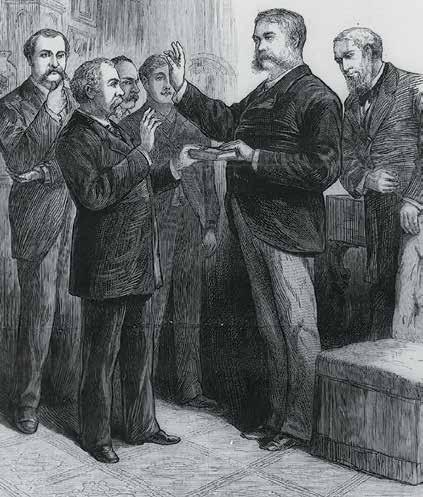 A DISGRUNTLED OFFICE SEEKER.
A DISGRUNTLED OFFICE SEEKER.
On Day 1,521, Matt’s walk took him through President Chester A. Arthur’s old neighborhood, Curry Hill in Manhattan. It was at his home at 123 Lexington Avenue that Arthur took the presidential oath of office following the assassination of President James A. Garfield in 1881.
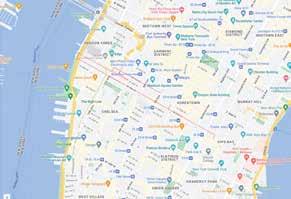
20
LIBRARY OF CONGRESS white house history quarterly
President Arthur might not recognize his old home on Lexington Avenue if he were to see it today. In his time (right), the entrance was on the second floor at the top of a short flight of stairs. Today, the building has been transformed to accommodate a storefront for Kalustyan’s (above), where spices have been sold since 1944.
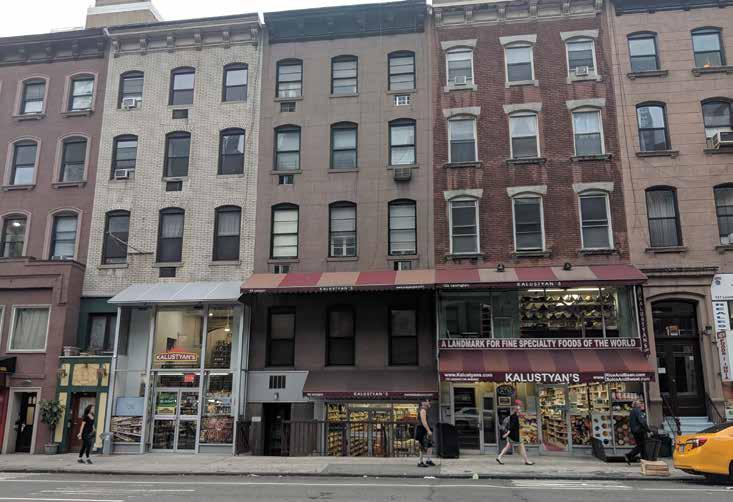
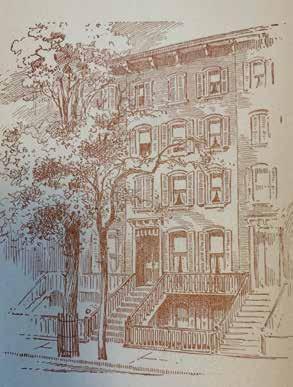
David can you improve color?
This event made President Arthur the second, and to date last, president to take his Oath of Office in New York City. An imposing statue of George Washington standing outside the present-day Federal Hall on Wall Street very visibly calls attention to the location where our first president was sworn in, but the building where Chester Arthur assumed the duties of the presidency, a building that is still standing, unlike the Federal Hall of President Washington’s era, is all but invisible to the throngs of pedestrians passing by on the sidewalk every day.
21 TOP: MATT GREEN / BOTTOM: WHITE HOUSE HISTORICAL ASSOCIATION white house history quarterly
DAY 3,545: SEPTEMBER 13, 2021
More than nine years after I first walked under the Brooklyn Bridge on Pearl Street, the construction fencing is still standing and preventing the public from approaching the bridge’s stone anchorage. While there’s nothing in particular about the anchorage that would call out to someone walking by, I’ve learned over the years that surprising details and stories are hidden all over the city, and it’s not unusual for a seemingly pointless inspection of your surroundings to end up leading you somewhere you never expected.
DAY 3,800: May 26, 2022
I’ve been working on an article about my NYC walk and some of the presidential stories I’ve stumbled across along the way. While many presidents are woven into the fabric of the city in ways large and small, I’ve felt the presence of George Washington more than any other over the years. This makes sense, given that he led the Continental Army here during the early stages of the Revolutionary War and then served as president here during the brief period when New York was the nation’s capital.
As noted previously, the site of his swearing-in is prominently memorialized at Federal Hall, as you would expect. But, spurred on by the fact that this article I’m writing is for the White House History Quarterly, I realized I had no idea where George Washington lived during his time in New York. It seemed odd that I had never come across anything about his presidential residence—what would have essentially been our nation’s first White House.
What I learned is that he lived in two different presidential mansions during his time here, neither of which is still standing today. The first one was located at 1 Cherry Street (some say 3 Cherry Street), an address that ceased to exist when the Brooklyn Bridge was constructed on top of it. The only thing suggesting the symbolic importance of this location today is a brass tablet affixed to the bridge in 1899 by a chapter of the Daughters of the American Revolution.

I had never noticed this tablet before. Being a plaque aficionado, my pride was a bit wounded when I learned I had overlooked it. After a little more digging around, I discovered the exact location of the marker: it’s mounted on the stone anchorage of the bridge on the south side of Pearl Street. For the entirety of my walk, more than a
decade now, this tablet has been hidden behind construction fencing.
So I head out to Pearl Street once again. Knowing precisely where to look now, I can see the brass tablet from outside the fencing, although it’s unreadable at this distance. While I’m gawking at the bridge, a grumpy construction worker passes through a gate in the fence and gruffly tells me I’m blocking his way. I start enthusiastically explaining why I’m here—America’s first White House! The most significant George Washington Slept Here of them all! But he completely ignores me and slams the gate in my face.
A minute later, another worker opens the gate. He’s much friendlier and politely listens as I explain, probably sounding like a fevered crackpot, that this is where the first president of the United States lived. I plead with him to let me step inside the fence for ten seconds so I can take a photo of the plaque. He apologizes and tells me he can’t allow me in, for liability reasons, but he offers to take my phone and snap a photo for me. A pretty good compromise! Our government could use more people like this guy.
22 WHITE HOUSE HISTORICAL ASSOCIATION white house history quarterly
above
An illustration from 1877 shows how the site of the first presidential house came to be located under the Brooklyn Bridge. The image depicts the supports for the bridge rising above the surrounding buildings.
top
On Day 3,800, almost a decade after first passing the location, Matt finally spotted a brass tablet mounted on the stone anchorage supporting the Brooklyn Bridge. The plaque identifies the location of the first presidential mansion, George Washington’s home on Cherry Street. The tablet was installed by the Mary Washington Colonial Chapter in 1898, but construction barriers have made it inaccessible for the many years of Matt’s walk.
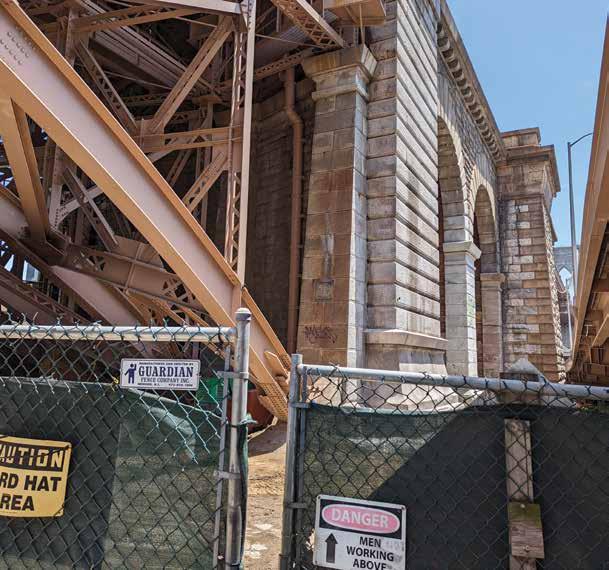
below

23 BOTH PHOTOGRAPHS: MATT GREEN white house history quarterly
This photo, taken for Matt by a construction worker, shows the nineteenth-century plaque marking the location of the first American presidential mansion.

24 white house history quarterly BOTH PHOTOGRAPHS THIS SPREAD: MATT GREEN
right
On Day 1,405, Matt crossed paths with President Washington again when he walked the service road of the Long Island Expressway. Along the route he photographed this plaque, which explains that Washington traveled the road on his tour of Long Island in 1790.
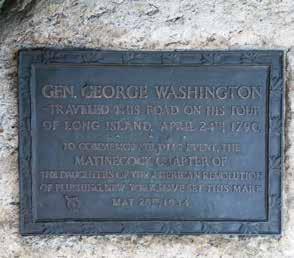
below
After crossing the Long Island Expressway and entering Alley Pond Park, Matt discovered the “Queens Giant,” a majestic, towering tulip poplar tree believed to be at least 400 years old. Matt was struck by the fact that it would have been standing tall when Washington visited the area himself. Today it is a living witness to the history Matt has encountered on his own journey through New York.
A FINAL REFLECTION
DAY 1,405: N ovember 4, 2015
I’m walking along the south service road of the notoriously traffic-clogged Long Island Expressway in Queens. When I reach the edge of Alley Pond Park, I look down and notice a bronze marker affixed to a boulder sitting beside the road. Placed there in 1934, it tells me that “George Washington traveled this road on his tour of Long Island, April 24th, 1790.” Imagining President Washington here conjures up an incongruous image of the presidential horsedrawn coach jammed in amid a million SUVs, stuck on the LIE in brutal rush-hour traffic, barely even moving at a crawl. George Washington Crept Here.
Enjoying the freedom of my bipedal propulsion, I cross over the LIE and head into the adjacent section of Alley Pond Park, looking for a mysterious creature known as the Queens Giant, a towering tulip tree that is thought to be the oldest living thing in New York City. But despite its soaring stature, it’s rather hard to find. Because it’s situated on a hillside, the shorter trees above it on the slope reach just as high into the sky and prevent it from sticking out noticeably.
After wandering through the woods for a bit, I finally come upon the Giant, identifiable by the chain-link fence ostensibly installed around the trunk to offer some protection to this ancient creature. But there’s a big hole cut in the fence and I duck in to take a closer look. I find a faded Parks Department information sign propped up against the base of the tree. The sign notes the Giant’s height (133.8 feet) and estimated age (400 years or more), and says that “it was standing tall when General George Washington passed close by in 1790 on a tour of Long Island,” offering a surprising resonance with the plaque I just saw beside the LIE.
Thinking about the sweep of history in New York can be a fairly abstract exercise. Even when I encounter a concrete physical link to the distant past in the form of a building or something else tangible, it’s tough for me to relate to the enormous expanse of time that has elapsed between that object’s creation and the moment when I find myself in its presence. I know it has existed all those years, but it’s done so in a kind of suspended animation that’s nothing like what a human being understands existence to be.
But the tree is something entirely different. I’m now standing next to and touching a being that
David can you make wording more legible?
hasn’t merely existed, but has actually been alive, since well before President Washington paid his visit to the area. The Giant has been spreading its roots for four centuries now, dating all the way back to when the first Dutch colonists set foot on the southern tip of an island then known to its native Lenape inhabitants as Mannahatta. This tree’s life is an unbroken chain of growth and breath, light and air, water and soil, bridging the vastness of time and connecting me to the past in a way I can viscerally feel.
NOTES
1. Quoted in “History,” Fraunces Tavern Museum website, www. frauncestavernmuseum.org.
2. Kathleen Teltsch, “Carter Says the U.S. Is Willing to Slash Atomic Arsenal 50%,” New York Times, October 5, 1977, A1.
3. Lee Dembart, “Carter Takes ‘Sobering’ Trip to South Bronx,” New York Times, October 6, 1977, A1.
4. Reported in Manny Fernandez, “In the Bronx, Blight Gave Way to Renewal,” New York Times, October 5, 2007.
5. “New York City Marble Cemetery: Landmark Designation,” March 4, 1969, New York City Landmarks Preservation Commission website, www.nycmc.org.
6. Parke Rouse, “Richmond Turned Out for Monroe Reburial,” Newport News (Va.) Daily Press, September 4, 1994.
7. “President James Monroe’s Tomb,” Hollywood Cemetery website, www.hollywoodcemetery.org.
8. “President John Tyler’s Monument,” Hollywood Cemetery website.
9. Christopher Gray, “Where a President’s Widow Backed the Confederacy,” New York Times, June 20, 1999, sec. 11, p. 7.
10. Robert D. McFadden, “Lyon Gardiner Tyler Jr., 95, Grandson of 10th President,” New York Times, October 8, 2020, B11.
11. Gillian Brockell, “The 10th President’s Last Surviving Grandson: A Bridge to the Nation’s Complicated Past,” Washington Post, November 29, 2020.
12. Steven Kurutz, “Chicken Little,” New York Times, August 15, 2004, sec. 14, p. 1.
13. Allison C. Meier, “The Woman Who Refused to Leave a WhitesOnly Streetcar,” JSTOR Daily, August 15, 2018, https://daily. jstor.org.
14. Julia Jacobs, “City Will Add 4 Statues of Women,” New York Times, March 7, 2019, A18.
25
white house history quarterly

Before the WHITE HOUSE
New York’s Capital Legacy
THOMAS J. BALCERSKI
on april 30, 1789, George Washington was inaugurated as the first president of the United States of America. On the streets below, crowds gathered to witness Washington, his hand placed on a Bible, be sworn in from a balcony at Federal Hall in New York City. After taking the Oath of Office, Washington supposedly added the words “So help me God” and kissed the holy book. Following the ceremony Washington delivered an Inaugural Address to the members of Congress, then attended services at St. Paul’s Chapel. That evening fireworks illuminated the sky. The future of New York City—and the nation—never looked brighter.
27 LIBRARY OF CONGRESS white house history quarterly
It had been a long road getting to this point. Between 1775 and 1785, first the Continental Congress and then the Confederation Congress had met temporarily in seven different cities, namely Philadelphia, Baltimore, Lancaster, York, Princeton, Annapolis, and Trenton.2 Adding to its difficulties, Congress was sharply divided over the permanent home of the capital, split between those who wanted a central inland location and those who favored an established seaboard city.3
New York had been devastated by seven years of British occupation, including two great fires that had burned extensive swaths of the city in September 1776 and again in August 1778. But the city’s fortunes had slowly improved following the British evacuation on November 25, 1783 (a date celebrated for decades by the city’s residents as “Evacuation Day”), such that by 1790, the diverse population had grown to 40,000, of which 2,500 were enslaved people.4 In 1784, Chancellor Robert Livingston and the New York State Legislature beseeched the beleaguered Congress to select New
York as its next meeting place.5 Abandoning a plan to create two capitals, Congress voted unanimously on December 23, 1784, to relocate from the French Arms Tavern in Trenton to “the city of New York.”6
Once in New York, the outgoing Confederation Congress set about passing important legislation, including the Northwest Ordinance of 1787, which provided for the organization of the Ohio country and notably excluded slavery from the territory.7 Congress also continued debating the relative merits of various sites for the permanent capital. In Philadelphia, the Constitutional Convention of 1787 failed to resolve the question and eventually voted to keep “the present Seat of Congress.”8

In September 1788, the Confederation Congress similarly voted to leave the seat of government in New York for the meeting of the new Congress, under the newly ratified Constitution, scheduled for March 4, 1789.9
New Yorkers eagerly prepared to celebrate the changeover to the new government. At midnight on March 3, thirteen cannons were fired from Fort
left
New
previous
28 NEW YORK PUBLIC LIBRARY white house history quarterly
York’s City Hall on Wall Street, as first built with a Queen Anne facade in 1699.
spread George Washington stands on the balcony of Federal Hall as he takes the Oath of Office on April 30, 1789.
Given a neoclassical facelift by Pierre L’Enfant, City Hall is seen here as it appeared when George Washington stood on the balcony to take the first presidential oath of office.
George in salute of the thirteen states leaving the old confederation. The next day, flags were flown and church bells rang, but only eleven cannons fired in honor of those states that had already ratified the Constitution (North Carolina would not ratify the document until November, while Rhode Island held out until May 1790).10
New York had come to embrace its place as the nation’s capital.11 Previously, the Confederation Congress had been offered meeting space in City Hall as well as additional rooms at the tavern kept by Samuel (“Black Sam”) Fraunces at Broad and Pearl Streets.12 Then, on September 17, 1788, the Common Council of New York City resolved to give over City Hall for the exclusive use of the new federal government. The council commissioned Pierre Charles L’Enfant, the French émigré and

Continental Army soldier, to redesign the ancient building (constructed in 1700) into an edifice worthy of the seat of a republican government.13 Work began on October 6, 1788, and continued through April 8, 1790. L’Enfant’s efforts transformed the old Queen Anne facade by applying a neoclassical facelift, replete with an open balcony topped by a bald eagle. The impressive result left one congressman wondering if the building, now known as Federal Hall, was a “trap to catch the Southern men” into staying permanently in New York.14
But many questions remained about the future of the federal government. Most critically, when would George Washington, the newly elected president and “Father of His Country” arrive to take up his new office? And, perhaps equally as important, where would he live?
29 LIBRARY OF CONGRESS
white house history quarterly
THE FIRST PRESIDENTIAL MANSION
When Congress convened in New York City, its members were expected to lodge in private residences, or boardinghouses, at their own expense.15 As a notable exception to this rule, the Confederation Congress provided furnished quarters for its president at the expense of the government. Since January 1788, the office had been filled by Cyrus Griffin of Virginia, who, following in his predecessor’s footsteps, lived at a large three-story home at No. 3 Cherry Street located about sixtenths of a mile from Federal Hall at St. George’s Square (later Franklin Square).16
The house was situated on land once owned by Robert Benson, who had previously operated a brewery on the site. In 1770, Benson’s widow, Catherine Van Borsum, and her son Robert Benson, sold the plot to merchant Walter Franklin for £2,000. Franklin built a Georgian– style structure on the site with a front face of about 50 feet. In 1786, Franklin’s widow, Maria Bowne Franklin, married Samuel Osgood, a commissioner of the treasury
whom Washington later appointed postmaster general. Accordingly, the home was variously known as the Walter Franklin House and the Samuel Osgood House.17
Nonetheless, George Washington was unclear just where he would stay as late as March 1789. Turning down an offer from New York governor George Clinton, Washington wrote James Madison on March 30 that he would “make it a point to take hired lodgings, or Rooms in a Tavern until some house can be provided.” Ultimately, he concluded, “it is my wish & intention to conform to the public desire and expectation, with respect to the style proper for the Chief Magistrate to live in.”18
Fortunately for Washington, Congress had turned its attention to the matter. On April 15, 1789, a joint committee of Congress—formed to plan the upcoming Inauguration—determined to renew the lease on the house at No. 3 Cherry Street for use by the new president. The committee resolved “That Mr. Osgood, the proprietor of the house lately occupied by the President of Congress, be requested to put the same house and furniture
The first President’s House on Cherry Street, in Manhattan, as it appeared in 1800. President George Washington lived here from April 23, 1789 until February 23, 1790.
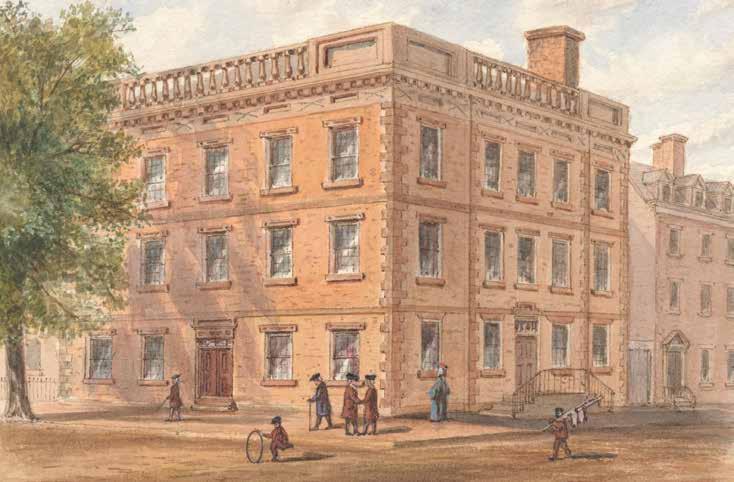
30 GETTY IMAGES
white house history quarterly
thereof in proper condition for the residence and use of the President of the United States.”19 The Franklin House—described by the French minister the Comte de Moustier as a “humble dwelling”—was leased for £845 a year, with another £8,000 expended to upgrade the home.20 Coincidentally, Washington’s next-door neighbor, at No. 5 Cherry Street, would be John Hancock, himself a former presiding officer of the Confederation Congress.21
Congressional absenteeism had been the culprit in the delay to secure a residence for the incoming president. On March 4, 1789, the day appointed by the Confederation Congress for the start of the new government, only eight senators and thirteen representatives were present. A quorum finally emerged in the House on April 1, while five days later, the Senate achieved numbers sufficient to count the electoral votes cast for president.22 The next morning, Charles Thompson, secretary of Congress, set out for Mount Vernon to inform Washington of his election as president of the United States, which he did on the morning of April 14.23
Washington immediately prepared to leave for New York. Short of funds, he borrowed some £625 from neighbor Richard Conway to pay his travel expenses.24 All along the route people came out to witness Washington pass by. On April 23, 1789, Washington crossed the Hudson River on a large barge and was greeted by a committee composed of Governor George Clinton, Mayor James Duane, and officers of the city’s governing corporation. An elaborate parade of military officers, troops, elected officials, clergy, and citizens accompanied the president approximately one mile from the Battery to No. 3 Cherry Street.25
New York society paid particular attention to president’s new house. As Sarah Osgood Robinson, niece of Maria Osgood, wrote to her friend Kitty Wistar:
Uncle Walter’s house in Cherry Street was taken for him [Washington], and every room furnished in the most elegant manner. Aunt Osgood and Lady [Catherine Alexander] Duer had the whole management of it. I went the morning before the General’s arrival to look at it. The best of furniture in every room, and the greatest quantity of plate and china I ever saw; the whole of the first and second stories is papered, and the floors covered with the richest
kind of Turkey and Wilton carpets. . . . There is scarcely anything talked about now but General Washington and the Palace.26
Not content with the furnishings at the Franklin House, Washington expended some £400 for glass and queensware and purchased bedsteads, chairs, knife boxes, washstands, clothespresses, and dining, tea, breakfast, and card tables.27 The efforts paid off, for upon her subsequent arrival Martha Washington found the house “handsomely furnished all new for the General.”28
The “Palace” was occupied by members of the Washington family and an array of household staff. Two Custis grandchildren—Eleanor (“Nelly”) Parke and George Washington (“Wash”) Parke—lived there. So did Tobias Lear, Washington’s personal secretary who supervised four additional secretaries, among them Thomas Nelson, nephew Robert Lewis, and political aide Colonel David Humphreys. Steward Samuel Fraunces oversaw a staff of white servants, which included a coachman, porter, cook, valet de chambre, maids, footmen, and laundresses.29
The Washington household also included seven enslaved African Americans from Mount Vernon: William (“Billy”) Lee, Washington’s longtime valet and body servant; Christopher Sheels, Lee’s nephew and later a body servant; Austin and Giles, both footmen; Paris, a stable hand; Molly, nursemaid to the Washington grandchildren; and Oney Judge, who later became famous for escaping from the president.30 Thus the staff of twenty-six outnumbered the four family members in residence at the Franklin House. It would be a pattern that carried over to future executive residences.
Even prior to settling his household, Washington participated in the first Inaugural Ball, called a “Public Ball and Entertainment.” The event had been pushed back by a week to allow for the arrival of Martha Washington, but when it became known that she would be delayed longer than expected, the ball went forward on May 7. With nearly three hundred people attending, all eyes were on the president, who danced two cotillions and a minuet. A week later, the French Minister de Moustier hosted a ball of his own.31
After Martha Washington arrived in the capital, she arranged a schedule of social events, most notably levees, dinners, and “drawing rooms” held each Friday from 7:00 until 9:00 in the evening.
31
white house history quarterly
George Washington attended the functions, without sword or hat, as he was in his capacity as the husband of the hostess and not as president of the United States.32 For its part, Congress voted after a prolonged debate that Washington be addressed simply as “the President of the United States,” without an additional title.33
President Washington also instituted the custom of holding “state dinners” each Thursday afternoon at 4:00 p.m. The gathering included “from ten to twenty-two” guests in addition to the president’s official “family,” which besides relatives included his secretarial staff. The meal tended toward “roast beef, veal, lamb, turkey, duck and varieties of game,” with silver-framed table ornaments adorned by “chaste mythological statuettes.”34 Beyond these formal social events, Washington also opened the house to the public twice per week on Tuesdays and Fridays, between 2:00 and 3:00 in the afternoon.35
Congress concluded its first session on September 29, 1789, with a strong record of legislative accomplishments, among them the introduction of amendments to the Constitution and the passage of the Judiciary Act of 1789.36 Hoping to strengthen the bonds of Union, Washington toured the New England states from October 15 to November 13, thus establishing regular travel as another function of the presidency.37 Washington’s first year at the Franklin House had proven a success. With the start of the new congressional session in January 1790, however, he determined to seize the first opportunity to upgrade the “Palace.”
THE SECOND PRESIDENTIAL MANSION
Washington’s chance came when French Minister de Moustier returned home, vacating his “fine and commodious mansion” at No. 39 Broadway.38 Built in 1786–87, it was owned by the merchant Alexander Macomb, who gladly offered it to Washington at an annual rent of £2,500; while more expensive than the Franklin House, it was a story higher and featured a garden extending to the banks of the Hudson River. The larger dining room could seat between sixteen and twenty guests.39 All in all, the Macomb House, or the “Mansion House” as the building later became known, was considered the “finest private dwelling in the city” and conveniently located four blocks from Federal Hall.40
On February 23, 1790, Washington and his family relocated to the Macomb House.41 Upon
agreeing to rent the house, Washington had surveyed the existing furniture and purchased several pieces left behind by de Moustier, including a writing desk and chair.42 From there, he arranged for the construction of a twelve-stall stable to accommodate his team of horses.43 In this way, Washington established another precedent, that of expanding the presidential residence to suit the occupant’s needs.
Hopeful about its possible future as the nation’s capital, New York City prepared to construct a permanent residence for the president. On March 16, 1790, the state legislature established a building commission and subsequently provided funding of £8,000 to build a grand house on the site of Fort George on Broadway. Dubbed “Government House,” the red brick colonnaded two-story structure attributed to builder James Robinson notably featured a front portico composed of Ionic columns. Yet Government House was never to fulfill its original purpose as the president’s home. The building was demolished in 1815 to make way for houses, before eventually being replaced by the Alexander Hamilton U.S. Customs House on Bowling Green in 1912.44
From the Macomb House, Washington settled into the duties of the Presidency. He began to call upon individual officers of the cabinet for advice, including Thomas Jefferson, who had recently returned from France. He paid special attention to the military and diplomatic aspects of the position, monitoring the army’s efforts in the Ohio country, and signing the nation’s first treaty with representatives from the Creek Nation.45 Washington was thus learning the extent of his executive powers.
Meanwhile, Congress continued to debate the future location of the capital. The political currents were running strongly against New York, with many favoring a return to Philadelphia.46 Dr. Benjamin Rush echoed the sentiments of others when he declared: “I rejoice in the prospect of Congress leaving New York; it is a sink of political vice. . . . Do as you please, but tear Congress away from New York in any way .” 47 William Maclay, another Pennsylvanian, similarly decried “the Pompous People of New York.”48 In addition, numerous smaller cities around the nation clamored to become the capital.49
At the same time, Congress had reached an impasse over the issue of assuming the states’ Revolutionary War debts. But on or about June 20,
32 TO COME white house history quarterly
Thomas Jefferson arranged for a dinner between James Madison and Alexander Hamilton at his rented house on 57 Maiden Lane. There Madison and Hamilton ironed out what has been dubbed the “dinner table bargain.” In exchange for assuming federal debts, the capital would be permanently located along the Potomac River. The resulting Residence Act of 1790 was passed on July 16. A month later, on August 12, Congress adjourned at New York City for the last time; until the new capital was ready, Philadelphia was to serve as the seat of government.50
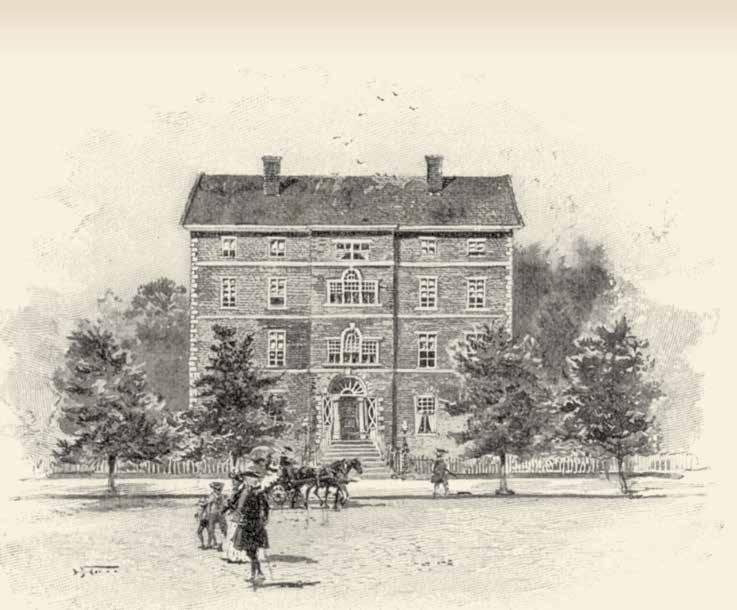
The people of New York were “disappointed and vexed at the result.” A political cartoon blasted Pennsylvania delegate Robert Morris’s role in the
legislation. Perhaps not coincidentally, Washington occupied Morris’s Philadelphia mansion upon his arrival in the city.51 But the capital would not remain in Philadelphia for long, destined as it was for a new Federal District created on the banks of the Potomac River near Georgetown. On Saturday, November 1, 1800, President John Adams moved into the still unfinished White House. Two weeks later, on November 17, Congress met in Washington City for the first time.52 The nation had entered a new chapter.
33 white house history quarterly
No. 39 Broadway, the second Presidential Mansion, was George Washington’s home from February 23, 1790, until August 1790, when the federal government relocated to Philadelphia.
THE FATE OF NEW YORK’S PRESIDENTIAL MANSIONS
What happened to the various buildings associated with President Washington’s time in the nation’s first capital? The Franklin House on Cherry Street transformed from a residence to a commercial property, remaining in the family’s hands until 1856 when it was demolished and replaced by stores. Benjamin R. Winthrop managed to obtain some of the original timbers for construction of what became known as “The Washington Chair,” now part of the collections of the New-York Historical Society.53 This subsequent building was demolished in the 1880s to make way for stone arches supporting the Brooklyn Bridge. A commemorative plaque provided by the Mary Washington Colonial Chapter of the Daughters of the American Revolution was installed on April 30, 1899. The plaque, which has itself become inaccessible and neglected, reads: “The First Presidential Mansion, No. 1 Cherry Street. Occupied by George Washington from April 23, 1789, to February 23, 1790.”54
The Macomb House has been similarly lost to time. In 1821 the building became a hotel, called Bunker’s Mansion House or Bunker’s Hotel, which operated for nearly three decades. The old house was apparently demolished to make way for
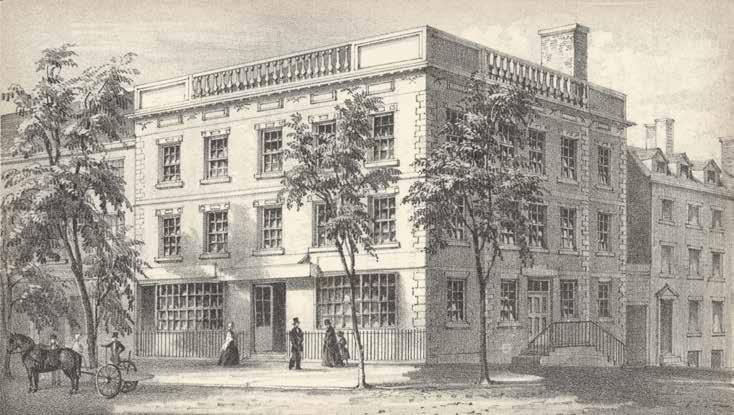
freestanding brownstone homes in the 1850s.55
The brownstones were subsequently demolished in the early 1900s to make way for a neoclassical commercial building, which was torn down to erect the thirty-eight- story Harriman Building in 1926. In 1939, the Daughters of the American Revolution placed a plaque at the building’s base, reading: “Site of Second Presidential Mansion occupied by General George Washington February 23 to August 30, 1790.”56
The first Presidential Mansion, seen above in 1853, was converted from a residence into a commercial building and later demolished and replaced with stores. The location, now under the Brooklyn Bridge, is remembered with a plaque placed on the supports of the bridge in 1899.

34 TOP: WHITE HOUSE HISTORICAL ASSOCIATION white house history quarterly
The second Presidential Mansion, Washington’s home on Broadway, was converted into a hotel in 1821. Illustrated below in 1831, it was demolished in the 1850s. Today the Harriman Building, which has occupied the site since 1939, displays a plaque placed by the Daughters of the American Revolution in 1939.


35 TOP: BRUCE WHITE FOR THE WHITE HOUSE HISTORICAL ASSOCIATION BOTTOM: NEW YORK PUBLIC LIBRARY white house history quarterly
THE LEGACY
The history of New York City’s time as the first seat of government is nearly all but forgotten, yet its capital legacy persists. Congress began to realize the full powers available to the new body. Through the passage of major legislation, Congress’s residence in New York demonstrated that it could cohere and was stronger than its predecessor. For the first time, it flexed the powers of the legislative branch of government that would in time shape the nation.
Similarly, George Washington’s year in New York City helped him in the ongoing process of inventing the presidency, both in its executive duties and symbolic functions. In New York, Washington established that the president should be regularly available to the public. Likewise, he set the precedent that a president should occasionally leave the capital to tour the country. Most significantly, Washington learned that the president’s residence should reflect the occupant’s place as the first citizen of a republican nation.
Despite fits and starts, the five and one-half year period when New York City was the capital set into motion great changes. There the old Confederation government ended, and the new federal government started. There Congress and the presidency both realized their real powers. And there, before the White House, stood the first two residential residences. Recalling New York’s capital legacy, then, reminds us of where the new American nation first took shape.
notes
1. For accounts of the events of April 30, 1789, see variously Stephen H. Browne, The First Inauguration: George Washington and the Invention of the Republic (Philadelphia: University of Pennsylvania Press, 2020), 107–66; Ron Chernow, Washington: A Life (New York: Penguin, 2010), 565–71; Louise Durbin, Inaugural Cavalcade (New York: Dodd, Mead, 1971), 1–9; Frank Monaghan and Marvin Lowenthal, This Was New York: The Nation’s Capital in 1789 (Garden City, N.Y.: Doubleday, Doran, 1943), 262–83; William Loring Andrews, New York As Washington Knew It After the Revolution (New York: Charles Scribner’s Sons, 1905), 45.
2. Robert Fortenbaugh, The Nine Capitals of the United States (York, Pa.: Maple Press, 1973).
3. Kenneth R. Bowling, The Creation of Washington, D.C.: The Idea and Location of the American Capital (Fairfax, Va.: George Mason University Press, 1991), 22–73; Bowling, “‘A Place to Which Tribute Is Brought’: The Contest for the Federal Capital in 1783,” Prologue: The Journal of the National Archives 8, no. 3 (Fall 1976): 129–40.
4. On New York’s wartime experience, see Edwin G. Burrow and Mike L. Wallace, Gotham: A History of New York City to 1898 (New York: Oxford University Press, 1999), 245–61; Bowling, Creation of Washington, D.C., 67. On the tradition of celebrating Evacuation Day, see Cornelius J. Foley, “History of the Celebration of Evacuation Day in New York City” (BA thesis, Queens College, 1967); Robert Goler, A Toast to Freedom: New
York Celebrates Evacuation Day (New York: Fraunces Tavern Museum, 1984). On New York’s population in 1790, see Robert I. Goler, “A Traveler’s Guide to Federal New York: Visual and Historical Perspectives,” in Federal New York: A Symposium, ed. Robert I. Goler (New York: Fraunces Tavern Museum, 1990), 7.
5. Bowling, Creation of Washington, D.C., 43–63.
6. Ibid., 64. For the deliberations, see the minutes of December 23, 1784, in Journals of the Continental Congress, 1774–1789, ed. Worthington C. Ford, Gaillard Hunt, John C. Fitzpatrick, and Roscoe R. Hill (Washington, D.C.: Government Printing Office, 1904–37), 27: 699–704.
7. Peter S. Onuf, Statehood and Union: A History of the Northwest Ordinance (South Bend, Ind.: University of Notre Dame Press, 2019), 79–101.
8. Bowling, Creation of Washington, D.C., 74–105, quotation on p. 96.
9. Harold T. Pinkett, “New York as the Temporary National Capital, 1875–1790: The Archival Heritage,” National Archives Accessions, no. 60 (December 1967): 1–12, esp. p. 7.
10. Bowling, Creation of Washington, D.C., 104; Charles Bangs Bickford and Kenneth R. Bowling, Birth of the Nation: The First Federal Congress, 1789–1791 (Madison, Wis.: Madison House, 1989), 10; Monaghan and Lowenthal, This Was New York, 255.
11. Kenneth R. Bowling, “New York City: Capital of the United States, 1785–1790,” in World of the Founders: New York Communities in the Federal Period, ed. Stephen L. Schechter and Wendell Trip (Albany: State University of New York Press, 1990), 1–23.
12. Pinkett, “New York as the Temporary National Capital,” 1–4.
13. Thomas E. V. Smith, The City of New York in the Year of Washington’s Inauguration, 1789 (New York: Anson D. F. Randolph, 1889), 40–44.
14. Quoted in Fergus M. Bordewich, The First Congress: How James Madison, George Washington, and a Group of Extraordinary Men Invented the Government (New York: Simon & Schuster, 2016), 3. On the transformation of Federal Hall, see Fergus M. Bordewich, Washington: The Making of the American Capital (New York: Amistad, 2008), 11–13; Kenneth R. Bowling, Peter Charles L’Enfant: Vision, Honor and Male Friendship in the Early American Republic (Washington, D.C.: George Washington Libraries, 2002), 14–18.
15. Bowling, “New York City: Capital of the United States,” 8–13.
16. On the occupancy of past presidents of the Confederation Congress at No. 3 Cherry Street, see William A. Duer, Reminiscences of an Old Yorker (New York: W. L. Andrew, 1867), 68; Lila Herbert, The First American: His Homes and His Households (New York: Harper & Brothers, 1900), 86. See also Thomas P. Chorlton, The First American Republic, 1774–1789: The First Fourteen American Presidents (Bloomington, Ind.: Author House, 2012), 422. The numbering system used for Cherry Street also changed through the years, with the confusing result that the house originally at No. 3 Cherry Street has variously been labeled as No. 1 and No. 9.
17. For a description of the house, see Henry B. Hoffman, “President Washington’s Cherry Street Residence,” New-York Historical Society Quarterly Bulletin 23, no. 3 (July 1939): 90–102. On the name change to Franklin Square, see Andrews, New York As Washington Knew It, 59.
18. George Washington to George Clinton, March 25, 1789, Papers of George Washington, Presidential Series, ed. W. W. Abbott, Dorothy Twohig, et al. (Charlottesville: University of Virginia Press, 1983– ), 1:443–44; George Washington to James Madison, March 30, 1789, ibid., 1:464–65.
19. Annals of Congress, 1st Cong., 1st sess., 19–20.
20. On the bill presented to Congress by Osgood, see the detailed accounts in the Samuel Osgood Papers, 1775–1812, New-York Historical Society, New York, and for reactions, see William Maclay, journal, September 26, 1789, Journal of William Maclay: United States Senator from Pennsylvania, 1789–1791, ed. Edgar S. Maclay (New York: D. Appleton, 1890), 166. For the description of the house as a “humble dwelling,” see Herbert, First American, 45.
36 white house history quarterly
21. Walter Barrett, The Old Merchants of New York (New York: Carleton, 1862), 300.
22. Charlene Bangs Bickford, “‘Public Attention Is Very Much Fixed on the Proceedings of the New Congress’: The First Federal Congress Organizes Itself,” in Inventing Congress: Origins and Establishment of the First Federal Congress, ed. Kenneth R. Bowling and Donald R. Kennon (Athens: Ohio University Press, 1999), 139, 141, 159–60.
23. Smith, City of New York, 214–18.
24. George Washington to Richard Conway, March 6, 1789, Papers of George Washington, Presidential Series, ed. Abbott, Twohig, et al., 1:368–69.
25. On Washington’s journey to and arrival in New York, see Bickford and Bowling, Birth of the Nation, 25; Monaghan and Lowenthal, This Was New York, 259-60; “An ‘August Spectacle,” Federal Gazette, and Philadelphia Evening Post, April 20, 1789, in A Great and Good Man: George Washington in the Eyes of His Contemporaries, ed. John P. Kaminski and Jill Adair McCaughan (Madison, Wis.: Madison House, 1989), 104–05.
26. Sarah Robinson to Kitty F. Wistar, April 30, 1789, in James G. Wilson, The Memorial History of the City of New-York: From Its First Settlement to the Year 1892 (New York: New-York History Company, 1893), 3:52. The term “Presidential Palace” was later used by Pierre Charles L’Enfant, among others, to describe what became the White House. Russell L. Mahan, “Political Architecture: The Building of the President’s House,” in A Social History of the First Family and the President’s House, ed. Robert P. Watson (Albany: State University of New York Press, 2004), 39–40.
27. John Riley, “Rules of Engagement: Ceremony and the First Presidential Household,” White House History, no. 6 (Fall 1999): 14–25, esp. p. 17.
28. Martha Washington to Fanny Bassett Washington, June 8, 1789, in Stephen Decatur Jr., Private Affairs of George Washington: From the Records and Accounts of Tobias Lear, Esquire, His Secretary (Boston: Houghton Mifflin, 1933), 21. See also Joseph E. Fields, ed., Worthy Partner: The Papers of Martha Washington (Westport, Conn.: Greenwood Press, 1994), 215–16.
29. For George Washington Parke Custis’s recollections of the house at Cherry Street, see Recollections and Private Memoirs of Washington by His Adopted Son, George Washington Parke Custis, ed. Benson Lossing (New York: Derby & Jackson, 1860), 394–432; and Custis’s earlier account in “The Birth-day of Washington,” Washington Daily National Intelligencer, February 22, 1847. See also John Riley, “The First Family in New York,” Mount Vernon Ladies’ Association Annual Report (1989): 19–21; Riley, “Rules of Engagement,” 18.
30. Jesse J. Holland, The Invisibles: The Untold Story of African American Slaves in the White House (Guilford, Conn.: Lyons Press, 2016), 11–37; Erica Armstrong Dunbar, Never Caught: The Washingtons’ Relentless Pursuit of Their Runaway Slave, Ona Judge (New York: Atria, 2017), 17–48. The enslaved people who accompanied the president in public were outfitted in livery consisting of a three-piece suit with stitching depicting Washington’s coat of arms.
31. Andrews, New York As Washington Knew It, 46–50.
32. Herbert, First American, 54–55.
33. Bickford, “‘Public Attention Is Very Much Fixed,” 162.
34. Herbert, First American, 48–51.
35. Jared Sparks, The Life of George Washington (Boston: Ferdinand Andrews, 1839), 413.
36. Bordewich, First Congress, 12–14.
37. T. H. Breen, George Washington’s Journey (New York: Simon & Schuster, 2016), 159–206.
38. Andrews, New York As Washington Knew It, 59–60.
39. On the Macomb House, see Agnes Miller, “The Macomb House: Presidential Mansion,” Michigan History 37 (December 1953): 373–84. On the larger dining room, see Decatur, Private Affairs of George Washington, 126. Decatur placed the rent at $1,000 (p. 147).
40. Herbert, First American, 62.
41. George Washington, diary, February 23, 1790, Diaries of George Washington, ed. Donald Jackson and Dorothy Twohig (Charlottesville: University Press of Virginia, 1976–79), 6:37.
42. For the full inventory of items purchased, see “Invoice: Articles Purchased by the President of the United States from Monsr. Le
Prince Agent for the Count de Moustiers, 1790 March,” George Washington Collection, Fred W. Smith National Library for the Study of George Washington, Mount Vernon, Va.
43. George Washington, diary, February 3, 1790, in Diaries of George Washington, ed. Jackson and Twohig, 6:27–28.
44. For the legislation establishing Government House, see the entries for March 16, 1790, in New York Senate and Assembly, Journals (New York: State of New York, 1790). For the description of Government House, see John Drayton, Letters Written During a Tour Through the Northern and Eastern States (Charleston, S.C.: Harrison and Bowen, 1794), 83. See also William Seale, “Where the Chief Was Never Hailed: Rivals to the White House in 18th-Century New York and Philadelphia,” White House History, no. 6 (Fall 1999): 26–33. On the design and subsequent fate of Government House, see Damie Stillman, “Six Houses for the President,” Pennsylvania Magazine of History and Biography 129, no. 4 (October 2005): 411–31; Donald Martin Reynolds, The Architecture of New York City: Histories and Views of Important Structures, Sites, and Symbols (Revised Edition) (New York: John Wiley & Sons, 1994), 252–64.
45. Lindsay M. Chervinsky, The Cabinet: George Washington and the Creation of an American Institution (Cambridge: Harvard University Press, 2020), 126–62; J. Leitch Wright Jr., “CreekAmerican Treaty of 1790: Alexander McGillivray and the Diplomacy of the Old Southwest,” Georgia Historical Quarterly, 51, no. 4 (December 1967): 379–400.
46. Bowling, Creation of Washington, D.C., 127–81.
47. Benjamin Rush to Peter Muhlenberg, c. 1790, quoted in Henry A. Muhlenberg, The Life of Major-General Peter Muhlenberg: Of the Revolutionary Army (Philadelphia: Carey & Hart, 1849), 319–20.
48. William Maclay, diary, June 11, 1789, The Diary of William Maclay and Other Notes on Senate Debate, March 4, 1789–March 3, 1791, ed. Kenneth R. Bowling and Helen E. Veit (Baltimore: Johns Hopkins University Press, 1988), 74.
49. Kenneth R. Bowling, “Neither in a Wigwam Nor the Wilderness: Competitors for the Federal City, 1787–1790,” Prologue: Quarterly of the National Archives 20, no. 3 (Fall 1988): 143–62.
50. On the events of the summer of 1790, see Bordewich, Washington, 31–52; Bowling, Creation of Washington, D.C., 182–207; Kenneth R. Bowling, Politics in the First Congress, 1789–1791 (New York: Garland Publishing, 1990).
51. Griswold, Republican Court, (New York: D. Appleton and Company, 1868), 234–38 (quoted 234). On Washington’s residence in Philadelphia, see Edward Lawler Jr., “The President’s House in Philadelphia: The Rediscovery of a Lost Landmark,” Pennsylvania Magazine of History and Biography 126, no. 1 (January 2002): 5–95.
52. William Seale, The President’s House: A History, 2nd ed. (Washington, D.C.: White House Historical Association, 2008), 1:38–79.
53. On “The Washington Chair,” see Benjamin R. Winthrop, The Washington Chair Presented to the New York Historical Society (New York: Charles B. Richardson, 1857). On the demolition of the Walter Franklin House, see the account in “The First Presidential Residence,” Frank Leslie’s Illustrated Newspaper, June 7, 1856, 413–14.
54. On the installation of and subsequent fate of the plaque, see “A Historic Home Marked,” New York Times, May 2, 1899; Bernard Stamler, “Marking ‘White House’ No. 1,” New York Times, November 1, 1998. See also Matt Green, “Street Scenes: A New York Pedestrian’s Chance Encounters with Presidential History,” in this issue.
55. D. T. Valentine, Manual of the Corporation of the City of New York for 1855 (New York: McSpedon & Baker, 1855), 582–83; Cromwell Childe, Old New York Downtown (privately printed, 1901), 19.
56. For the history of the site at 39 Broadway, see Molly Rockwold, “Architectural Review of 35–39 Broadway/11–15 Trinity Place: The Harriman Building” (unpublished paper, May 2016), 1–14. On the plaque, see Miller, “Macomb House,” 384.
37 white house history quarterly

The New York City DEATH AND BURIAL OF President James Monroe
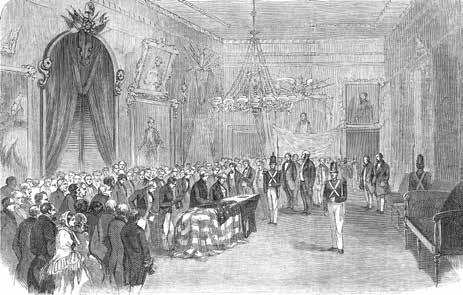 SCOTT HARRIS
SCOTT HARRIS
39 OPPOSITE: BRUCE WHITE FOR THE WHITE HOUSE HISTORICAL ASSOCIATION TOP: WHITE HOUSE HISTORICAL ASSOCIATION white house history quarterly
james monroe undertook many long and eventful journeys throughout his seventy-three-year life. He crisscrossed the north ern colonies from 1775 to 1778 with the Continental Army during the Revolutionary War. While serving as a Virginia delegate to the Confederation Congress from 1783 to 1786, he explored largely unsettled frontier territory in the Old Northwest. He made two round trips across the Atlantic in the 1790s and early 1800s for diplomatic assignments in France, Great Britain, and Spain. As president of the United States, Monroe undertook three extensive tours of the country: to northern states in 1817, the Chesapeake region in 1818, and the South in 1819.
After traveling far and wide in life, James Monroe continued his odyssey in death—first on a brief and somewhat confusing shuttle between two New York City cemeteries with almost identical names, and finally back to Richmond, the capital of his native state, Virginia. Monroe’s postmortem journeys occurred within an atmosphere of public veneration tinged with commercial and political exploitation.
MONROE’S NEW YORK BURIALS
Monroe died on July 4, 1831, in the home of his daughter, Maria, and her husband, Samuel Gouverneur, at 63 Prince Street in Manhattan. He had moved there after the death the previous year of his wife, Elizabeth Kortright Monroe. Still grieving that loss, he had also endured intense pain from a persistent cough that may have been a symp tom of tuberculosis. 1 Monroe’s long time friend and political associate Tench Ringgold informed James Madison of Monroe’s death in letters written on July 4 and July 7, 1831— the latter being the day of Monroe’s funeral:
I gave you, on the 4th instant, a short account
of the death of your old and valued friend Mr Monroe; and now perform the promise, then made, to write to you again before I left this City. . . .
For many weeks before his death, he was convinced it was impossible for him to recover, & he repeatedly exprest the most ardent wish to die; when the event approached he met it, calm and resigned.2
As the third former president of the United States to die on Independence Day (after John Adams and Thomas Jefferson in 1826), Monroe inspired a funeral that was one of the largest public events in New York City up to that time. One newspaper estimated the procession to be “more than two miles in length. . . . Every street through which the procession moved, was lined with people, the windows and housetops were crowded with every sex and age, spectators of the solemn scene.”3 Udolpho Wolfe, a New York businessman whose father served with Monroe in the Revolutionary War, later published this account:
The interment of President Monroe’s remains in the Second Street Cemetery, took place on the 7th of July, 1831, and was one of the most imposing ceremonies ever witnessed in New-York. The announcement of his death was appropriately noticed by the various legislative, literary, commercial, and judicial bodies in New-York, who universally passed resolutions expressive of their high respect for the deceased, and in favor of attending the funeral. The body was taken by a guard of honor from the residence of his son-inlaw, Samuel L. Gouverneur, accompanied by his near relatives and friends, and deposited on a platform which was erected for the occasion, and draped with black cloth, in front of the City Hall, where President Duer, of
left Artist Chester Harding captured this likeness of James Monore near the end of his life in 1829. After his death in 1831, the mask below was made by New York artist John Henri Isaac Browere. The mask is now in the collection of the Fenimore Art Museum.

previous spread Marble markers embedded in a stone wall identify vault owners in the New York Marble Cemetery where President James Monroe was briefly interred after his death in 1831. He was soon reinterred in the nearby New York City Marble Cemetery. In 1858 he was exhumed and laid in state in City Hall, a scene captured by a Harper’s Weekly artist, before a final entombment in Richmond, Virginia.

40 PORTRAIT: GETTY IMAGES / MASK: FENIMORE ART MUSEUM white house history quarterly
My
Dear Sir
President Monroe was living in the New York home of his daughter Maria and her husband, Samuel Gouverneur, when he died, July 4, 1831. The house at 63 Prince Street (seen top left in the 1820s and below c. 1900) was embellished with an historical plaque by the Women’s Auxillary of the American Scenic and Historic Preservation Society in 1905. Although efforts were made to preserve the house, it fell into decay and was eventually demolished.


David

41 TOP LEFT: WHITE HOUSE HISTORICAL ASSOCIATION / TOP RIGHT AND BOTTOM: ALAMY white house history quarterly
can you improve? Remove Shadow? TK
Columbia College . . . delivered an appropriate address. The body was from thence taken to St. Paul’s Church, the pulpit and reading desk of which were clad in mourning, where the solemn service of the Episcopal Church was read by the Rev. Bishop Onderdonk and Dr. Wainwright.4
The reference to “the Second Street Cemetery” in Wolfe’s account could describe either of two burying places in New York City that are bordered by the street so named. Both were in business in 1831. They were developed and promoted by the same local businessman and have almost identical names: the New York Marble Cemetery and the New York City Marble Cemetery. Each temporarily housed the remains of James Monroe.
The New York Marble Cemetery was incorporated on February 4, 1831, though site development and burials began late in 1830. Located at 41 1/2 Second Avenue and developed by businessman Perkins Nichols, it was the first public, nonsectarian burial place in the city. The cemetery proved so popular that Nichols founded another one in the summer of the same year (though it was not formally incorporated until April 26, 1832). This was the New York City Marble Cemetery, located across Second Avenue from the first graveyard, and additionally bounded by Second and Third Streets and First Avenue. Although there are many similarities between the two, they have always operated independently. Both cemeteries were at that time on the northern edge of development in lower Manhattan, in an area which already contained several church cemeteries.5
On July 23, 1831, the Baltimore newspaper Niles’ Weekly Register published a lengthy account of Monroe’s funeral that included the order of the procession from St. Paul’s Chapel and the route taken by the procession to the cemetery (or, cemeteries):

The procession moved up Broadway to Bleecker street, the military forming in line on each side of Bleecker and Second streets, while the different public bodies and societies marched through and entered the cemetery. The body was then deposited in the vault assigned to it on the north east end. The troops fired three rounds after the body had been lowered, and the procession moved out of the cemetery in the same order in which they entered.6
An excerpt from a lengthy account in the July 1831 Niles’ Register details the participants in James Monroe’s funeral procession, as well as the route taken. According to this report, the hearse progressed up Broadway to Bleeker Street to the cemetery where the body was deposited in the “vault assigned to it.”
42 WHITE HOUSE HISTORICAL ASSOCIATION white house history quarterly
Two cemeteries on Second Avenue are seen on the route of the Monroe Funeral procession (traced in yellow) on this 1833 map of Manhattan. From St. Paul’s Chapel, the procession moved north on Broadway, turned east on Bleeker Street and continued on Second Avenue. New York Marble Cemetery (outlined in blue) was the likely a short-term resting place for Monroe’s remains. New York City Marble Cemetery (oulined in red) just one block farther east, would hold Monroe’s remains for twentyseven years.

As the procession passed by the troops in formation, it would have encountered the older New York Marble Cemetery first, and beyond that the New York City Marble Cemetery, then under construction. The account says that Monroe’s body was “deposited in the vault assigned to it on the north east end,” but does not say which cemetery.
The New York Marble Cemetery’s record of burials says the following: “Monroe, James. 07 Jul 1831 b 1758. Removed to NYCMC.”7 “NYCMC” is the New York City Marble Cemetery. That cemetery’s records say the following: “Vault #147 Monroe, James. Interred: 7 Jul 1831. Removed: 2 Jul 1858.”8 Why were the remains of James Monroe apparently interred in two different cemeteries on the day of his funeral? The answer to this question may be found by examining excerpts from stories about the event that appeared in two other newspapers.
On July 16, 1831, the Charleston (S.C.) Daily Courier reprinted an account of the funeral from the New York Mercantile Advertiser of July 8. The story noted the arrangements for interring the body:
The place assigned to deposit the body, was the new Marble Cemetery of Perkins Nichols, Esqr. on Second-street, between the 1st and 2d Avenues; there, in a vault especially
appropriated by the owner for that purpose, the remains of James Monroe were deposited at 7 o’clock. The Artillery and Infantry fired three vollies over the hallowed spot, when the troops, citizens and societies left the ground under direction of the Grand Marshal.9
The location of the “new marble cemetery of Perkins Nichols, Esqr.” aligns with that of the New York City Marble Cemetery. It also implies that the body was placed in a vault there. However, a story in the New York Herald published on May 2, 1858, (when preparations were under way to relocate Monroe’s remains to Virginia) describes a somewhat different sequence of events:
The body was first interred in the old New York Marble Cemetery, founded by Mr. Norris, who allowed it to be placed in his private vault for a time whilst the New York City Marble Cemetery, in which the remains now repose, and in which the Gouverneur family had a vault building, was being constructed. The President shares his grave with Thomas Tillotson, so that the fifth President of the United States has had as yet no tomb of his own, and is even now resting in a vault upon which there is an unpaid assessment of many years standing. Verily, “republics are ungrateful.” 10
43 LIBRARY OF CONGRESS white house history quarterly
The reference to “Mr. Norris” as founder of the New York Marble Cemetery is a misnomer, as the actual founder was Perkins Nichols. Samuel Gouverneur, husband of James Monroe’s daughter Maria, is often identified as the owner of Vault 147 in the New York City Marble Cemetery. However, the cemetery’s records identify Robert Tillotson (the son of Thomas Tillotson) as the owner. Samuel Gouverneur may have leased space for his family members from Robert Tillotson, a common practice at the time.11
How can this confusion be explained Anne Brown, trustee emerita of the New York Marble Cemetery, shared in a conversation with the author her belief that Monroe’s body would have been placed in that cemetery’s Vault 51, which was owned by Perkins Nichols. Unlike other vaults, 51—and its companion vault, 52—were accessible by a permanent ladder, allowing for relatively easy placement and removal of remains. According to Anne Brown, Nichols had a reputation for accepting temporary burials in his vault, usually for a fee.12
The New York City Marble Cemetery website quotes the following from its New York City Landmarks Preservation Commission designation form, prepared in 1969:
The most important person buried in this cemetery was ex-President James Monroe, who had moved to New York in 1830, after the death of his wife, to live with his son-in-law, Samuel Gouverneur. Gouverneur owned a vault in the cemetery, and when Monroe died on July 4, 1831, he became one of the first to be buried here. The interment ceremonies were carried out with much pomp and military pageantry, which served to increase greatly the prestige of the cemetery.13
The phrase “which served to greatly increase the prestige of the cemetery” may offer another clue as to Perkins Nichols’s motivation for facilitating the various dispositions of President Monroe’s remains.
Examining the sundry accounts of James Monroe’s New York interments does not paint a precise, consistent picture of what happened to his remains on July 7, 1831, though the 1858 New York Herald story offers the most straightforward explanation: Monroe’s body was housed temporarily in the New York Marble Cemetery, in either the vault owned by Perkins Nichols or in another appropriated through his efforts. Since most accounts
of the funeral point to the procession concluding at the New York City Marble Cemetery, it seems likely that the body was brought there first and was moved to the other cemetery’s vault following the ceremony that same day. It remained there for an unknown number of days, or perhaps weeks, until the Tillotson / Gouverneur vault was ready for the transfer. The fact that records of both cemeteries show interment on July 7 could reflect the body’s progress through each or could be a clerical error.
Original records of the New York City Marble Cemetery covering the years 1831 to 1843 were

44 white house history quarterly BRUCE WHITE FOR THE WHITE HOUSE HISTORICAL ASSOCIATION
The gates to New York Marble Cemetery, where President Monroe was briefly interred in 1831, carry an historical marker identifying the site as the oldest public non-sectarian cemetery in New York.
The original owners of the 156 underground marble vaults in New York Marble Cemetery are named on the marble markers set in the stone wall that surrounds the perimeter of the small cemetery. No monuments are allowed on the ground above the underground vaults. The cemetery, now surrounded by tall buildings, is seen here in 2023.
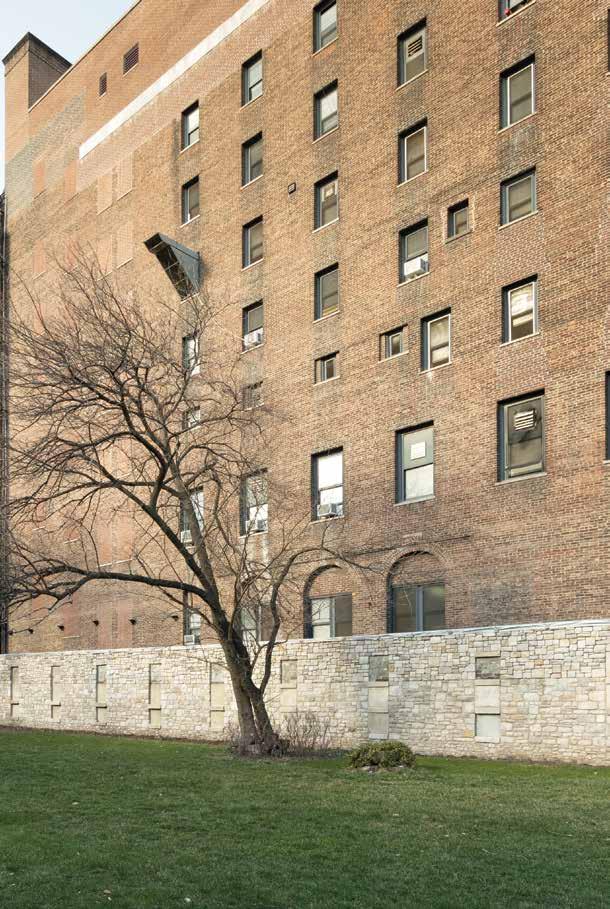
45 white house history quarterly BRUCE WHITE FOR THE WHITE HOUSE HISTORICAL ASSOCIATION
left and opposite Views of the New York City Marble cemetery, President Monroe’s second resting place, are seen here in 2023. Unlike New York Marble Cemetery, monuments are allowed on the ground here. Monore was interred in the Tillotson vault 147 (see blue outline on diagram below) from 1831 until 1858.

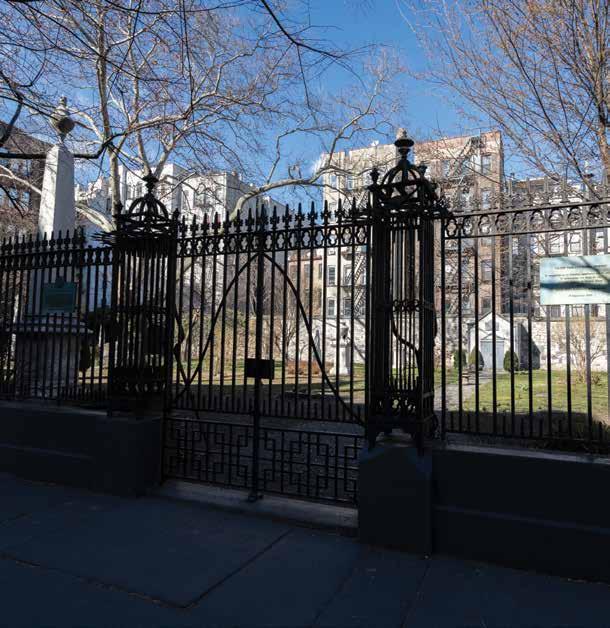
46
/ BOTTOM:
white house history quarterly
TOP: BRUCE WHITE FOR THE WHITE HOUSE HISTORICAL ASSOCIATION
NEW YORK CITY MARBLE CEMETERY
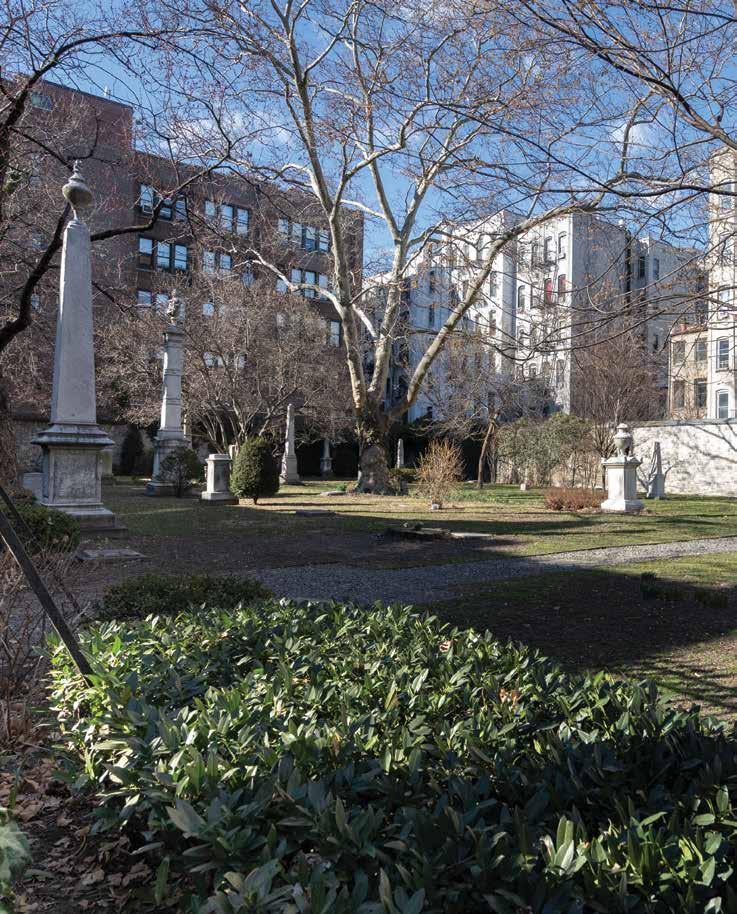
47 white house history quarterly BRUCE WHITE FOR THE WHITE HOUSE HISTORICAL ASSOCIATION
destroyed in a fire, though some of the information has been reconstructed from other sources. Inconsistencies in newspaper reporting regarding cemetery identification and vault location are not surprising, as conflating the names and locations of the two cemeteries has been a persistent problem even to the present day.14
MONROE’S RICHMOND BURIAL
James Monroe’s body remained in the New York City Marble Cemetery for just short of twenty-seven years before beginning a longer, final trek back to his native state. In 1858, the centennial anniversary of Monroe’s birth, Governor Henry Alexander Wise of Virginia formed a plan to relocate the former president’s remains from New York City for burial in one of three plots purchased by the Commonwealth in Richmond’s new Hollywood Cemetery. Wise also wanted to transfer the corpses of Thomas Jefferson and James Madison from their tombs at Monticello and Montpelier, respectively, to the other two plots. The first step was bringing Monroe home. The governor secured $2,000 from the General Assembly to purchase the three burial plots and initiated a contest for the design of Monroe’s tomb. 15
Why was Hollywood Cemetery chosen for this
honor? The 135-acre site outside of downtown Richmond was established in 1847 by a consortium of local businessmen. Designed by Scottish-born architect John Notman, Hollywood (named for the prevalence of that species of tree on the grounds) epitomized a trend in the United States during the mid-nineteenth century to create pastoral, aesthetically pleasing burial grounds that would be equally attractive as public parks. Placing Monroe’s tomb in Hollywood not only provided a fitting resting place for a revered former president; it also suited Wise’s goal of highlighting Virginia nationally to defuse the growing sectional crisis over slavery while enhancing the governor’s status as a potential presidential candidate. The tomb was also seen as a useful enticement for wealthy Richmonders to patronize the new cemetery.16
Governor Wise sent a delegation from Virginia to New York City to receive Monroe’s remains and convey them to their final resting place. On July 2, 1858, New Yorkers bade farewell to their distinguished guest of nearly three decades, as reported in the New York Times the following day:
Exhumation of the Remains of President Monroe
The July 17, 1858, edition of Harper’s Weekly included a series of illustrations documenting the relocation of President Monroe’s remains from New York City to Richmond, Virginia. In the first of four images, a small group gathers to witness the removal of Monroe’s casket from the vault in New York City Marble Cemetery.

48 WHITE HOUSE HISTORICAL ASSOCIATION white house history quarterly
Monroe’s casket was moved from the cemetery to City Hall where an estimated ten thousand people filed by to pay their respects to the fourth president of the United States before it was moved to the Jamestown to sail to Virginia. Monroe’s grandson, Samuel Gouverneur Jr., who was not at the event, commissioned this oil painting to include himself facing the foot of his grandfather’s coffin.

The remains of James Monroe, fifth President of the United States, which have lain twentyseven years in the Second Street Cemetery, in this City, were early yesterday morning disinterred, and taken quietly to the Church of the Annunciation, in Fourteenth street. There thirty-three pall-bearers, distinguished, and, for the most part, honorable citizens, took charge of them, and, marching down Broadway, attended by a large procession of civilians and the military, with solemn music, while all the bells were tolled, and, from our national vessels minute guns were fired, laid them in state in the City Hall, under the guard of the Eighth Regiment. This morning the remains will be borne to the steamer Jamestown, and surrendered to the keeping of a Committee of the Virginia Legislature, who are charged to bear them to the statesman’s native state, Virginia, for reinterment.17
An estimated ten thousand people filed by
Monroe’s casket in City Hall,18 recalling the honor shown by the citizenry twenty-seven years before, at his funeral. Frank Leslie’s Illustrated Newspaper, in its July 17 edition, pictured Monroe lying in state in City Hall. Monroe’s grandson, Samuel Gouverneur Jr. was serving as U.S. consul in Fuzhou, China at the time. Since he could not be present in New York, he commissioned an unknown Chinese artist to render an oil portrait of the scene, adding Gouverneur standing at the foot of the coffin.
The steamer Jamestown arrived in Richmond with Monroe’s remains on July 3, 1858. Two days later, the former president was interred in Hollywood Cemetery with full military honors. In 1859, James Monroe’s tomb was enclosed by a cast iron Gothic Revival tomb fabricated by Wood & Perot’s Ornamental Iron Works of Philadelphia.19
For 156 years, the iron canopy, popularly known as the “Birdcage,” endured the ravages of weather, the Civil War, and repeated repainting of the original buff-colored metalwork with layers of black paint. By 2015, the multiple paint layers not only obscured the fine details of the canopy; they also
49 white house history quarterly JAMES MONROE MUSEUM COLLECTION
Since 1858, President James Monroe’s remains have rested in Hollywood Cemetery in Richmond, Virginia. The grand cast iron Gothic Revival canopy enclosing the tomb, nicknamed the “Birdcage,” is seen here following an extensive restoration in 2017.
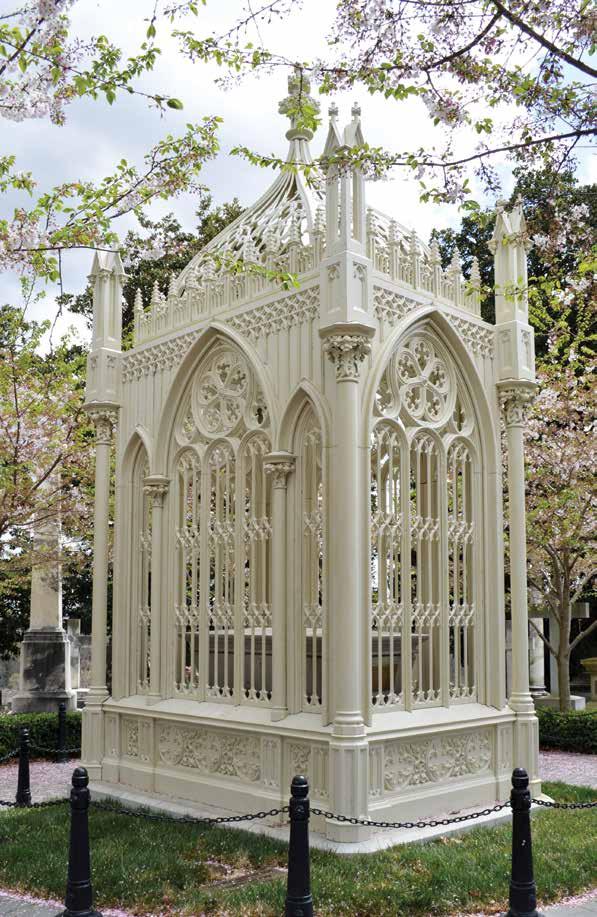
50
white house history quarterly JAMES MONROE MUSEUM COLLECTION
masked serious deterioration to the metal structure that threatened to bring the distinctive landmark crashing down. A two-year $1 million restoration by the Virginia Department of General Services took apart 618 individual cast-iron pieces comprising the canopy, 40 percent of which had to be recast. All 2,500 fasteners that had held the structure together since 1859 were replaced.20 The restoration made this symbol of mourning an elegant and inspiring celebration of life, transforming the final resting place of James Monroe from a “birdcage” into a cathedral.
notes
The author is grateful for the kind assistance of Caroline DuBois, President, and Anne Brown, Trustee Emerita, of the New York Marble Cemetery, and Colleen Iverson, Director of the New York City Marble Cemetery, in the preparation of this article. Their efforts, and those of many others, ensure that these historic sites are preserved and interpreted for the benefit of all. The author also thanks Heidi Stello, Associate Editor of the Papers of James Monroe, for invaluable research assistance.
1. John R. Bumgarner writes, “It is known that the illness lasted for several months and involved his lungs progressively. He had a harassing, exhausting cough, and suffered from fever and severe night sweats. His cough was productive of much mucous and at times gushes of blood. As the disease progressed, his breathing became more difficult. The clinical picture is highly suggestive but is not diagnostic of pulmonary tuberculosis. The Health of the Presidents: The 41 United States Presidents Through 1993 from a Physician’s Point of View (Jefferson, N.C.: MacFarland, 1994), 35. The register of burials at the New York Marble Cemetery for the period December 7, 1830, to July 15, 1831, lists the cause of Monroe’s death as “consumption,” the period term for tuberculosis. Negative photostatic image of burial register provided to author by Anne Brown, trustee emerita, New York Marble Cemetery, July 1, 2021.
2. Tench Ringgold to James Madison, July 7, 1831, online at Founders Online, https://founders.archives.gov.
3. “Funeral of James Monroe,” Charleston (S.C.) Daily Courier, July 16, 1831, reprinting an article from the New York Mercantile Advertiser, July 8, 1831, 2.
4. Udolpho Wolfe, Grand Civic and Military Demonstration in Honor of the Removal of the Remains of James Monroe, Fifth President of the United States, from New York to Virginia (New York: John A. Gray, 1858), 14.
5. “A Brief History of the New York Marble Cemetery,” New York Marble Cemetery website, https://marblecemetery.org.
6. “Death of James Monroe,” July 23, 1831, Niles’ Weekly Register, July 23, 1831, 371–72.
7. “New York Marble Cemetery Interments by Name,” New York Marble Cemetery website.
8. “New York City Marble Cemetery Interments Listed by Vault,” New York City Marble Cemetery website, www.nycmc.org.
9. “Funeral of James Monroe,” Charleston (S.C.) Daily Courier, July 16, 1831, 2.
10. “The Graves of the Presidents: The Tomb of Monroe,” New York Herald, May 2, 1858, 8.
11. Anne Brown, conversation with author, June 28, 2021. Robert Tillotson was New York’s secretary of state from 1816 to 1817, and U.S. attorney for the Southern District of New York from 1819 to 1828. His remains, and those of six other apparent family members, were removed from Vault 147 on November 9, 1894. Several of these, including Robert Tillotson, are buried in the Rhinebeck Cemetery, Rhinebeck, New York. Maria Monroe Gouverneur died on June 20, 1850, and is buried with her mother and father in Hollywood Cemetery, Richmond, Virginia.
Samuel L. Gouverneur died on September 29, 1865, and is buried at Saint Marks Apostolic Church Cemetery, Petersville, Maryland.
12. Ibid.
13. New York City Landmarks Preservation Commission, designation of New York City Marble Cemetery, March 4, 1969, available online at https://media.nyc.gov.
14. Colleen Iverson, director of the New York City Marble Cemetery, conversation with author, June 29, 2021. Mrs. Iverson was most helpful in explaining the efforts to reconstruct information from the cemetery’s early years.
15. Wise’s plans for relocating the remains of Jefferson, Madison, and Monroe are discussed in Louis J. Malon, “‘Then Will the Union Be Knit Indissolubly Together’: The Tomb for President James Monroe.” Athanor (Florida State University, Department of Art History) 21 (2003): 33–34. Wise was unsuccessful in his quest to bring the other two presidents to Hollywood Cemetery. The General Assembly’s appropriation is noted in the National Register of Historic Places Nomination Form, James Monroe Tomb, online at www.dhr.virginia.gov.
16. Malon, “Then Will the Union Be Knit,” 34. While Monroe was not joined by Jefferson and Madison in Hollywood, former U.S. president John Tyler was later buried there. Confederate president Jefferson Davis, and thousands of southern Civil War casualties and veterans, were also interred in Hollywood, which prospered financially. For an in-depth treatment of the subject of rural cemeteries, see Jeffrey Smith, The Rural Cemetery Movement: Places of Paradox in Nineteenth-Century America (Lanham, Md.: Lexington Books, 2017).
17. “Exhumation of the Remains of President Monroe,” New York Times, July 3, 1858, 5.
18. Wolfe, Grand Civic and Military Demonstration, 80. “About three o’clock, permission was granted for the citizens assembled to enter and view the coffin, and it was calculated that about ten thousand persons, exclusive of boys and girls of all ages, availed themselves of this privilege.”
19. “News of the Week: Wednesday, November 18,” Christian Advocate, November 26, 1903, 1942 (46). A final coda came in 1903, when the remains of Monroe’s wife, Elizabeth Kortright Monroe, and one of his daughters, Maria Hester Monroe Gouverneur, were removed from Leesburg, Virginia, and buried at his side. Monroe’s other daughter, Eliza Monroe Hay, died in Paris, France and is buried in that city’s Père Lachaise Cemetery.
20. Restoration of Monroe’s Beloved “Birdcage” Complete, published in A Gateway into History (Hollywood Cemetery newsletter), Spring 2017, Volume 7, Number 1. Moffitt, Kirsten, Finishes Analysis Report, Monroe Tomb: Select Fragments, February 28, 2016, report prepared for W.E. Bowman Construction. The author thanks Mr. Fred Garrett of Bowman, co-manager of the restoration project, for providing photographs and a copy of Ms. Moffitt’s report to the James Monroe Museum.
51 white house history quarterly
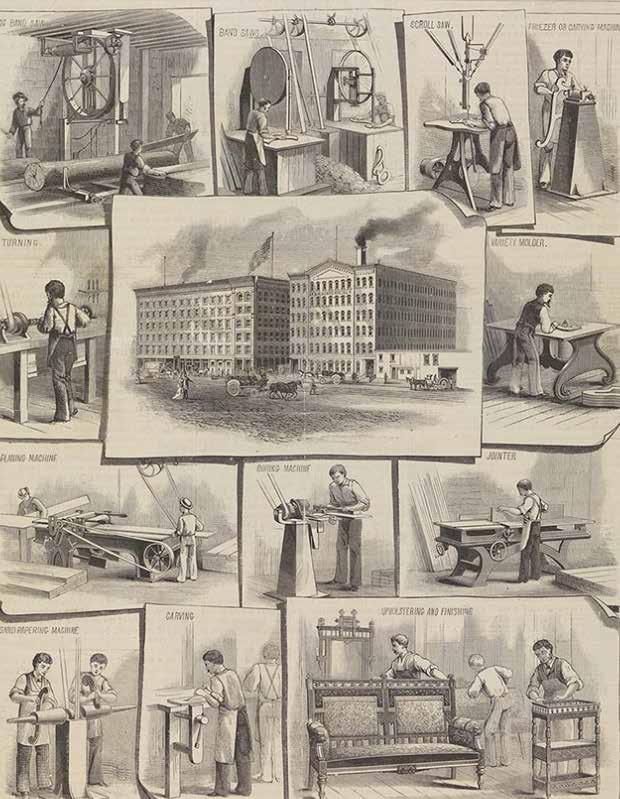
FPO TK
Made IN NEW YORK For the White House
WILLIAM G. ALLMAN
by the middle of the nineteenth century, New York City was wellestablished as the most populous city in the United States, with a powerful industrial and mercantile identity, producing or importing goods lauded as the newest and most stylish. In 1845, the White House came shopping at the manufacturers, merchants, and department stores that are credited with soon influencing the display of manufactured goods at the 1853 New York Crystal Palace, the first U.S. world’s fair, visited by President Franklin Pierce. The White House has been patronizing New York City ever since.1
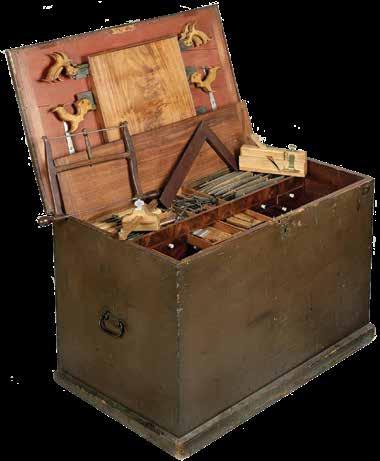
53 \ white house history quarterly
OPPOSITE: CREDIT TO COME / TOP: NEW YORK HISTORICAL SOCIETY
THE EARLIEST FURNISHINGS
the decorative arts that furnished the white house when it was first occupied in 1800 may have included items acquired for the initial presidential residences in New York City in 1789–90, if any of those furnishings had been moved to Philadelphia in 1790 and then on to the new permanent capital of Washington. Such New York City objects would, however, have been lost in the burning of the White House by the British in 1814. There is no evidence that either Thomas Jefferson or James and Dolley Madison shopped in New York in those pre-fire years, the heyday of such masterful cabinetmakers as Duncan Phyfe and Charles-Honoré Lannuier, now both featured in the White House Collection. With President James Monroe buying furnishings in Paris in 1817 and Andrew Jackson in Philadelphia in the 1830s, it was not until 1845 that the merchants and manufacturers of New York City became influential in the decorative arts of the White House.
George Washington occupied two houses in
New York City as the first president of the United States. His second, larger house on Broadway had been occupied by the recently recalled French minister to the United States, Elénor FrançoisElie, the Comte de Moustier, and Washington purchased many of his French furnishings. These included a large dinner service of gilt-edged white porcelain, much of which the Comte de Moustier had purchased circa 1788 from the Royal Porcelain Manufactory of Sèvres. Washington used the French china in the subsequent presidential house in Philadelphia, but as it was his personal property, he took it home at the end of his presidency in 1797. In 1919, shortly after First Lady Edith Wilson installed the White House China Collection in its current location in the China Room on the Ground Floor of the White House, a Sèvres sauce boat from the Moustier-Washington set was donated to the collection by Martha Washington’s great-greatgreat-granddaughter, thus bringing to the White House a decorative arts link with one of its New York predecessors.2
left
This Sèvres sauce boat (saucière), used by President George Washington at his second presidential house in New York, and later donated to the White House Collection, serves as a decorative arts link from White House to New York.
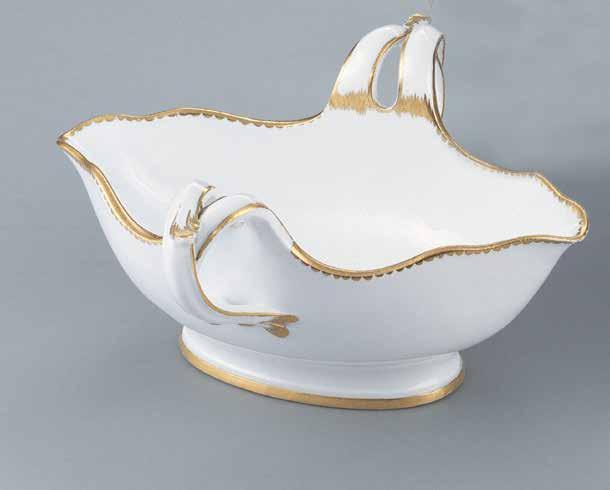
previous spread left
The cover of the October 9, 1880, Scientific American features an illustration entitled “The Manufacture of Parlor Furniture— Factory of M. & H. Schrenkeisen, New York City.”
A six story building at 23–29 Elizabeth Street, the Schrenkeisen factory housed one of the many furniture makers in New York at the time.
previous spread right
A mahogany and pine tool chest made by New York cabinetmaker Duncan Phyfe in c. 1790 houses more than four hundred of his tools. The chest, which descended in his family to his great-grandsons, has been on loan to the New-York Historical Society since 1927.
54
white house history quarterly
BRUCE WHITE FOR THE WHITE HOUSE HISTORICAL ASSOCIATION
top
A set of heartbacked chairs acquired for the White House during the presidency of James K. Polk are seen in use during the presidency of Ulysses S. Grant at a State Dinner for the Joint High Commissioners, March 9, 1871. Made of rosewood by the New York furniture maker Charles A. Baudouine, the chairs were upholstered in purple.
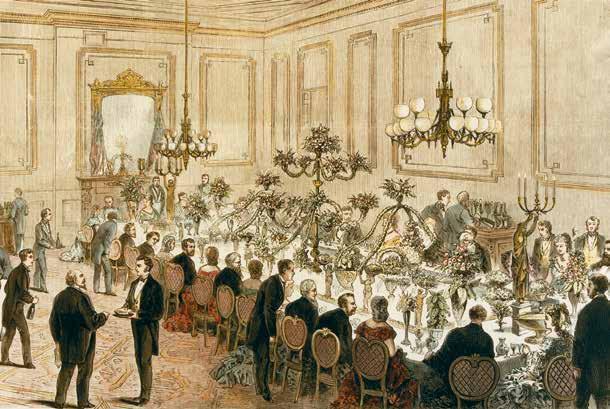
right
One of seventeen of the forty-two heart-back chairs remaining in the White House Collection today.

CHARLES A. BAUDOUINE DANIEL G. HATCH & COMPANY
In 1845, President and Mrs. James K. Polk called on Washington banker and art collector William Wilson Corcoran to be their agent for the funds allocated to a new president for the Executive Mansion. Corcoran looked to New York manufacturers and merchants to complete the task. In one example, in September 1845, furniture maker Charles A. Baudouine provided “42 Rosewood chairs in plush” for the State Dining Room; the upholstery was purple, as described by Elizabeth Dixon, wife of a Connecticut congressman.3 At that time, the dining room seated only thirty to forty guests at straight or H-shaped tables. A photograph of the Polk cabinet, taken in the State Dining Room in 1846—the first known photograph of a White House interior—shows the president seated in what appears to be one of these heart-shaped-back chairs. Although a new set of State Dining Room chairs from New York manufacturer Daniel G. Hatch & Company was acquired in 1883 during the Chester Arthur administration, none of that later enlarged set survived continuously in the White House, although one was reacquired in 1972. Seventeen of the graceful 1845 chairs, however, proved useful in the Private Quarters and remain in the collection.
55 TOP: LIBRARY OF CONGRESS / RIGHT: BRUCE WHITE FOR THE WHITE HOUSE HISTORICAL ASSOCIATION white house history quarterly
E. V. HAUGHWOUT & DAILEY
On July 14, 1853, President Franklin Pierce took part in the opening of the nation’s first world’s fair in New York City. Held in a “Crystal Palace” inspired by the London exposition of 1851, this “Exhibition of the Industries of All the Nations” placed special emphasis on American progress in science, art, and industry. In reporting on the fair, Horace Greeley, publisher of the NewYork Tribune, cited the 1852 partnership of Eder Vreeland Haughwout & William I. F. Dailey as having “established the art of decorating in this city” as demonstrated by a “very fine collection of decorated Porcelain.”4 Another publication was not so kind: “The designs are chiefly copies from works executed abroad, and present therefore no point worthy of particular remark. Two plates with the cypher of the President and the arms of the United States form part of a service for the use
of that functionary.”4An accompanying engraving (printed in reverse) shows plates of two patterns on which the enterprising Haughwout would nonetheless capitalize. While still in New York, the president ordered a 355-piece State Service, without the personalizing “P” initial suggested for the central shield decoration. The only piece to remain in the White House since 1853 is the “Centre Piece,” a tall stand ornamented with three female figures in unglazed porcelain. Similar figures on a basket purchased by Queen Victoria at the London Crystal Palace were described as representing Love, Peace, and Abundance. When retrieved from the White House attic by new First Lady Caroline Harrison in 1889, this centerpiece was attributed to Dolley Madison, but it has long been correctly identified as being from the service sold to President Pierce in New York.
far left
Decorated by Haughwout and Dailey for President Franklin Pierce in 1853, this porcelain centerpiece features three figures representing Love, Peace, and Abundance.

near left
Included in the 666-piece State Service purchased by First Lady Mary Todd Lincoln on an 1861 shopping trip to E. V. Haughwout & Company in New York, this dinner plate is decorated in her favorite “solferino” purple and embellished with the U. S. Coat of Arms.
Eight years later when First Lady Mary Todd Lincoln traveled to New York to shop, she visited the successor firm E. V. Haughwout & Company (at 488–92 Broadway, an extant building) and ordered a State Service based on the second of the plates illustrated in 1853. The U.S. Coat of Arms and Moorish tracery edge were retained, but the originally proposed blue decoration was changed to a purplish-red color called “solferino,” perhaps not so well known today as the color “magenta,” both named by the French for 1859 battles. In January 1866, the Andrew Johnson White House called on Haughwout to “replace the pieces broken and lost of the Solferine sett.” The 1861 order of 666 pieces had cost $3,195, the Johnson reorder of 343 pieces $2,061.5
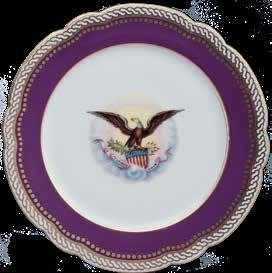
56 white house history quarterly
HAVILAND & CO.
Haviland & Company, the well-known French porcelain maker that provided some of the blanks for the Lincoln china was actually founded by a New Yorker, importer David Haviland. He moved to Limoges in 1842 to produce French ware decorated to the American taste and by 1853 had become the largest supplier to the United States. In 1872, through Washington, D.C., retailer J. W. Boteler & Brother, President and Mrs. Ulysses S. Grant ordered supplemental pieces for the Lincoln service from Haviland as well as a formal State Dinner service. Marked pieces from both purchases remain in the collection.

Haviland also produced the amazing Rutherford B. Hayes State Service. In 1879, after the firm had provided an initial quote, First Lady Lucy Webb
Hayes happened to meet Theodore R. Davis, artist and reporter for the New York–based publication Harper’s Weekly, in the White House Conservatory. They discussed the new china, and Davis suggested that a uniquely American service could be created if decorated with the native flora and fauna. With Mrs. Hayes’s approval, Davis went into seaside seclusion at Asbury Park, New Jersey, to create designs that included new forms and twelve different images for each of five types of plates. After contract negotiations, Haviland delivered the elaborate service in June and December 1880. To recoup some of the cost, the manufacturer was permitted to sell the designs to the public, with those pieces bearing an 1880 patent mark rather than the red, white, and blue “TD 1879” monogram found on the official service.
57 white house history quarterly ALL PHOTOGRAPHS THIS SPREAD: BRUCE WHITE FOR THE WHITE HOUSE HISTORICAL ASSOCIATION
right
Examples from the Haviland & Co. porcelain dinner service purchased by President and Mrs. Rutherford B. Hayes for the White House in 1880 feature flora and fauna designs based on watercolors by Theodore R. Davis.
Included in the furnishings purchased from the New York firm Pottier & Stymus Manufacturing Company by President and Mrs. Grant for the White House are the conference table (left) and the arm chairs (below), which remain in the White House Collection today. The table with eight lockable drawers has come to be known as the Treaty Table for the many peace treaties and agreements that have been signed on it.
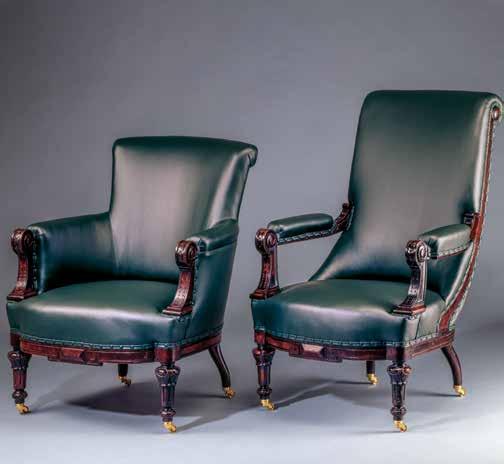

POTTIER & STYMUS MFG. CO.
The Grants also patronized two highly fashionable New York furniture and design firms. In 1869, the cabinet room on the Second Floor (the room to the west of the Lincoln cabinet room) was entrusted to Pottier & Stymus Manufacturing Company (founded in 1859 by Auguste Pottier and William P. Stymus Sr., with a showroom at 623 Broadway). Furnishings included a conference table, chairs, sofa, desk, overmantel mirror, and window cornices, all in dark-finished wood, as well as a white marble mantel and a chandelier and sconces. Remaining in the collection are the table, sofa, three armchairs, and a revolving desk chair. The table has become known as the “Treaty Table”; it was used when the Spanish-American Peace Protocol was signed in the cabinet room in 1898, but it has also been used for such treaty signings as the KelloggBriand Peace Pact in the East Room in 1929 and the Israel-Palestine Peace Accord on the South Lawn in 1993.
58 ALL PHOTOGRAPHS THIS SPREAD: BRUCE WHITE FOR THE WHITE HOUSE HISTORICAL ASSOCIATION white house history quarterly
In 1875, the Grants hired the Herter Brothers firm to furnish and decorate the Red Room. Two items from the thirteen? piece suite remain in the White House Collection today, a gilded lady’s chair (right) and a center table (below).

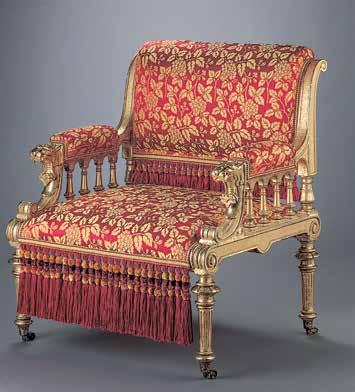
HERTER BROS.
In 1875, the prominent Herter Brothers firm, which had provided bedroom furniture in 1872, was hired by the Grants to redecorate the Red Room. Founded in 1864 by Gustave and Christian Herter, the company had become one of the first in the United States to provide a full range of decorative services with its own design, cabinetmaking, and upholstery workshops. The influence of Japanese arts in the decorative arts at that time was seen in some of the Red Room textiles specifically described as “Japanese”—draperies of satin damask and upholsteries of velvet and brocade. From a fourteen-piece suite of furniture, only two pieces—the labeled center table and one of a pair of gilded lady’s chairs— remain in the collection.
59 white house history quarterly
TIFFANY & COMPANY
The name Tiffany has many connections to the decorative arts of the White House. In 1853, Charles Lewis Tiffany took control of an emporium of which he was a founding partner, shortening the name to Tiffany & Company and focusing on jewelry and luxury goods. In 1880 the firm provided photographs and drawings to First Lady Lucy Hayes, who selected two pairs of gilded brass candelabra, probably made in Europe, for the State Dining Room. The purchase coincided with the arrival of the new Hayes State Dinner Service. In 1898, the firm was commissioned to make an elaborate silver presentation cup to be presented by President William
McKinley to the French ambassador Jules Cambon “in token of his friendly services in the negotiation of the Peace Protocol between the United States and Spain.”7 The protocol had been signed in the cabinet room on August 12, 1898, so, with this White House association, the three-handled cup, decorated with eagles and the seals of the United States, Spain, and France, was acquired for the collection in 1972 with donated funds. In 1966, when Tiffany & Company was producing many of the state gifts presented by President Lyndon Johnson to visiting dignitaries, the firm was entrusted with designing the Johnson State Service and contracting for its production by Castleton China in Pennsylvania; the names of

60 white house history quarterly
Made by Tiffany & Company in 1899, this silver presentation cup was commissioned by President William McKinley for the French ambassador in recognition of his role in the peace negotiations that ended the SpanishAmerican War.
both firms appear on this service for 216, received as an anonymous donation, the first service not purchased with appropriated funds.
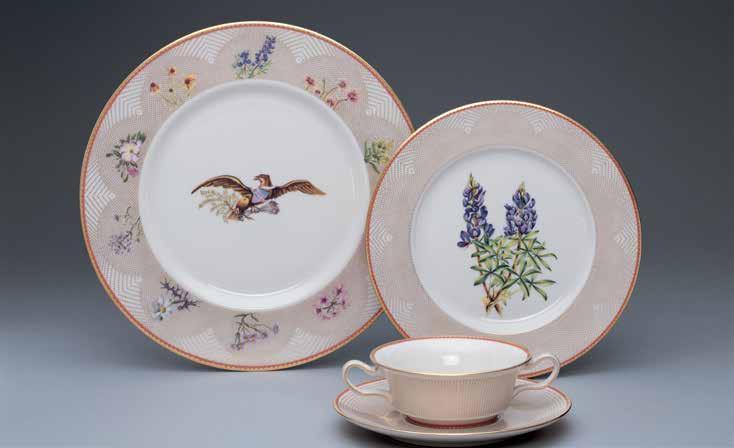
In 1882, the fashionable Arthur commissioned extensive decorative work in many of the State Rooms by Louis C. Tiffany & Company / Associated Artists, a brief partnership (1879–83) featuring Charles Tiffany’s son. Surviving elements from the Tiffany work include andirons and a fender from the Blue Room, porcelain vases from the Green Room and Red Room, and some table silver from Tiffany & Company, of which Louis would become design director in 1902. In 1927, Tiffany Studios provided First Lady Grace Coolidge with custom-made Aubusson-style rugs for the Green Room and Red Room, each featuring the Presidential Coat of Arms. These nearly one-hundred-year-old rugs remain in the collection; a design drawing for each was acquired in 1995 as gifts of the White House Historical Association.
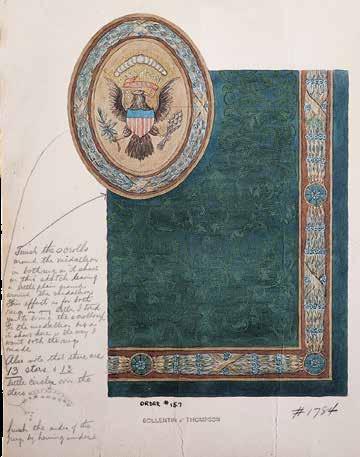
61 white house history quarterly ALL PHOTOGRAPHS THIS SPREAD: BRUCE WHITE FOR THE WHITE HOUSE HISTORICAL ASSOCIATION above
right
Designed by Tiffany & Company and produced by Castleton China, the Lyndon Baines Johnson State Service for 216 features floral designs.
The design drawing made for a Green Room Aubussonstyle rug in 1926 by Tiffany Studios .
MCKIM, MEAD AND WHITE
In 1902, President and Mrs. Theodore Roosevelt selected the renowned New York architectural firm of McKim, Mead and White for an extensive White Houses renovation, under the direction of partner Charles Follen McKim. This included structural and architectural changes to the public rooms on the State Floor and expansion of the Private Quarters with the removal of the presidential offices to a new West Wing. McKim selected the New York interior decorating firm L. Marcotte & Company (founded in 1849 by French brothers-in-law as Ringuet-LePrince & Marcotte, renamed in 1860 by Léon Marcotte, who died in 1887, and located at 298 Fifth Avenue since 1884) for the principal parlor, the Blue Room. The firm made the draperies and installed the dark blue wall cloth. It provided seat furniture, painted white with gold trim, consisting of a long sofa curved to fit the room’s oval shape and four matching armchairs—reminiscent of the seat furniture acquired for the room by the Monroes in 1817—and ten English
Hepplewhite–style shield-back side chairs. Marcotte also provided Louis XVI–style gilded console tables, benches, and window cornices for the East Room; the cornices and some of the benches remain in that room today.
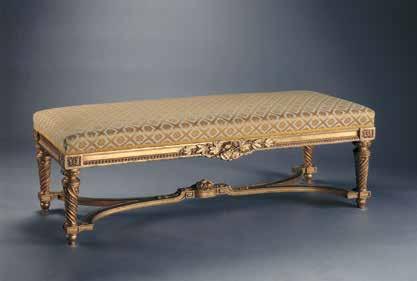
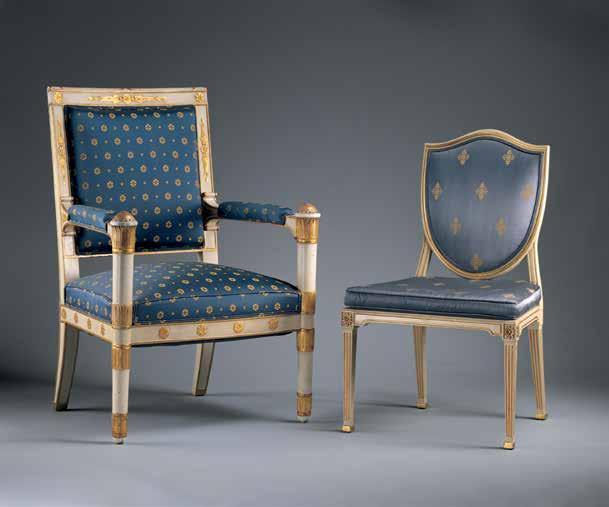
62 white house history quarterly
left An armchair and sidechair made for the Blue Room in 1902 by L. Marcotte & Company. below
One of a group of carved and gilded benches made for the East Room by L. Marcotte & Company.
Included in the collection of electric lighting fixtures made by Edward F. Caldwell & Company for the White House in 1902 are one of three Bohemian glass chandeliers (above) and one of four light standards made for the East Room.


EDWARD F. CALDWELL & CO.
McKim also patronized the New York firm of Edward F. Caldwell & Company (founded in 1895 by Caldwell and designer Victor von Lossberg, with its 1901 foundry, offices, and showroom at 36–40 West Fifteenth Street) for the manufacturing and installation of electrical lighting fixtures throughout the Residence and the new West Wing. Fixtures still in use include the chandeliers (shortened in 1952) and light standards in the East Room, the standards in the Entrance and Cross Halls (modified in 1961), and the silver-plated chandelier and sconces in the State Dining Room (gilded in 1961).
63 white house history quarterly ALL PHOTOGRAPHS THIS SPREAD: BRUCE WHITE FOR THE WHITE HOUSE HISTORICAL ASSOCIATION
STEINWAY & SONS
In 1902 Steinway & Sons (founded in Manhattan in 1853 by Heinrich E. Steinweg) was making pianos at a company town that son William had founded in what is now the Astoria neighborhood of Queens (One Steinway Place). Since 1897, the art case department had been led by Joseph Burr Tiffany, of the Tiffany & Company family. He is credited with converting a Roosevelt order for an upright into a magnificent grand piano, the company’s no. 100,000, which the firm gave to the White House on January 23, 1903. It was designed by Richard and Joseph Hunt, heirs to their famous architect father Richard Morris Hunt. Decoration of the case was entrusted to Thomas W. Dewing, who in 1898 was a founding member of the American Impressionist group known as The Ten American Painters. Dewing’s wife, Maria Oakey, who was also a fine artist and well versed in the decorative arts, probably had a hand in the decoration as well. The inside of the lid features the figure of America, shown in a dress of late eighteenth-century style, surrounded by the Nine Muses of the classical Greek arts. The sides of the gilded case feature the seals of the thirteen original states. The 1903 piano was replaced by another Steinway custom-designed grand piano, no. 300,000, presented by Theodore Steinway to President and Mrs. Franklin D. Roosevelt on December 10, 1938. Steinway and his staff collaborated with architect Eric Gugler, sculptor Albert Stewart, and artist Dunbar Dyson, to create a mahogany case supported by carved and gilded eagle legs and decorated with five gilt scenes of American music and dance. Long located in the East Room, this, the current White House formal piano, is now located in the Entrance Hall.

B. ALTMAN & COMPANY
In 1948, as the 150th anniversary of White House occupancy approached, an ongoing concern about the structure became an issue of safety, so President and Mrs. Harry S. Truman and their daughter Margaret moved into Blair House. In 1950, as the renovation of the structure’s interior was under way, Charles T. Haight, the director of the design department of New York department store, B. Altman & Company, began planning for the refurbishing, which was to include repairs to old furniture and the acquisition of some new furniture—principally for the Private Quarters—and wall coverings, draperies, and carpets throughout.
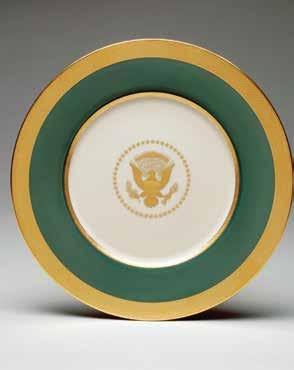
64
TOP:
BOTTOM: WILL
white house history quarterly
BRUCE WHITE FOR THE WHITE HOUSE HISTORICAL ASSOCIATION
BROWN?
above
The gilded grand piano made for the White House in 1903 by Steinway and Sons. left
The Truman State Service was one of many purchases made for the White House through New York department store B. Altman.
President and Mrs. Dwight Eisenhower accepted a gift of antique furnishings for the Diplomatic Reception Room from the National Society of Interior Designers in 1960. Chairs and tables were arranged on a custom-designed oval wool rug made by Edward Fields (the company founded in 1935, with its mill in Flushing). The border included emblems taken from the flags of the fifty states in
order of their admission to the Union. Fields provided successor rugs, with more elaborate designs but each with the use of historic state emblems—in 1971 as a gift of Fields and the NSID, in 1983 as a gift of the manufacturer. It also provided rugs for the Ground Floor Corridor, the Cross Hall, and Grand Staircase, as well as the first twentieth-century set of rugs for the East Room in 1995.

65 WHITE HOUSE HISTORICAL ASSOCIATION white house history quarterly
Carpet maker Edward Fields and his son Jack examine a carpet made for the Diplomatic Reception Room in 1971.
EDWARD FIELDS
TK
Made in New York

Below:



66 CLOCKWISE: BEYOND MY KEN, WIKIPEDIA / METROPOLITAN MUSEUM OF ART / CREDIT / WHITE HOUSE HISTORICAL ASSOCIATION white house history quarterly
Steinway & Sons’ pianoforte factory and lumber yard, occupied the full block on Fourth Avenue between 52nd and 53rd Streets from 1860 to 1910. Steinway #100,000 was made here for the White House in 1903.
Above: Watercolor made by John Rubens Smith in 1816 depicts cabinetmaker Duncan Phyfe’s shop at 168–72 Fulton Street. Several pieces made by Phyfe were acquired for the White House during the Kennedy Administration.
The marble building at Thirty-seventh Street and Fifth Avenue served as Tiffany & Co.’s flagship store from 1905 to 1940. Tiffany supplied design services and furnishings to the White House for many presidencies.
In 1845, President James K. Polk purchased a set of chairs for the State Dining Room in from cabinetmaker Charles A. Baudouine. The Baudouine Building at 1181 Broadway was one of many properties owned by the successful artisan.
Pictured here in an 1859 issue of the Illustrated London News, this building at 488–92 Broadway was built in 1857 to house E. V. Haughwout & Company, a luxury goods store. It was here that First Lady Mary Todd Lincoln ordered a State Dinner Service for the White House in 1861.

B. Altman and Company’s flagship department store at 355–71 Fifth Avenue is seen here c. 1914. Altman provided decorating services and furnishings for the newly renovated White House during the Truman presidency.

67 white house history quarterly
TOP:
/
TK
WHITE HOUSE HISTORICAL ASSOCIATION
BOTTOM: CREDIT
KENNEDY ACQUISITIONS
In 1961, First Lady Jacqueline Kennedy almost immediately dove into a notable project to bring a greater sense of history to the interiors of the White House. With an advisory committee and a professional museum curator, she refurbished rooms and added antiques received by donation or acquired with donated funds. These acquisitions included a silver plateau made by New York City silversmith John W. Forbes, circa 1820–25. With plinths decorated with eagles, this mirror-floored table centerpiece was installed on the table in the old Family Dining Room as a rare American counterpart to the gilded bronze French plateau purchased in 1817 for President James Monroe that was exhibited next door in the State Dining Room.
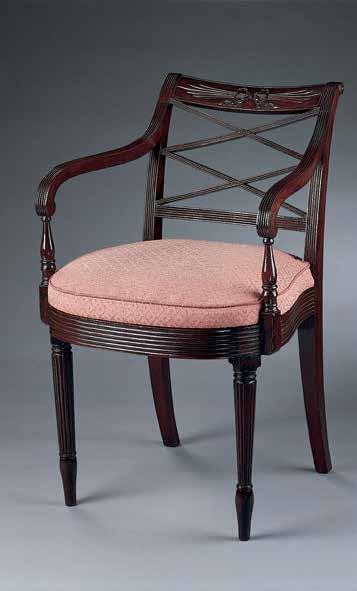
Furniture included pieces by two of the foremost New York cabinetmakers of the early nineteenth century—Duncan Phyfe and Charles-Honoré Lannuier. The popularity of the high-style product of the large Phyfe workshop has led many pieces once firmly attributed to Phyfe to be redesignated “in the manner or style of Phyfe.” Under Mrs. Kennedy, however, the White House received pieces with strong Phyfe provenances—for the Library on the Ground Floor a ten-piece suite of seat furniture, including settees and chairs in the Regency style, made circa 1810, and for the Ground Floor Corridor an early Grecian style pier table, made circa 1834. Other pieces with Phyfe attributions can be found in the Green Room, which was refurbished in 1972 with furniture by Phyfe or of the Phyfe style.

68 white house history quarterly
A side chair (above left) armchair (above right), settee (opposite top), and pier table (opposite bottom) are among the pieces made by New York cabinetmaker Duncan Phyfe acquired for the White House during the Kennedy presidency.


69 ALL PHOTOGRAPHS THIS SPREAD: BRUCE WHITE FOR THE WHITE HOUSE HISTORICAL ASSOCIATION white house history quarterly
One of the earliest Kennedy acquisitions was a circular table (guéridon) made by Lannuier, circa 1810. Bearing a paper label in English and French for “Honoré Lanniuer [sic] Cabinet Maker (from Paris),” [?] it was lauded by Peter Kenny of the Metropolitan Museum of Art in his seminal book: “The great masterpiece of Lannuier’s amalgamated style is [this] superbly balanced and proportioned gueridon.” [?] It has been in the Red Room since 1961, joined there by two additional Lannuierlabeled tables acquired in 1974 and 1993.

Textiles for many of the public rooms in the Kennedy administration were secured from Scalamandré Silks (founded in 1929 by Franco Scalamandré and his wife Flora Barranzelli, to focus on re-creating fabrics used in historic houses and museums; for more than forty years its mill occupied an early twentieth-century industrial building at 37–24 Twenty-Fourth Street, Long Island City, now the remodeled “Silks Building”). Silks made by or acquired through the firm were used in the Green Room, Blue Room, and Red
Room, and it would provide later generations of fabrics for those and other White House rooms. One Kennedy administration acquisition not made in New York, but depicting New York, is the scenic wallpaper entitled “Views of North America.” Made by Jean Zuber et Cie, Rixheim, France, circa 1834–36, this paper, removed from a house in Thurmont, Maryland, in 1961, was installed as a truly panoramic paper in the oval Diplomatic Reception Room in 1962 as an additional donation from the National Society of Interior Designers. Along with scenes of Boston, West Point, Niagara Falls, and the Natural Bridge of Virginia, the paper depicts, as seen across from Weehawken, New Jersey, what was called a “General View of New York.”
Several fine pieces made by the French-born New York cabinetmaker Charles–Honoré Lannuier were acquired for the White House during the Kennedy administration including this marble-topped center table marked with Lannuier’s paper label.

70
white house history quarterly
BOTH PHOTOGRAPHS:
BRUCE WHITE FOR THE WHITE HOUSE HISTORICAL ASSOCIATION
In 1819, while at the White House to paint a portrait of President James Monroe, the artist Samuel F. B. Morse commented that the rooms were furnished and decorated “in the most splendid manner; some think too much so, but I do not. Something of splendor is certainly proper about the Chief Magistrate for the credit of the nation.” For over 175 years, the manufacturers, designers, and merchants of New York City have been instrumental in keeping the furnishings and décor of the White House up to Morse’s standard for the presidents, first families, and the nation.
notes
Principal sources are two White House Historical Association publications: Monkman, Betty C. and William G. Allman, Lydia S. Tederick, and Melissa C. Naulin, Furnishing the White House: The Decorative Arts Collection (Washington, DC: The White House Historical Association, 2023) and Allman, William G., Official White House China from the 18th to the 21st Centuries (Washington, DC: White House Historical Association, 2016, 3rd ed.). Quotations within these sources are separately cited.
1. Voorsanger, Catherine Hoover and John K. Howat, eds., Art and the Empire City: New York, 1825–1861 (New York: The Metropolitan Museum of Art, 2000), 42, 287.
2. Official China, 12–13; Furnishing, 4–5, 340.
3. Furnishing, 84–85, 350; Diary of Elizabeth Dixon, December 1, 1845–February 10, 1847, Connecticut Historical Society Collection, quoted in Furnishing, 85, full text of diary entry in Official China, 65. Herts Brothers: Furnishing, 164, 359.
4. Haughwout & Dailey – Pierce State Service - Official China 72-75, Furnishing, 100-01, 352. Horace Greely, Art and Industry as Represented in the Exhibition at the Crystal Palace, New York, 1853–1854, Showing the Progress and State of the Various Useful and Esthetic Pursuits (New York: Redfield, 1853) quoted in Official China, 74. Professor Benjamin Silliman, Jr. and C.R. Goodrich, Esq., eds., The World of Science, Art and Industry Illustrated from Examples in the New York Exhibition 1853-1854 (New York: G.P. Putnam, 1854), 129, quoted in Official China, 74. E.V. Haughwout & Co. - Lincoln State Service - Official China, 78-86, Furnishing, 110-14, 354.
5. Haviland & Co. – Grant State Service - Official China 90–96, Furnishing, 110–11, 114, 120–21, 354–55. Hayes State Service - Official China, 100–21, unnumbered insert following; Furnishing, 153–55, 357–58.
[notes to be formatted and numbered--not sure where numbers go]
p.58 – Pottier & Stymus, Furnishing, 136, 138-41, 356.
p.59 – Herter Bros. - Furnishing, 141, 144-45, 355-56.
p.60 – Tiffany & Co. – Hayes candelabra - Furnishing, 152-53, 357; McKinley presentation cup - Furnishing, 186-87, 362; Johnson State Service - Official China, 90-96, Furnishing, 276-77, 377; Arthur redecoration - Furnishing, 168, 169-173, 360-61; Tiffany Studios rugs – 224-25, 367.
p.62 – McKim, Mead & White - Furnishing, 202-05, 364.
p.63 – Caldwell & Co. - Furnishing, 206-07, 364.
p.64 – Steinway & Co. – 1903 - Furnishing, 212-13, 362; 1938Furnishing, 236-39, 369. B. Altman & Co. - Furnishing, 237, 240-41, 369; Official China, 176-183.
p.65 – Edward Fields - Furnishing, 247, 298.
p.68 – Kennedy Acquisitions – Forbes plateau - Furnishing, 56, 263, 346; Phyfe – 258-59, 269, 373, 376; Lannuier - Furnishing, 259261, 374; Peter Kenny et al., Honoré Lannuier, Cabinetmaker from Paris (New York: Metropolitan Museum of Art, 1998),
76-77.
71 white house history quarterly



73 A Tiffany White House INTERLUDE
Chester A. Arthur Commissions Louis Comfort
Associated Artists to Decorate the White House
President
Tiffany’s
TIFFANY STUDIOS
KAYLI RENEÉ RIDEOUT
in 1881, when chester a. arthur came to the presidency, he brought his New York City sophistication with him. He had practiced law in New York and served as collector of the port of New York before being nominated, and then elected, as James A. Garfield’s vice president in 1880. On the night of September 19, 1881, Arthur was at home in New York, a fine brownstone residence on Lexington Avenue. There he received word—not unexpected—of the death of President Garfield, who had never recovered from an assassin’s gunshot wounds two months earlier. At 2:15 a.m. on September 20, Arthur took the Oath of Office in his parlor, becoming the second president—after George Washington—to be sworn in to the presidency in New York City.
Arthur moved to Washington, but he did not move into the White House. He toured it, found it shabby and unfit for a president and declared he would “not live in a house like this.” Instead, after some refurbishment, he would undertake a complete redecoration of the State Rooms (except the Green Room). As the historian William Seale has observed, Arthur, a sophisticated New Yorker, was attentive to the “aesthetic interior decoration [then] current in the centers of style.” Thus Louis Comfort Tiffany and his Associated Artists of New York City, specialists in Aesthetic decorative effects, were a natural choice for Arthur’s White House redesign.
President Arthur enlisted Tiffany’s services in 1882, at a time when the artist was in the early years of his career. The son of jewelry magnate and Arthur’s close friend, Charles Lewis Tiffany, Louis Comfort was on the rise as a young artist and designer in his own right, and Arthur may have been impressed by the important commissions Tiffany had already accomplished, including a redesign of the Seventh Avenue Armory and the Fifth Avenue home of millionaire George Kemp. For these commissions and for the White House redesign, Tiffany worked in collaboration with artists such as Candace Wheeler, Samuel Colman, and Lockwood de Forest. These were the Associated Artists, with showrooms at 333-335 Fourth Avenue , they were in operation by 1881.
In preparation for the White House redesign, Arthur conducted a thorough inventory of White House furnishings, condemning to auction those he deemed inferior, among them Nellie Grant’s birdcage and some clothing owned by President
left President Chester Alan Arthur is remembered in New York City, his home before and after his presidency, with a sculpture in Madison Square Park. The monumental bronze portrait by George Edwin Bissell was dedicated on June 13, 1899.
previous spread Artisans at work on Tiffany glass, 1913, and a view of the North Entrance to the White House as embellished with Tiffany glass during the presidency of Chester Arthur, 1893.

74 ALAMY white house history quarterly
Louis Comfort Tiffany, seen here in 1871, was just setting out on his career in 1882 when President Arthur commissioned his services to redecorate the White House.

Lincoln. Under Arthur’s orders, Tiffany and his collaborators transformed the Red Room, the State Dining Room, and the Entrance Hall, with additional work on the Blue Room and the East Room. No furniture was commissioned, although new furniture had generally been commissioned or selected for White House redecorations. Instead, the Tiffany redesign was accomplished entirely through new textiles, light fixtures, decorative painting, and, most notably, stained glass.
Perhaps the most legendary of these new decorations was the colored glass screen that Tiffany crafted to separate the Entrance Hall from the Cross Hall. The screen, made of opalescent leaded glass, was a mosaic of what one contributor for Harper’s Weekly described as “varying but symmetrical patterns, composed of sheets of opalescent glass incrusted with vitreous jewels of topaz and ruby and amethyst.” It is unknown exactly where the glass was made and the screen produced, but Tiffany was, at the time of the White House renovation, conducting his glassmaking experiments at the Heidt glasshouse in Brooklyn, New York. The opalescent sheet glass industry was in its early years in the 1880s and Tiffany would not establish his own glass furnace until 1892 in Corona, Queens. Prior to that time, Tiffany purchased flat glass from the Heidt and Thill glasshouses in Brooklyn as well as Opalescent Glass Works in Kokomo, Indiana.
As Martin Filler has shown, President Arthur’s redecoration and his selection of Tiffany’s New York firm were more than a demonstration of luxury and prestige; they were also deeply political. Because he succeeded the assassinated James Garfield, Arthur was acutely aware that he was assuming leadership of an anxious and grieving nation. In appealing to the vitality and vibrancy of Tiffany’s cosmopolitan and highly Aesthetic designs, Arthur hoped to inspire the same in his countrymen. Tiffany’s glass screen is an example. Highly functional, the screen insulated the adjacent drawing rooms from cold weather while dazzling White House guests with its rich colors and carefully considered design. Four American eagles, the United States shield, and the initials “U.S.A.” worked into the design were intended to instill feelings of pride and patriotism in all who entered the residence. Indeed, there is some evidence that it worked. Reporting on the White House redecoration in December 1882, the Washington Post announced, “No longer is the White House simply the home of a Republican
President. Lo, it is the temple of high art!”
In spite of the favorable press that Arthur’s redecoration received at the time, tastes changed at the White House almost as frequently as administrations. The dawn of the Progressive Era brought new decorative trends and politics to the Executive Mansion. In 1901 Theodore Roosevelt assumed the presidency—again after an assassination— and went on to champion social, political, and economic reform. The president and First Lady Edith Roosevelt wasted little time in renovating their new home. Also New Yorkers, they again they looked to New York, hiring the architectural firm McKim, Mead & White to, as the New York Times reported, “wipe out all modern features and restore the mansion to its original Colonial simplicity.” In the new century Arthur’s big city opulence seemed garish, out of date and out of touch with the average American experience. Tiffany’s glass screen was removed and the State Rooms the Associated Artists had redecorated were once again completely redone.
75 NATIONAL GALLERY OF ART white house history quarterly right
A stained glass worker is featured in one of a group of illustrations entitled Establishment of Louis C. Tiffany & Co.—Associated Artists, published in Harper’s Bazar, 1881.

right
Both functional and beautiful, Louis Comfort Tiffany’s jewel toned glass screen transformed the White House Entrance Hall. The symmetrically patterned, opalescent glass was colored with topaz, ruby, amethyst. This black and white photo has been colorized to approximate the appearance of the legendary screen.
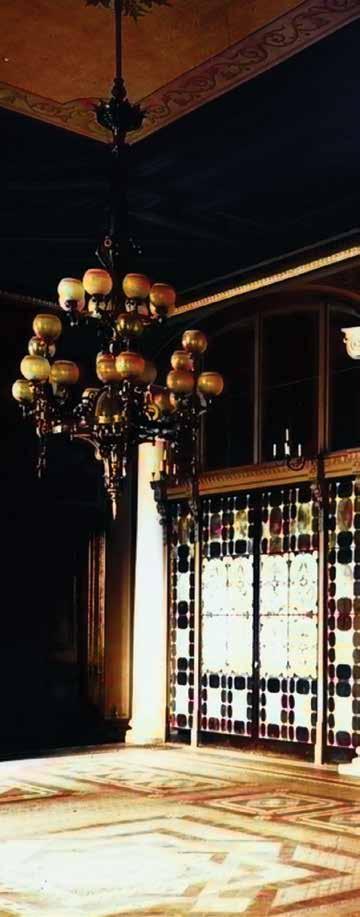
76
above
TK To be scanned

77 BOTH IMAGES THIS SPREAD: WHITE HOUSE HISTORICAL ASSOCIATION
FPO Color to be perfected
above
Women at work in the Embroidery Room at Louis C. Tiffany & Co., 1881.

left
The Red Room as decorated by Louis Comfort Tiffany’s Associated Artists for President Arthur featured painted walls in Pompeian red. The ceiling was finished in gold and copper tones.

78 white house history quarterly
TK
TOP: WHITE HOUSE HISTORICAL ASSOCIATION/BOTTOM: LIBRARY OF CONGRESS
In the East Room, Tiffany redid the ceiling in silver leaving much of the earlier decor in place.
can you make all black and whites on this spread the same tone
The State Dining Room in the 1890s retains the Tiffany wallpaper, ceiling, curtains, valances, and light fixtures.
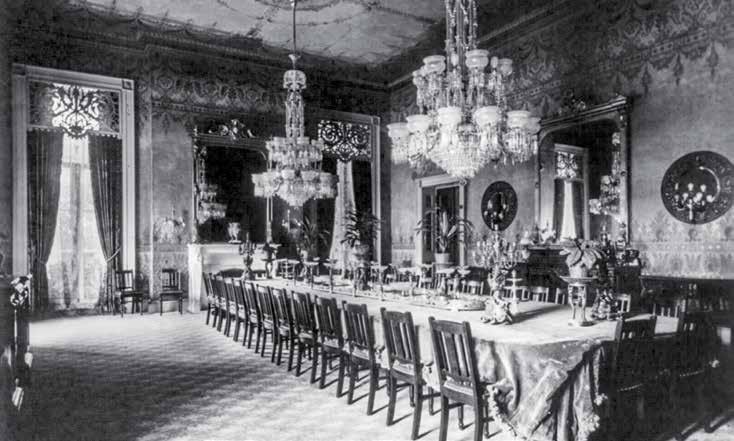

79 white house history quarterly right
NATIONAL GALLERY OF ART
below
 FPO Color to be perfected
FPO Color to be perfected

81
left
The Blue Room as decorated by Louis Comfort Tiffany’s Associated Artists for President Arthur in 1882 featured robin’s egg blue walls embellished with white snowflakes, and doily motifs, silver leaf on the ceiling, and blue upholstery. This black and white photo has been colorized to approximate the colors of the room. Tiffany’s colorful stained glass screen can be seen at center through the north door to the Blue Room.
WHITE HOUSE HISTORICAL ASSOCIATION
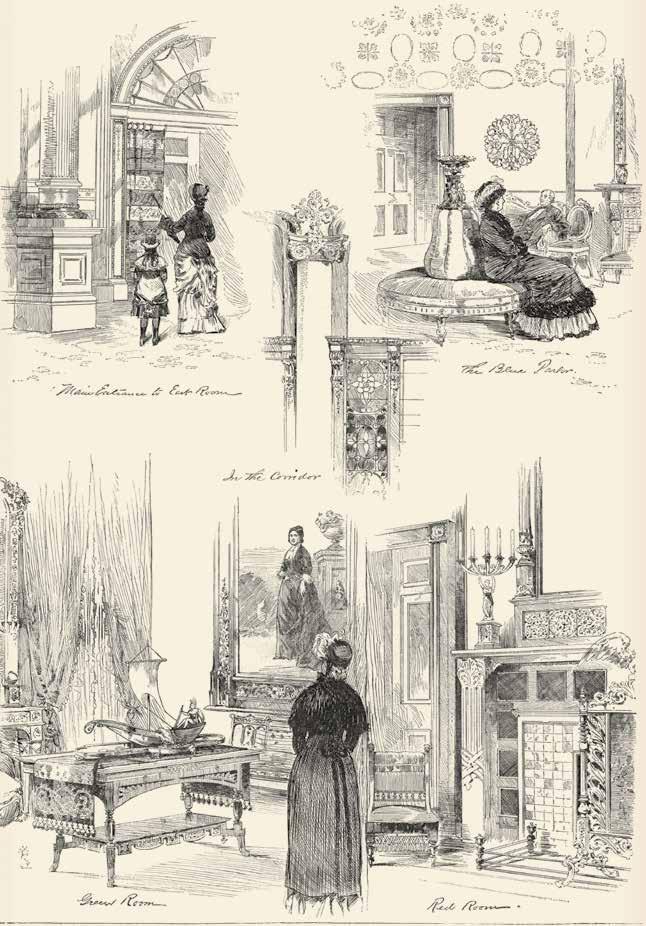
82 white house history quarterly BRUCE WHITE FOR THE WHITE HOUSE HISTORICAL ASSOCIATION
Harper’s Weekly illustrations published in the January 1883 issue captures visitors admiring the new Tiffany decor in President Arthur’s White House.
Roosevelt’s successors continued an interest in restoring styles evoking the American past. In 1925, First Lady Grace Coolidge shopped the American Wing of the Metropolitan Museum of Art in New York for inspiration on White House art and furnishings, paying special attention to “examples of furniture of the early Puritan days.” President Harry Truman’s televised tour of the White House in 1952 generated interest in locating and reclaiming White House antiques. And in 1961, when First Lady Jacqueline Kennedy began her wide-ranging project to bring original furnishings and associated period decor back to the White House, she told Life magazine, “Thank goodness for Roosevelt. He undid all the bad that was done by Arthur.”
When Tiffany’s glass screen was removed from the White House in 1902, it was sent to auction and purchased by the owner of a Maryland hotel. In 1923 the hotel was destroyed by fire, and it is assumed that the screen was likewise lost. Yet it continues to interest scholars of White House interiors and captivate the public. It stands an enduring legacy of the Arthur administration, recalling a time when the Aesthetic style so suited a president from New York that he brought artists from that city to remake the White House State Rooms to his taste.
notes
1. Quoted in William Seale, The President’s House: A History, 2nd ed. (Washington, D.C.: White House Historical Association, 2008), 1:513.
2. Seale, President’s House, 1st ed. (1986), 1: 538.
3. Roberta A. Mayer and Carolyn K. Lane, “Disassociating the ‘Associated Artists’: The Early Business Ventures of Louis C. Tiffany, Candace T. Wheeler, and Lockwood de Forest,” Studies in the Decorative Arts 8, no. 2 (2001): 7, 12.
4. Ibid., 2–36.
5. Francis de Sales Ryan, “President Arthur Swept out White House in 1882 Auction: Arthur Cleared White House,” Washington Post , August 17, 1952, M1.
6. Seale, President’s House , 2nd ed., 1:517–23.
7. “The New Decorations at the White House,” Harper’s Weekly, January 6, 1883, copy in Arthur/Tiffany Files, Office of the Curator, The White House; “Esthetic Decoration,” Washington Post, December 20, 1882.
8. Martin Filler, “Red, White, and Tiffany Blue,” Magazine Antiques, March 2009.
9. “Esthetic Decoration.”
10. “White House Renovation: Mrs. Roosevelt Proposes to Restore the Mansion to Its Original Colonial Simplicity,” New York Times, April 24, 1902, 3.
11. “Mrs. Coolidge Shops for Ideas on Art: Visits American Wing at the Metropolitan for White House Suggestions,” New York Times, November 20, 1925.
12. “White House Hunt Locates Antiques: Truman’s Efforts to Restore Relics Result in Lively Leads, But Too Late,” New York Times, January 20, 1953.
13. Hugh Sidey, “The First Lady Brings History and Beauty to the White House,” Life, September 1, 1961, reprinted in White House History, no. 13 (Summer 2003): 6–17, quotation on pages 11, 13.
14. Filler, “Red, White, and Tiffany Blue.”
83 white house history quarterly

84
Nancy Reagan THE BARBIZON
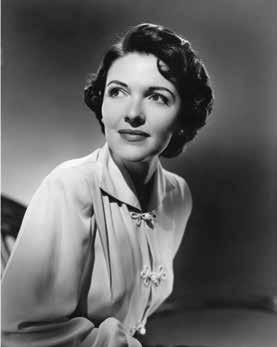
And a World Gone By
Outside of Washington, D.C., perhaps no city has more connections with America’s first ladies than New York. Many were born here, and others lived and worked in the city. The future first lady Nancy Davis was among those who pursued dreams here, setting out to “make it” in New York.
85 OPPOSITE; MUSEUM OF THE CITY OF NEW YORK / ABOVE: GETTY IMAGES white house history quarterly
JOY FERRO
“If I can make it there, I’ll make it anywhere It’s up to you, New York, New York”
ANNE FRANCES (“NANCY”) ROBBINS
was born in 1921 in Flushing, Queens, to Kenneth Robbins, a used car salesman, and Edith Luckett Robbins, an actress who had performed on Broadway and wanted to return to the New York stage.1 Shortly the couple separated, and young Nancy went to live with an aunt in Bethesda, Maryland. When she returned to New York in 1944, she was Nancy Davis, now from an affluent family and who was, like her mother, an aspiring actress looking to break in to Broadway.
Nancy Robbins had had a fortunate childhood after all. In 1929 her mother married Loyal Davis, a prominent Chicago neurosurgeon, and brought her daughter back to live with them on Lake Shore Drive in Chicago. Loyal Davis adopted Nancy, and she took his name. He sent her to Girls’ Latin School and then to Smith College, where she was active in student theater productions. During summer vacations she worked in summer stock, doing “a little bit of everything,” she later recalled.2
From an early age Nancy had been star-struck by her mother’s friends, including ZaSu Pitts, Walter Huston, Spencer Tracy, and Katherine Hepburn.
They encouraged her interest in a theatrical career, and, though she returned to Chicago after college graduation, she continued to long for Broadway. She got her chance when, in 1945, ZaSu Pitts helped her land a role in a road tour of a melodramatic farce titled Ramshackle Inn, which brought her to New York. The show, which had already had a Broadway run, soon closed, but young Nancy stayed on in the city.
For ambitious young women with dreams of becoming actresses, writers, models, fashion designers, and business executives, New York was a destination, and, for single women from “good families,” the iconic Barbizon Hotel for Women was the place to live.3 This residential hotel, prestigiously located on the Upper East Side at the corner of East Sixty-Third Street and Lexington Avenue, provided young women with a feeling of sophistication, elegance, and glamour, and at the same time assured their parents of their safety and respectability. There Nancy Davis took up residence. She was in good company, for this was where many aspiring actresses and writers chose to live in New York, including over the decades

previous spread
A publicity shot of actress and future first lady Nancy Davis Reagan, 1950. While pursuing her acting career in New York in the 1940s, she made her home in the Barbizon Hotel for women, illustrated here by Paul Baars.
left
The entrance to the Barbizon, date to come.
opposite Nancy Reagan (standing center) with Zazu Pitts (seated) in a performance of Ramshackle Inn 1949.
86 NEW YORK TIMES white house history quarterly

87 NEW YORK PUBLIC LIBRARY white house history quarterly
Lauren Bacall, Candice Bergen, Barbara Corcoran, Joan Didion, Edna Ferber, Betsey Johnson, Grace Kelly, Liza Minnelli, Sylvia Plath, Cybill Shepherd, Elaine Stritch, and “The Unsinkable” Molly Brown. The reputation and image of this women-only hotel was surely enhanced by groups that had their own separate floors, such as Powers and Ford models, Mademoiselle guests editors, and Katherine Gibbs and Wellesley College girls.
Built in 1927, the Barbizon, with its facade of salmon-colored brick, limestone, and terracotta, blended Italian Renaissance, Late Gothic Revival, and Islamic decorative elements. The stunning twenty-three floors shined high over Lexington Avenue. The hotel’s enchanting name derived from the French village of Barbizon nestled near the Fontainebleau Forest, where aspiring French artists in the nineteenth century founded the art movement known as the Barbizon School.
To be granted a reservation at this glamorous address, guests were required to submit three letters of recommendation and a promise to adhere to the rules and regulations enforced by the eagle eyes of the front desk manager and staff. Men were not allowed beyond the lobby, and the dress code was
While acting in New York, Nancy Davis joined the cast of Lute Song, starring Mary Martin and Yul Brynner. Her credit line is seen near the center of the first column in the Shubert Theatre program (above left) for the production that opened in January of 1946.

Years later, First Lady Nancy Reagan welcomed Mary Martin to the White House to perform in the PBS program “A Salute to Broadway” (above right), 1988.

A regular visitor to New York throughout her life, Nancy Reagan waves at the Broadway opening of “Metamorphosis,” (left) 1989.

88 CLOCKWISE FROM TOP LEFT:
HISTORICAL ASSOCIATION / GETTY IMAGES / AP IMAGES white house history quarterly
WHITE HOUSE
David Can you remove black marks on Nancy Reagan’s face?
Like his mother, father, and grandmother, Ron Reagan pursued a career on stage. Here Nancy Reagan visits New York with her husband President Ronald Reagan to enjoy Ron Reagan’s dance performance at a Lincoln Center benefit, 1981.
strict—business attire for the day, formal attire for the evening—and its residents were never to leave the hotel in slacks. The club-like atmosphere was one of a sorority with afternoon teas, card games, backgammon, and lecture series. But most of all, there was a sense of camaraderie among the young career-aspiring residents.
In New York, Nancy Davis’s career continued to benefit from family friendships. She soon landed the role of Si-Tchun, a lady-in-waiting, in Lute Song, a musical starring Mary Martin and Yul Brynner at the Plymouth Theatre on West Forty-Fifth Street. The show ran for five months, from February to June 1946. During this time Nancy Davis mingled with Broadway stars and managers, briefly dating, most notably, Clark Gable.4 But when Spencer Tracy helped arrange a screen test for her, she won a seven-year contract with Metro-Golden-Mayer. Having briefly “made it” in New York, Nancy Davis left for California. She later exclaimed, “Joining Metro was like walking into a dream world.”5
Returning to New York in the 1980s as First Lady Nancy Reagan, the former movie star
presided over A-list social events. Her close friends and confidants were the leaders of fashion, theater, and the arts. Socialites such as Betsy Bloomingdale ensured that Mrs. Reagan was in the forefront of parties and soirees.6

Meanwhile, in 1981 the Barbizon Hotel opened its doors to its first male guest, signifying the end of the glamorous women-only hotel.7 Recently restored, the building is now luxury condominiums, but it ever remains an important chapter in New York’s social history. By offering a safe haven for single young women hoping to launch successful careers, the iconic Barbizon represents a world gone by.
notes
The epigraph is from the lyrics to “New York, New York,” most famously sung by Frank Sinatra.
1. Biographical information on Nancy Reagan’s early life is from “Biography of Nancy Reagan” and “Nancy Reagan’s Acting Career,” Ronald Reagan Presidential Library and Museum website, www. reaganlibrary.gov; James G. Benze Jr., “Nancy (Anne Frances Robbins Davis) Reagan (1921–), First Lady: 1981–1989,” in American First Ladies: Their Lives and Their Legacy, 2nd ed., ed. Lewis L. Gould (New York: Routledge, 2001), 393–94; Marc Eliot, Reagan: The Hollywood Years (New York: Harmony Books, 2008), 227–31; Dana Sauchelli and David K. Li, “Before the White House, Nancy Reagan Got Her Start in Queens,” New York Post, March 6, 2016; Jessica Contrera, “Before She Was First Lady: Nancy Reagan’s Acting Career,” Washington Post, December 3, 2021; Karen Tumulty, Triumph of Nancy Reagan (New York: Simon and Schuster, 2021). Nancy Reagan’s own account is My Turn: The Memoirs of Nancy Reagan, with William Novak (New York: Random House, 1989), 66–89. Nancy Reagan does not mention staying at the Barbizon but recalls finding “a fourth-floor walk-up” on East Fifty-First Street (p. 84).
2. Nancy Reagan, I Love You, Ronnie: The Letters of Ronald Reagan to Nancy Reagan (New York: Random House, 2000), 17.
3. Information about the Barbizon Hotel is from Tom Miller, “The 1927 Barbizon Hotel for Women—140 East 63rd Street,” posted February 25, 2012, Daytonian in Manhattan blog, www. daytonianinmanhattan.blogspot.com[?]; Nina K. Guzman, “Look Inside the Barbizon Hotel for Women: Where Sylvia Plath and Joan Didion Lived,” Bust Magazine, August¬–September 2014, online at www.bust.com; Michael Callahan, “Sorority on E. 63rd St.” Vanity Fair, April 2010, 168–75; Nicole Saraniero, “Top Ten Secrets of NYC’s Barbizon Hotel,” Untapped New York website, www.untappedcities.com; Paulina Bren, The Barbizon: The Hotel That Set Women Free (New York: Simon and Schuster, 2021).
4. Reagan, My Turn, 86–88; Eliot, Reagan, 230.
5. Reagan, My Turn, 88. See also Carl Anthony, “The Hollywood Movie Star Who Became First Lady: Nancy Reagan’s Film Career,” posted February 28, 2014, National First Ladies Library website, www.firstladies.org.
6. William Norwich, “When Nancy Reagan Ruled New York,” posted March 8, 2016, W Magazine, www.wmagazine.com.
7. Guzman, “Look Inside the Barbizon Hotel for Women.”
89 AP IMAGES white house history quarterly
David please straighten and -Y from photo of letter

JACQUELINE KENNEDY’S Letter to Bergdorf Goodman
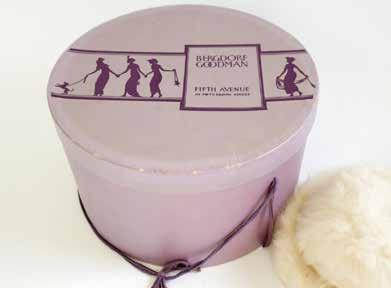

91 OPPOSITE AND BELOW: BRUCE WHITE FOR THE WHITE HOUSE HISTORICAL ASSOCIATION / TOP: GETTY IMAGES white house history quarterly
“Hats are the most important thing”
STROLLE replace with new photo
MARGARET
when her husband, john f. kennedy, won the presidential election in November 1960, Jacqueline Kennedy knew that fashion critics as well as the public would scrutinize her fashion even more than they had during the campaign. A reminder of her determination to be properly dressed is a framed letter long displayed on the seventh floor of Bergdorf Godman. At Fifth Avenue between 57th and 58th Streets, the New York Citybased department store has offered custom clothing as well as luxury ready-to-wear pieces for more than a century. Dated November 14, 1960, and typed on stationery embossed with the Kennedy’s Georgetown stationery the letter is addressed to Marita O’Connor at Bergdorf’s custom hat department. Mrs. Kennedy wrote:
I am sending you the sketches and fabric samples of dresses I have ordered. I would like you to send me hats (either models you have on hand, or sketches) you think appropriate to wear with each of these costumes. You may not know it yet, but I have decided to get nearly all my clothes through BergdorfGoodman. Please keel this confidential until I announce it myself.
It would simplify things for me enormously if, once I have chosen my dresses, I could send you sketches, samples, as I am doing today— then you could choose the hats, gloves and, in some cases, bags. Can I sort of use you as my personal shopper there or should a write to someone else? If so, who?
I prefer to deal through you as hats are the most important thing. Just give me a suggestion whether the gloves should be leather, doeskin—shoes & bag, leather or suede, etc.
I will get the gloves from B.-G. definitely and maybe the bags when I see what yours are like. Could you let me hear from you at your earliest convenience. Remember—I go in to the hospital about December 10 and must have all my wardrobe ready by then.
As Mrs. Kennedy explains, she had already ordered dresses and requested that Marita O’Connor select matching accessories, of which hats would be the “the most important thing.” Mrs. Kennedy had not normally worn hats and she felt “absurd” in them. However, they still featured as a part of a traditional woman’s wardrobe in the early
Jacqueline Kennedy at her typewriter in the Kennedy’s Georgetown residence, October 1960.

previous spread left
Jacqueline Kennedy’s typewritten letter framed and on display on Bergdorf Goodman’s seventh floor, 2020.
previous spread right
Wearing a hat supplied by Bergdorf Goodman, First Lady Jacqueline Kennedy turns to the television camera during President John F. Kennedy’s Inauguration, January 20, 1961. Hats from Bergdorf Goodman were carefully packed in branded hatboxes.
92 GETTY IMAGES white house history quarterly
Founded in 1899, Bergdorf Goodman has stood at Fifth Avenue and 58th Street in midtown Manhattan since 1928.
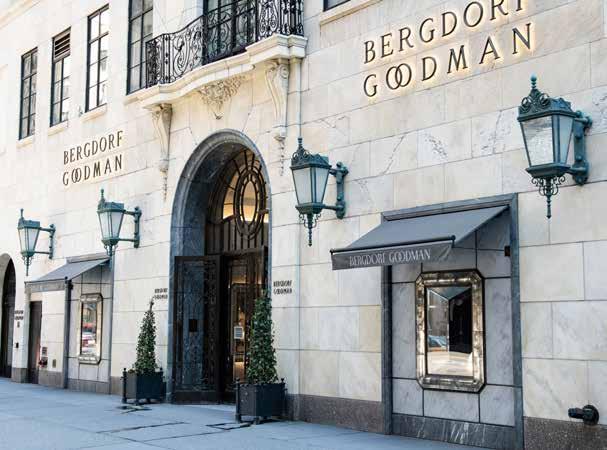
1960s, so they needed to be worn by a first lady.1 She also did not want to be thought of as spending excessive amounts on fashion. In a postscript she added,
In some cases, a hat can serve 2 or more costumes. Needless to say, I want to economize wherever possible.
As a luxury store with in-house designers and a New York City address, Bergdorf Goodman did not allow for a great deal of economizing, but it fit the politically necessary criteria of being an American company, the most appropriate choice for a first lady in the common American mind.
Bergdorf saleswomen, known as “vendeuses,” memorized the measurements and tastes of elite customers who could visit in person, but the heavily pregnant incoming first lady would have to place her orders by letter and sketch. She would actually give birth to her son, John F. Kennedy Jr., on November 25, 1960, well before the December 10 date she anticipates in the letter. She asks O’Connor to be her “personal shopper,” selecting accessories to match sketches of already selected costumes. A former Bergdof-Goodman personal shopper
actually suggests that Kennedy may have come up with the term, although the Oxford English Dictionary cites a the earliest usage as 1941 issue of The William and Mary Quarterly 2
Like other first ladies before her, Mrs. Kennedy admired French fashion, but in a new media age, sartorial treason would be more visible to critics. The Kennedy clan would ultimately overrule the decision for Bergdorf Goodman to supply the future first lady’s clothing in favor of Oleg Cassini, a longtime family friend. Jacqueline Kennedy still needed the hats and other accessories that the store could provide.
Mrs. Kennedy continued to shop at Bergdof Goodman after her time as first lady. She moved to New York City in 1964, living there off and on until her death in 1994. Bergdof Goodman remains open today after twelve decades in operation .
notes
93 GETTY IMAGES white house history quarterly
The entrance to the luxury department store is seen here in 2018.
1. Susan Black,” Mrs. Kennedy’s Cabinet,” New Yorker, January 14, 1961, 77. Steven Gaines “How Halston Became Halston,” Vanity Fair, September 1991, accessed online at vanity fair.com.
2. Wendy Mason, “Antiques: A Pillbox Hat for the Lady,” New York Times, March 6, 1998, 106; ”Personal, adj., n., and adv.,” OED Online from Oxford University Press available online at https:// www-oed-com. ; Minnie Clare Boyd, “Review of The Cotton Kingdom by Charles S. Davis,” The William and Mary Quarterly, Vol. 21, No. 3 (Jul., 1941): 283-284

presidential sites q uarterly Feature
Herbert Hoover, Apt. 31A, and U.S. Presidents at New York’s WALDORF-ASTORIA
 DEAN J. KOTLOWSKI
DEAN J. KOTLOWSKI
95 OPPOSITE: GETTY IMAGES / TOP: WIKIPEIDA white house history quarterly
The opening of the Waldorf-Astoria Hotel in 1931 was a national event that President Herbert Hoover marked during a radio address from the White House. Speaking as someone familiar with travel, social mobility, and public service, Hoover asserted that America’s hotels embodied a “far larger vision than mere profit earning.” The Waldorf-Astoria, he insisted, exemplified the progress of New York City and the wider nation. The older version of the hotel, situated at Thirty-Third Street and Fifth Avenue and built in German Renaissance style, opened in 1893 and was razed in 1929. The new Waldorf-Astoria, located between Forty-Ninth and Fiftieth Streets along Park Avenue, embodied Art Deco design, with a pair of towers ascending to the sky. It signified optimism amid hard times. “This great structure,” Hoover stressed, contributed to “the maintenance of employment” and showcased America’s “courage and confidence.” Like the country itself, the WaldorfAstoria survived the Great Depression, thrived during the World War II and the postwar prosperity,

and became, to borrow Hoover’s words, “the meeting place of a thousand community and national activities.”1 Its apartment complex, known as the Waldorf Towers, was Hoover’s second home beginning in the 1930s and his only home after 1944. No president had such a close connection with the Waldorf. Yet he was not the only political figure associated with the famous hotel.
“A CENTER OF AMERICAN POLITICAL LIFE”
The Waldorf-Astoria, says David Freeland, who wrote a book on the subject, had a “long history as a center of American political life.”2 In 1924, the old Waldorf was the headquarters of choice for aspirants for the Democratic presidential nomination. Although the convention voted one hundred and three times before settling on little-known John W. Davis, signs of an early boom for the local favorite, Governor Al Smith of New York, pervaded the Waldorf. There were, wrote the New York Times,
above
The first WaldorfAstoria Hotel at Thirty-Third Street and Fifth Avenue was open from 1893 until it was razed in 1929 (top left). It was replaced with the current Art Deco structure on Park Avenue between Forty-Ninth and Fiftieth, which President Herbert Hoover opened with a radio address from the White House in 1931.

96
TOP LEFT AND RIGHT: WHITE HOUSE HISTORICAL ASSOCIATION white house history quarterly
to be scanned
“pictures of ‘Al,’ vast quantities of literature and buttons, and Smith followers [eager] to extend the hand of greeting.”3 Smith did win the Democratic nomination in 1928, but lost the general election to Hoover.
Others close to the presidency, and to presidents, found their way to the Waldorf. Following the 1960 election, former Senator William Benton of Connecticut lunched at his Waldorf Towers apartment with a pair of past and future Democratic nominees, Adlai E. Stevenson and Hubert H. Humphrey. The immense, art-filled abode impressed Humphrey, more so than Benton’s advice to the “country boy” from Minnesota: “He insisted that I read more about art and music, and attend opera and concerts and legitimate theater.”4
In 1982, fellow Minnesotan Walter F. Mondale, a Humphrey protégé and the Democratic standard-bearer in 1984, also seemed uneasy at the

Waldorf when he keynoted a fund-raiser for the Human Rights Campaign Fund. Mondale’s speech endorsed gay rights albeit without fervor, and he declined to be interviewed on television afterward.5
First ladies made their share of news at the Waldorf. A death threat failed to dissuade Eleanor Roosevelt from attending a dinner in the Grand Ballroom to honor workers at Beth-El Hospital in 1950.6 A decade later, she went to the Waldorf to read a speech for Senator John F. Kennedy at a luncheon sponsored by the National Conference of Christians and Jews.7 She used the occasion to restate her support for the Democratic nominee and her belief in religious tolerance.8
Presidential politics was part of the Waldorf’s history, perhaps no more so than in 1964. Before a black-tie gathering in the Grand Ballroom, Republican presidential hopeful Barry Goldwater blasted President Lyndon B. Johnson’s recent declaration of war on poverty. The Arizona senator had no use for a policy he deemed a “Government handout,” or for LBJ, whom he dismissed as “the Santa Claus of the free lunch.” “The Republican alternative,” Goldwater declared, “is that men and women working and investing in thousands of industries, freed from bureaucratic interference, can build the wealth that best fights poverty.”9 In a foretaste of the grassroots enthusiasm that later greeted Goldwater’s no-nonsense conservatism, the audience interrupted his speech with applause ten times.10 The president returned fire months later, also in remarks at the Waldorf’s Grand Ballroom. Addressing the American Bar Association, Johnson outlined his campaign’s themes: racial justice at home and military restraint abroad. He jabbed at “those who would hold back progress toward equality,” meaning Goldwater, who had opposed the Civil Rights Act of 1964, and he alluded to his rival’s hawkish inclinations by chiding those “eager to enlarge the conflict” in Vietnam (something Johnson later did).11 Nevertheless, LBJ and Goldwater set aside their differences in October 1964, when they attended a memorial to honor Herbert Hoover. The funeral service took place at St. Bartholomew’s Episcopal Church, one block north of the Waldorf.12 The president who had opened the Waldorf-Astoria in 1931 spent his final years living in the famous hotel.
97 GETTY IMAGES white house history quarterly
p revious spread
Traffic flows past the Park Avenue entrance to the Waldorf-Astoria, 2013, and Herbert Hoover takes in the view from suite 31A, 1960.
below Financier Charles Hayden, holding a trowel, is joined by hoteliers Lucius Boomer and Augustus Nulle during a ceremony to mark the completion of the exterior masonry on the Waldorf-Astoria Hotel, 1931.
Newsworthy Welcomes
New York’s Waldorf-Astoria has welcomed presidents, first ladies, and those close to the presidents at political and social events for more than a century.

Clockwise from top right: President Franklin D. Roosevelt speaks at [event to come]; Former President Harry S. Truman cuts his birthday cake at a dinner given by the Harry S. Truman Library Committee, 1954; President John F. Kennedy addresses the annual dinner of the Bureau of Advertising of the American Newspaper Publishers Association, 1961; and President Lyndon B. Johnson speaks to guests at the Weizmann Award dinner, 1964.



98 CLOCKWISE FROM TOP RIGHT: GETTY IMAGES / GETTY IMAGES / AP IMAGES / AP IMAGES white house history quarterly
TK




99 NANCY REAGAN: GETTY IMAGES / ALL OTHERS: AP IMAGES white house history quarterly
Clockwise from top left: First Lady Eleanor Roosevelt speaks at a New York Herald Tribune forum, 1943; in her first official appearance as the wife of the president elect, Mamie Eisenhower tastes a piece of “dream cake” at a fundraiser for the USO, 1952; First Lady Nancy Reagan receives the Rotary International Presidential Citation, 1984; and Former First Lady Barbara Bush holds a press interview in her suite at the WaldorfAstoria following the release of her autobiography, 1994.
A SECOND AND THEN A PERMANENT HOME FOR HERBERT HOOVER

Hoover and the Waldorf were a matched set. “He loved the Waldorf,” recalled Joseph P. Binns, the hotel’s manager during the 1950s.13 It became home to this much-traveled, once-admired, and later reviled leader. Hoover found the Waldorf’s management personally and ideologically congenial. The staff and the surroundings provided comfort and support as he endeavored to regain his political influence and revive his reputation. Hoover’s relationship to the Waldorf was more private than public, at least when compared to the presidents, first ladies, presidential aspirants, and assorted politicians who came to the hotel to speak, attend a meeting, share a meal or drink, and then depart. Yet, for Hoover, private and public affairs merged. He worked from his apartment, writing books, conferring with VIPs, and seldom dining alone. His later life revealed a man both formal and humble—someone accustomed to the national limelight and the finer points of life, yet loath to sit still. From the Waldorf, Hoover campaigned, not for votes or office, but for a better country that would think better of him.
Herbert Hoover was always on the move. He ascended from an orphaned childhood in Iowa to the presidency. In between, he graduated from Stanford University; plied his expertise into a lucrative career in mining and business; lived in Australia, China, and London; oversaw international relief for war-ravaged Belgium; ran Woodrow Wilson’s wartime U.S. Food Administration; and headed the Department of Commerce under Warren G. Harding and Calvin Coolidge. Portrayed as a policy wunderkind (and wonk), adept problem solver, and moderate reformer, he won the White House in a landslide. Yet the Great Depression shattered Hoover’s presidency, and his harsh expulsion of the Bonus Army from Washington, D.C., ended his reelection prospects. Hoover’s reputation never fully recovered. Many Americans resented him for failing to provide adequate relief for unemployed people and a solution to America’s worst economic crisis. Under Hoover, one person vented, “We nearly starved. Only the bark off of the trees was left.”14
Rehabilitation and respite became Hoover’s priorities throughout a restive retirement. An observer once noted: “The days, weeks or months were not
long enough for Hoover to work.”15 Yet thoughts of a political comeback in 1936 and 1940 went nowhere, and Hoover’s attacks on the New Deal fell flat, except with the right-wing of the Grand Old Party (GOP), which never had trusted him. Sidelined during World War II, Hoover remained a pariah until President Harry S. Truman sent him abroad to gauge the possibilities of a postwar famine. Such work enabled Hoover to reengage in public service and to counter perceptions of him as a failed president. He later chaired a pair of presidential commissions on executive branch reorganization, one under Truman and another under Dwight D. Eisenhower. Opinionated and occasionally irascible, Hoover had differences with both presidents, but he grew to like Truman. As ex-president, Truman attended the opening of Hoover’s presidential library in West Branch, Iowa—a carefully scripted event in Hoover’s effort to refurbish his reputation. Truman often asked Daniel Rodriguez, a Waldorf waiter who attended to Hoover, about the former president’s health.16 Truman made these
100
white house history quarterly
/
TOP: GETTY IMAGES
BOTTOM: CREDIT TK
President and Mrs. Herbert Hoover are joined by Lucius Boomer, the president’s old friend and the hotel manager, as they enter the new Waldorf-Astoria Hotel, 1931.
Herbert Hoover celebrates his eighty-eighth birthday reading well wishes in 31A, his suite at the Waldorf-Astoria.


101 TOP:ALAMY / BOTTOM: HOOVER LIBRARY white house history quarterly
A portrait of First Lady Lou Hoover hangs above the mantepiece in the Herbert Hoover Presidential Library’s recreation of Hoover’s office in 31A.
inquires during visits to New York in the 1950s, when he stayed in Apartment 32A at the Waldorf Towers. By then, Hoover lived one floor below—in Apartment 31A.17
Hoover’s connection to the Waldorf began with Lucius Boomer, the hotel’s manager and an “old friend” who had invited Hoover to speak at the Waldorf’s opening in 1931.18 The two men shared an outlook that melded entrepreneurship with social responsibility. Boomer strove to improve the lives of his workers—and to discourage unionization— by providing social clubs, savings banks, employee bonuses, and health insurance.19 He identified scientific reasoning and impartial administration as the keys to prosperity and social progress. Hoover, too, extolled the virtues of a decentralized economy, gently guided by enlightened business executives and government officials. Yet his push for what one historian termed “cooperative, humane, common-sense capitalism” died during the Great Depression.20 Government intervention followed. FDR’s National Recovery Administration brought industrial codes, pressures to unionize, and strikes, which Boomer’s Waldorf resisted. Hoover, for his part, attacked the New Deal as a threat to virtues of hard work and individual initiative. In a memoir of his postpresidential years, he defined every national election between 1936 and 1952 as a “Crusade against Collectivism.”21 “The only person he ever criticized,” recalled James A. Farley, FDR’s postmaster general and Hoover’s neighbor at the Waldorf, “was Mr. Roosevelt.”22 Boomer, in contrast,
received the highest praise. On the silver anniversary of the Waldorf’s launch, Hoover ranked him among “the greatest of American hotelman.” The Waldorf, he added, “has set comforts of living which I have personally enjoyed.”23
The Waldorf brought Hoover to America’s economic and cultural capital just a few hours’ drive of Washington. He and his wife, Lou Henry Hoover, had no plans to retire to their native Iowa. Hoover’s interest in West Branch lay in occasional visits to accept the approbation of Iowans, in preserving sites that marked his modest origins, in building a library like those constructed for Franklin D. Roosevelt and Truman, and in arranging his burial site.24 Curating his legacy was one thing. Finding a place to live—and to remain politically engaged—was quite another. Stanford University, from which Hoover and his wife had graduated, was an unlikely possibility. The family’s home in Palo Alto, an International-style mansion designed by Lou Hoover, ceased to be a refuge after Hoover’s sons, Herbert Jr. and Allan, had left to raise families of their own by the 1930s. Stanford lacked the cultural and political allure of the East Coast. Hoover disdained “the superficialities, the inanities, and the un-American atmosphere too frequent in New York.” Yet he knew that leaders “from the hinterland,” like himself, had found success there. New York provided a central location from which the former president could monitor the doings of his successor’s New Deal. It had “big money,” publishing conglomerates, and daily newspapers.
During his years in residence at the Waldorf-Astoria, former President Herbert Hoover met with many world leaders as well as former, future, and current presidents.
Above left: Hoover is seen to the left of Queen Elizabeth II as she addresses an official city luncheon, October 21, 1957. Former First Lady Eleanor Roosevelt can also be seen behind the queen.

Above right: Hoover meets with President John F. Kennedy in his suite, April 28, 1961.

102 BOTH PHOTOGRAPHS: AP IMAGES
white house history quarterly
“When one is interested also in the promulgation of ideas,” Hoover explained, “it is more effective to be at the distributing point than at the receiving end.” The city’s stores, museums, and galleries were world class. New York, Hoover wrote, “is a place of good food, of human comforts.”25 So, beginning in 1934, the Hoovers rented a suite at the Waldorf, where the president had enjoyed a “most pleasant” stay following his electoral defeat in 1932.26 By 1940, Apartment 31A had become their second home. Sadly, it was where Lou died in 1944. After her death, Hoover willed the California house to Stanford University and lived primarily at the Waldorf.27
Hoover led a comfortable life at the Waldorf. NBC newscaster Raymond Henle, a friend, thought Apartment 31A “lovely.” [?] Exquisite rugs covered the floors of the office and living room, and blue-and-white porcelain from the Ming dynasty reminded visitors of Hoover’s years in China. Also noteworthy was the former president’s desk, issued by the government and returned to the General Services Administration following his death. As a “permanent guest,” Hoover had access to the Waldorf’s amenities, including room service.28 Yet he was more than a guest. The Waldorf’s managers became confidants. Hoover appreciated Lucius Boomer’s many years of “loyalty and friendship.”29
Joseph Binns did some work for the second Hoover Commission, while keeping the former president supplied with cigars, flowers, sweets, and New York Yankees tickets.30 Hoover joined the hotel’s

board of directors, to whom he conveyed the complaints of Waldorf employees.31 And he brought in business. In 1953, the Bohemian Club, an all-male society, honored Hoover, a forty-year member, at the Waldorf rather than in California, the site of its annual encampment. Organizers shipped redwood boughs east, to transform three of the hotel’s rooms into an ersatz forest. Cocktails, a black-tie dinner with tributes, and entertainment marked the festivities. Hoover “enjoyed every minute of it.”32 He then retired to his apartment, described by one associate as a “home-like suite.”33
Hoover’s daily routine reflected his multifaceted personality. He ate breakfast at 9:00 a.m., lunch at 1:00 p.m., and dinner at 7:30 p.m. His preferences were standard: eggs, bacon, and coffee in the morning; salad, stew, or goulash at midday; and consommé, potatoes, vegetables, and roast beef or fish in the evening. Meals ended with pastry, pie, or cherries jubilee. A martini preceded dinner. Hoover insisted on punctuality but forgave lapses and was generous with hotel staff. He supplemented Daniel Rodriguez’s income and presented gifts at Christmastime. When hotel employees stopped by to see his Christmas tree, he directed them to it with a wave of his hand. Hoover was close to his secretaries Bernice Miller and Elizabeth Dempsey, who either dined with him or arranged for others to do so (Hoover hated to eat alone). Dinner guests included political bigwigs or old friends, such as the broadcaster Lowell Thomas and his wife. A game of canasta closed the evening, and at 9:30
103 GETTY IMAGES white house history quarterly
Hoover joins Vice President Richard Nixon ahead of a American Newspaper Publishers Association dinner, 1953.
p.m. Hoover saw his visitors to the door. “He just treated you like part of his family,” Dempsey noted.34A Siamese cat provided additional companionship. “It’s a shame to have a cat and not have a dog,” Hoover joshed, “but what are you going to do with a dog on the 31st story in the Waldorf?”35
Such comments countered Hoover’s austere persona. “He gave sort of a coldness publicly, which really didn’t exist privately,” remembered Charles Edison, son of the renowned inventor and a resident at the Waldorf.36 Light observations oftentimes enlivened Hoover’s conversations. A trip to the ballpark, he averred, had “more curative powers” than medicine.37 Television enabled him to watch baseball as well as nightly newscasts, which he never missed.38 Other diversions included walks in the neighborhood around the Waldorf or trips to Key Largo, where he spent winters and fished. Fishing, Hoover quipped, “brings rejoicing that you do not have to decide a darned thing until next week.”39 Key Largo provided warmth and sunshine; Hoover once resolved to remain in Florida “until New York has reformed its weather.”40
Apartment 31A functioned as Hoover’s workplace. “I always imagine him sitting at his desk, and always occupied in writing,” Rodriguez recalled.41 Seven secretaries assisted him. Hoover replied to letters diligently, wrote his speeches, and published several books, including a biography of Woodrow Wilson, a mediation on fishing, and a collection of his correspondence with children. A magnum opus, Freedom Betrayed, was not published until a half century after his death. The delay was understandable: a friend said the work read like an “indictment” of FDR’s foreign policy.42 In letters to confidants and in his Memoirs (1952), Hoover labored to set the record straight about the Great Depression: it derived from events overseas, the tide began to turn “in June 1932,” and then, within a year, “America fell into the pit of the New Deal and never recovered . . . until it was absorbed in war.”43 The self-serving argument did little to lessen the appeal of Roosevelt or his programs.
Hoover, the historian Richard Norton Smith observed, “was not the sort to let old grudges die without a struggle.”44 He never became close to Dwight D. Eisenhower, whom he thought too liberal and less than enthusiastic about the recommendations of the second Hoover Commission. Hoover told one guest that Eisenhower “is decent and sincerely wants to do right but knows nothing
of economics, government or politics.”45 He was annoyed when Vice President Richard Nixon, a protégé of sorts, did not ask him to campaign for the GOP ticket in 1960. Nevertheless, Hoover received Nixon, John F. Kennedy, and Lyndon B. Johnson at the Waldorf.46 In 1962, for example, Nixon visited Hoover in Apartment 31A, where the former president advised the former vice president not to seek the California governorship. “California basically is a great state,” Hoover explained, “but it’s quite parochial. You belong on the national and international scene. You can’t do that in California.”47 Nixon lost the race for governor and thereafter relocated to New York, where he prepared his political comeback.
The attention of presidents reminded Americans of Hoover’s long public service and added to his image as “the Sage of 31-A.”48 In 1958, Eisenhower sent Hoover to represent the United States at the opening of the World’s Fair in Brussels, where Belgians lauded his relief efforts during the Great War. At home, Hoover supported charities such as the Boys Clubs of America, of which he served

104
AP IMAGES white house history quarterly
A military honor guard watches over former President Herbert Hoover’s casket at St. Bartholomew’s Church across the street from the Waldorf-Astoria, October 21, 1964.
as national chairman. He sat for interviews, commented on current events, and dispensed advice: “Work. Don’t sit around worrying about ills and pills.” 49 Addressing the Republican National Convention in 1960, the former president avoided partisan bombast and championed widely shared values of freedom, opportunity, and patriotism.50
The Waldorf played a modest role in Hoover’s bid to regain his political relevance and reputation. The hotel attracted countless international dignitaries. Hoover visited with two presidents of Mexico, Adolfo López Mateos and Miguel Alemán Valdés, the latter of whom had a flat at the Waldorf.51 Neighbors at the Waldorf Towers became friends and admirers. The Duke and Duchess of Windsor, for example, mourned Hoover’s death, in 1964, as a “great loss to the world.”52 Earlier, Jim Farley, who had fallen out with Roosevelt, served on the second Hoover Commission and launched a fund-raising drive in Hoover’s name for the Boys Clubs of America.53 “It was ever a pleasure to visit him in his apartment and discuss the happenings of the day,” Farley stated. “He was one of the most dedicated, patriotic and unselfish Americans I have ever known.”54 Charles Edison spent time with Hoover, shared his political outlook, and praised him in an oral history, as did Farley. “He had the tremendous loyalty of his friends,” Edison explained. “They just worshipped him.”55 The words of well-wishers cheered Hoover. He “got a big kick” when a doorman shouted: “I cut your son’s hair when he was a little boy.”56 Jean MacArthur asked after Hoover, for she and her husband, General Douglas A. MacArthur, lived at the Waldorf Towers.57 Nevertheless, Hoover failed to cajole MacArthur into endorsing Eisenhower during the 1952 election. The former president’s messages and telephone calls went unanswered as MacArthur remained aloof from Ike, his former subordinate. Such prodding, according to Binns, showed Hoover “trying to do what he thought was best for the party and for the country.”58 Yet it also underscored that physical proximity did not lead to political pull. The sporadic attention Hoover received from presidents and other leaders boosted his “political star,” says his biographer, Joan Hoff Wilson, without making him “a truly influential political figure once again.”59
By the time of his death, Hoover had won a qualified rehabilitation: respect for his nonpresidential achievements and acknowledgment of his troubled presidency. As his health declined, Hoover
relied on family and friends. To a neighbor at the Waldorf, he said: “Well, if it isn’t too much trouble, come and see an old man soon again, will you?”60 Hoover passed away in Apartment 31A on October 20, 1964. Although Hoover’s State Funeral did not include observances at the Waldorf, black-draped photographs of him were placed in the lobbies of the hotel and towers.61 Americans mourned the better aspects of Hoover’s life. Retrospectives extolled his perseverance, integrity, compassion, and public service.62 Editorial writers discussed his presidency guardedly. The Washington Post found Hoover “the victim of circumstances over which he had no control,” the fallout from which made him, as the Buffalo Evening News put it, “the most baselessly maligned of men.”63
Subsequent scholarship on Hoover, a political scientist explained, has “dispelled the myth of an intransigent, laissez-faire ideologue,” and his reputation as a humanitarian and public servant rebounded.64 But, according to the journalist John Bartlow Martin, he lacked the ability to “feel in his bones the needs of the American people.”65 Hoover’s failure to find a solution to the Great Depression remained his albatross. A newspaper in Northern Ireland announced his death with the headline: “Slump Years President Dies.”66 An energetic ex-presidency, headquartered in Apartment 31A, proved no match for a widely held view, aptly summarized by the Wall Street Journal in 1974: “Hoover’s presidency, as a whole, was an unfortunate detour in an otherwise brilliant career.”67
Hoover’s association with the Great Depression partially explains his heartfelt devotion to the Waldorf. The economic collapse that wrecked his presidency challenged the values of self-reliance and private initiative that he had long embodied. But Boomer’s hotel offered a beacon of hope. The Waldorf’s opening, according to Hoover, was a “monument to pluck,” to American entrepreneurship, and to faith “not only in the future of the hotel but in that of America itself.” The result, he asserted, was an institution that provided “a forum where more or less everybody in America meets in order to pass the time of day.” The Waldorf also became “a marketplace, a ‘Rialto,’ a center of music and dancing, a club, a place for feasting, an office for business, a panorama of fashionable life, and, best of all (best for me at least) a household in which everybody manages to be supernaturally obliging and kind.”
The former president jotted these words in 1939, in
105 white house history quarterly
Al Smith Memorial Foundation Dinner
Nearly every four years between 1960 and 2016, the Waldorf-Astoria welcomed the presidential nominees from both parties to a white-tie fundraiser to honor the legacy of the former Governor of New York, Al Smith, in support of Catholic charities.
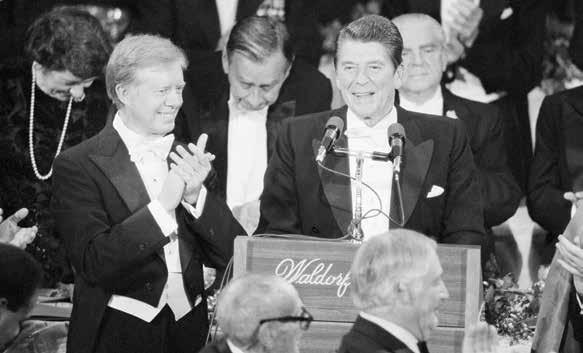


106
Above: Presidential nominees John F. Kennedy and Richard M. Nixon join Francis Cardinal Spellman at the 1960 Al Smith dinner.
TOP TO BOTTOM: AP IMAGES / GETTY IMAGES / AP IMAGES white house history quarterly
Left: Archbishop Terence Cooke shares a laugh with President Lyndon B. Johnson, Democratic presidential nominee Hubert Humphrey, and Republican nominee Richard Nixon during the 1968 dimmer.
Left: President Jimmy Carter applauds as Ronald Reagan, his opponent in the upcoming presidential election, addresses guests at the 1980 Al Smith dinner.




107 GEORGE H. W. BUSH: AP IMAGES / ALL OTHERS: GETTY IMAGES white house history quarterly
Above: Democratic presidential candidate Barack Obama speaks at the 2008 dinner while John McCain, the Republican candidate, enjoys his jokes.
Right: Democratic presidential nominee Hillary Clinton laughs as her Republican opponent Donald Trump delivers remarks at the 2016 dinner.
Left: Republican nominee George W. Bush and his Democratic opponent, Al Gore, enjoy the banter with Archbishop Edward Egan at the 2000 dinner.
Below: Cardinal John J. O’Connor sits with republican George H. W. Bush and his wife Barbara, and Michael Dukakis, a democrat, at the 1988 annual Al Smith Dinner.
an
essay titled
“A Home away from Home.”68 LATER PRESIDENTS AT THE WALDORF
The Waldorf’s connection to the White House extended beyond Hoover and Apartment 31A. In the Waldorf Towers, U.S. presidents often used Apartment 35A, or “The Presidential Suite.” To be certain, visiting heads of state and other VIPs stayed there, but America’s commander in chief had first claim on it. In 1958, Eisenhower’s sudden decision to address the United Nations forced Secretary of State John Foster Dulles to vacate the suite and move into accommodations one floor up.71 Apartment 35A functioned as a White House away from the White House. It had four bedrooms, four bathrooms, a dining room, and a drawing room with a fireplace. Patriotic accents abounded. In 1962, one saw eighteenth-century–style American and British furniture—and a rocking chair modeled after President Kennedy’s. There was “Scenic America” wallpaper in the drawing room and cornices “with gold stars and eagles” in the dining room. Yellow tones dominated the master bedroom, a reminder of the color-specific rooms in the White House.69 Several presidents contributed to its decor. There were “eagle wall sconces” from Nixon, an “eagle desk set” from Jimmy Carter, and an “eagle-based table” from Ronald Reagan.70 The hotel efficiently adapted to a president’s presence. Offices adjacent to the lobby became press rooms equipped with typewriters and telephones.71 Every president from FDR to Barack Obama set up shop in Apartment 35A. Although Kennedy preferred to stay at the Carlyle Hotel, he held meetings in the Waldorf’s Presidential Suite.72
Presidential appearances remained an important part of life at the Waldorf. During one week in 1963, the hotel hosted two presidents. At separate events, Eisenhower received awards from the United Pilgrims of America, an “Anglo-American unity” outfit, and the American Iron and Steel Institute, which heralded Ike’s contributions to “the strengthening of individual enterprise.” Days afterward, six hundred Democratic Party donors gathered in the Empire Room for a birthday salute to JFK.73 Only a few months later, Eisenhower was at the hotel when news broke that Kennedy had been assassinated. Ike emerged from the Waldorf to express his condolences to Kennedy’s family. He condemned the “despicable act” that took the president’s life and predicted that Americans
would stand united behind their government.74
A year later, however, Eisenhower sounded a different note. During a luncheon at the Waldorf, he assailed deficit spending, “doles” to poor people, public power projects, and moves “toward Federal domination over almost every phase of our economy.” The salvos—from a moderate Republican— surprised the audience, an assemblage of insurance executives. “It was as if Barry Goldwater were talking himself,” one man observed.75 Such rhetoric signified the growing clout of the GOP’s right wing as well as America’s widening political divide.
Brief breaks from partisan rancor occurred at the Al Smith Memorial Foundation Dinner, held annually at the Waldorf. Every four years between 1960 and 2016, the nominees of both parties attended the white-tie event to honor Smith’s legacy, raise funds for Catholic charities, and trade friendly barbs. In 1968, the retiring president stole the show. Paraphrasing a famous lament by Nixon— seated nearby—LBJ joked: “Pretty soon you won’t have Lyndon Johnson to kick around anymore.”76 First ladies have joined in the fun. At the 1989 dinner, Barbara Bush’s self-deprecating wit took center stage. “At last,” she said, “I get a chance to prove that I’m more than just a pretty face.”77 In 2000, her eldest son ribbed the dinner’s attendees. “This is an impressive crowd—the haves and the have-mores,” George W. Bush deadpanned. “Some people call you the elite; I call you my base.”78 The line provided fodder for Michael Moore, who included it in his antiwar film Fahrenheit 9/11 (2004). Perhaps the most gracious comments at the Al Smith Dinner came in 2008, when John McCain praised Barack Obama’s “impressive” political skills and wished his Democratic rival well.79
Presidential speeches at the Waldorf often raised hopes or sparked unrest. Few politicians stirred greater passions than Nixon, who enjoyed a long association with the hotel. In a speech at the Waldorf in 1953, Nixon outlined this thinking on domestic affairs. He disparaged the welfare state, which “absorbs the citizens and private groups” via “cradle to grave” regulations. The vice president professed instead his belief in the “general welfare state” that “seeks to help, not control” the “free energies of labor, business and the farmer.”80 Revisionist historians have traced Nixon’s moderate ideology, and policies, to this address.81 In 1968, Nixon delivered his first remarks as president-elect from the Waldorf’s Grand Ballroom. The “great objective”
108 white house history quarterly
of his administration, he proclaimed, was “to bring the American people together.”82 To a country rent over race, civil rights, crime, and the Vietnam War, such words offered little more than a salve. The war in Vietnam continued, as did criticism of it. In 1966, four thousand demonstrators had picketed a Johnson speech at the Waldorf; they chanted “war on poverty, not people” and carried Viet Cong flags, along with a large “Impeach LBJ” sign.83 Three years later, three thousand antiwar activists clashed with police near the Waldorf, where Nixon was attending the National Football Foundation’s dinner. They had assembled, they claimed, “in answer to the President’s recent television appeal for the ‘silent majority’ to speak up.”84 Presidents came and went and the issues changed, but protest at the hotel endured. In 1990, members of the AIDS Coalition to Unleash Power (ACT UP) infiltrated the Waldorf while President George H. W. Bush spoke at a GOP fund-raiser. They voiced disapproval of Bush’s response to the AIDS epidemic by staging “die-ins” in the hotel’s lobby and unfurling a banner that demanded, “READ OUR LIPS: AIDS ACTION NOW.” The demonstration overshadowed Bush’s speech and was light-years removed from the quiet evenings Herbert Hoover had spent with compatriots in Apartment 31A.85

THE WALDORF IN THE TWENTY-FIRST CENTURY
The twenty-first century brought change to the hotel Hoover once called America’s “Guest House.”86 In 2014, a Chinese insurance company purchased the Waldorf-Astoria and made plans to transform the building into condominiums and a boutique hotel. Shortly thereafter, President Obama declined to stay at the hotel, citing “security concerns.” “Its glory days had passed,” the historian David Freeland acknowledged.87 The final Al Smith Dinner at the Waldorf, in 2016, marked the end of an era. Hillary Clinton and Donald J. Trump jibed each other, but many guests thought that Trump went too far and they booed him.88 Trump’s candidacy, and election, brought attention to hotels and commercial real estate owned by a president. Trump Tower, the Manhattan skyscraper that was Trump’s business headquarters and home, eclipsed the Waldorf, which closed for renovation in 2017. Yet the next chapter remains to be written. The Waldorf’s eventual reopening may bring renewed ties between the presidency and an iconic landmark.
109 white house history quarterly GETTY IMAGES
President-elect Richard Nixon enjoys his victory on election night at the WaldorfAstoria, November 6, 1968.
notes
1. Herbert Hoover, “Radio Remarks on the Opening of the Waldorf-Astoria Hotel,” September 30, 1931, Public Papers of the Presidents of the United States: Herbert Hoover (1931) (Washington, D.C.: United States Printing Office, 1976), 447.
2. David Freeland, American Hotel: The Waldorf-Astoria and the Making of a Century (New Brunswick, N.J.: Rutgers University Press, 2021), 297.
3. “Waldorf Boom Row Is Growing Rapidly,” New York Times, June 19, 1924, 3.
4. Hubert H. Humphrey, The Education of a Public Man: My Life and Politics (Minneapolis: University of Minnesota Press, 1991), 178.
5. Freeland, American Hotel, 278–79; “The Mondale Way to the Presidency,” Wall Street Journal, February 22, 1983, 30.
6. Eleanor Roosevelt, “My Day,” December 6, 1950, Eleanor Roosevelt Papers, Digital Edition, George Washington University website, www2.gwu.edu.
7. “Candidates, Ike Aid ‘War’ On Bigotry,” Washington Post, October 27, 1960, A11.
8. Eleanor Roosevelt, speech, October 26, 1960, folder Transcripts of Eleanor Roosevelt’s Appearances on Behalf of JFK, 1960 [1 of 3], box 15, series 4: Campaigns, 1960–1980, Abba P. Schwartz Personal Papers, John F. Kennedy Library, Boston, Mass.
9. “Excerpts From Address Here by Senator Goldwater,” New York Times, January 16, 1964, 21.
10. “Goldwater Urges Study of the Poor,” New York Times, January 16, 1964, 21.
11. “Johnson Pledges Restraint Abroad and in Race Issue,” New York Times, August 13, 1964, 1.
12. Dean Kotlowski, “The Presidents Club Revisited: Herbert Hoover, Lyndon Johnson, and the Politics of Legacy and Bipartisanship,” Historian 82, no. 4 (2020): 482–83.
13. Joseph P. Binns, oral history interview by Raymond Henle, October 10, December 2, 1968, transcript, 25, Herbert Hoover Presidential Library, West Branch, Iowa.
14. W. A. Doerr to Roy W. Howard, October 4, 1939, folder 1939 City File—New York—Herbert Hoover Interview, box 154, Roy W. Howard Papers, Manuscript Division, Library of Congress, Washington, D.C.
15. Irwin Hoover, undated notes, folder White House Herbert Hoover, box 6, Irwin H. Hoover Papers, Library of Congress.
16. Daniel Rodriguez, oral history interview by Robert Cubbedge, February 10, 1971, transcript, 19–20, Hoover Library.
17. “Truman Is Recalled Here for Warmth and Simplicity That Had Wide Appeal,” New York Times, December 28, 1972, 25.
18. Hoover, “Speech on the Occasion of the 20th Anniversary of the Opening of the Waldorf-Astoria Hotel,” November 5, 1951, file 3332, Herbert Hoover Special Collections—Articles, Addresses and Public Statements, 1915–1964, Hoover Library.
19. Freeland, American Hotel, 80.
20. Joan Hoff Wilson, Herbert Hoover: Forgotten Progressive (New York: HarperCollins, 1975), 279.
21. Herbert Hoover, The Crusade Years, 1933–1955: Herbert Hoover’s Lost Memoir of the New Deal Era and Its Aftermath, ed. George H. Nash (Stanford, Cal.: Hoover Institution Press, 2013), 51–328.
22. James A. Farley, oral history interview by Raymond Henle, December 7, 1966, transcript, 29, Hoover Library.
23. Hoover, “Remarks at the Twenty-Fifth Anniversary of the Waldorf-Astoria Hotel,” September 28, 1956, file 3756, Herbert Hoover Special Collections, Hoover Library.
24. Kotlowski, “Presidents Club Revisited,” 469–71, 483–85.
25. Hoover, Crusade Years, 11–13.
26. Herbert Hoover to Oscar Tschirky, November 16, 1932, file 2057, Herbert Hoover Special Collections, Hoover Library.
27. George H. Nash, Herbert Hoover and Stanford University (Stanford, Cal.: Hoover Institution Press, 1988), 57–59, 118; Nancy Beck Young, Lou Henry Hoover: Activist First Lady
(Lawrence: University Press of Kansas, 2004), 183–85.
28. Fio Dell’agnese, oral history interview, with Raymond Henle, October 7, 1968, transcript, 7 (“lovely’) and 5 (“permanent guest’), Hoover Library.
29. Hoover to Lucius Boomer, June 29, 1940, folder 2216 (2), box 20, Herbert Hoover Post-Presidential Papers: Individual File, Hoover Library.
30. Hoover to Joseph P. Binns, February 1, 1952, October 2, 1952, March 13, 1954, April 11, 1955, September 6, 1955, October 2, 1956, and October 17, 1956, folder 2189 (1), box 18, Hoover PostPresidential Papers: Individual File, Hoover Library.
31. Nonunion employees objected to a contract that prevented them from continuing their health insurance upon retirement or the end of their employment at the Waldorf. Hoover to Binns, October 29, 1955, folder 2189 (1), box 18, Hoover PostPresidential Papers: Individual File, Hoover Library.
32. N. Loyall McLaren essay, “Herbert Hoover’s Welcome into the Old Guard,” August 25, 1967, attached to N. Loyall McLaren, oral history interview by Raymond Henle, November 5, 1967, Hoover Library.
33. Quoted in Hoover, Crusade Years, 12.
34. Rodriguez oral history, 2, 10–19, 28–32; M. Elizabeth Dempsey, oral history interview by Raymond Henle, July 13, 1967, transcript, 27, 29, 40, quotation on 37, Hoover Library.
35. Quoted in Michael J. Le Pore, oral history interview by Raymond Henle, December 5, 1966, transcript, 50–51, Hoover Library.
36. Charles Edison, oral history interview by Raymond Henle, December 6, 1966, transcript 13, Hoover Library.
37. Quoted in “Joe Garagiola Broadcast on NBC,” October 22, 1964, folder Hoover Funeral, box 182, Hoover Post-Presidential Papers: Subject File, Hoover Library.
38. Dempsey oral history, 17.
39. “Remarks by Honorary Commodore Herbert Hoover, Key Largo Anglers Club Induction of Flag Officers,” March 3, 1961, attached to J. Clinton Campbell, oral history interview by Raymond Henle, April 15, 1967, Hoover Library.
40. Hoover to Jorgine Boomer, March 28, 1962, folder 2217 (2), box 20, Hoover Post-Presidential Papers: Individual File, Hoover Library.
41. Rodriguez oral history, 33.
42. Rudolph N. Schullinger, oral history interview by Charles T. Morrissey, October 27, 1968, 11; Dempsey oral history, 1; Bernice Miller, oral history interview by Ray [Raymond?] Henle, December 7, 1966, 10, all Hoover Library. See these books by Hoover: The Ordeal of Woodrow Wilson (New York: McGraw-Hill, 1958); Fishing for Fun: And to Wash Your Soul (New York: Random House, 1963); Herbert Hoover on Growing Up: His Letters from and to American Children, ed. William Nichols (New York: William Morrow, 1962); Freedom Betrayed: Herbert Hoover’s Secret History of the Second World War and Its Aftermath, ed. George H. Nash (Stanford, Cal.: Hoover Institution Press, 2011).
43. Hoover to Henry J. Taylor, January 20, 1945, folder Herbert Hoover Correspondence, 1923–1929, box 1, Loretta Camp Frey Papers, Hoover Library; Herbert Hoover, The Memoirs of Herbert Hoover: The Great Depression, 1929–1941 (New York: Macmillan, 1952), 2–28, 161–66.
44. Richard Norton Smith, An Uncommon Man: The Triumph of Herbert Hoover (New York: Simon and Schuster, 1984), 406.
45. John D. M. Hamilton, “Visit with Mr. Hoover,” July 27, 1955, folder Visit with Mr. Hoover 7/27/55, 3/9/56, and 6/860, box 15, John D. M. Hamilton Papers, Library of Congress.
46. Farley oral history, 5–8; Dell’agnese oral history, 10; Kotlowski, “Presidents Club Revisited,” 470–73.
47. Herbert Hoover quoted by Richard Nixon in “Frank Gannon’s interview with Richard Nixon,” September 7, 1983, part 1, Oral History Collections, University of Georgia Special Collections Libraries, Athens, Ga., online at https://georgiaoralhistory.libs. uga.edu.
48. Smith, An Uncommon Man, 403–31.
49. Quoted in “31st President Achieved Prominence in Four Major
ALL PHOTOS THIS SPREAD: WHITE HOUSE HISTORICAL ASSOCIATION
white house history quarterly 110
Careers During His Lifetime,” New York Times, October 21, 1964, 40.
50. Herbert Hoover, speech, July 25, 1960, folder Hoover, Herbert and Family, 1948–69, box 33, James A. Farley Papers, Library of Congress.
51. Rodriguez oral history, 9.
52. The Duke and Duchess of Windsor to Richard E. Berlin, October 22, 1964, folder Condolences, 1963–1966, box 4, Herbert Hoover Death and Funeral Collection, Hoover Library.
53. James A. Farley to Allan Hoover, March 5, 1965, folder Condolences—Responses, 1964–1965 (6 of 6), box 4, Herbert Hoover Death and Funeral Collection, Hoover Library.
54. Farley to Allan Hoover, November 6, 1964, folder Hoover, Herbert and Family, 1948–69, box 33, Farley Papers.
55. Edison oral history, 9.
56. Dempsey oral history, 33.
57. Rodriguez oral history, 31.
58. Binns oral history, 8–9.
59. Hoff Wilson, Herbert Hoover, 231.
60. Mrs. John A. Brown, oral history by Raymond Henle, December 6, 1966, 9, Hoover Library.
61. Dell’agnese oral history, 15.
62.“Herbert Hoover,” Philadelphia Inquirer, October 21, 1964, folder Hoover Death Clips USA Region 2, box 3, Hoover Death and Funeral Collection; “Herbert Hoover,” Dallas Morning News, October 21, 1964, and “Hoover Marked His Service,” San Angelo (Tex.) Standard-Times, October 21, 1964, both folder Hoover Death Clips USA Region 7, box 3, Herbert Hoover Death and Funeral Collection, Hoover Library.
63. “Herbert Hoover,” Washington Post, October 21, 1964, A20; “Herbert Hoover,” Buffalo Evening News, October 21, 1964, folder Hoover Death Clips USA Region 2, box 3, Herbert Hoover Death and Funeral Collection, Hoover Library.
64. Stephen Skowronek, The Politics Presidents Make: Leadership from John Adams to Bill Clinton (Cambridge, Mass.: Belknap Press of Harvard University Press, 1997), 261.
65. John Bartlow Martin, review Herbert Hoover: A Public Life, by David Burner, Social Practice (Winter–Spring 1979), 91, copy in folder 8, box 203, John Bartlow Martin Papers, Library of Congress.
66. Belfast Telegraph, October 21, 1964, folder Clips Europe British Isles, box 1, Herbert Hoover Death and Funeral Collection, Hoover Library.
67. “The Restoration of Herbert Hoover,” Wall Street Journal, August 5, 1974, 10.
68. Herbert Hoover, “A Home away from Home” [1939], folder 2216 (2), box 20, Hoover Post-Presidential Papers: Individual File, Hoover Library.
69. “Presidential Suite of Waldorf Towers Is Redecorated with an Eye to Color,” New York Times, April 18, 1962, 59.
70. Scott Mayerowitz, “Behind the Scenes at the Waldorf Astoria’s Posh Presidential Suite,” posted September 21, 2009, ABC News website, https://abcnews.go.com.
71. “Dulles Loses Presidential Suite As Waldorf Protocol Takes Over,” New York Times, August 13, 1958, 3.
72. “Presidential Suite of Waldorf Towers.”
73. “Waldorf Faces Job of Planning Fetes for 2 Presidents,” New York Times, May 21, 1963, 62.
74. Quoted in David Eisenhower with Julie Nixon Eisenhower, Going Home to Glory: A Memoir of Life with Dwight D. Eisenhower, 1961–1969 (New York: Simon and Schuster, 2010), 120–21.
75. “Eisenhower Hits at Federal Doles,” New York Times, December 10, 1964, 29.
76. “Johnson Shares Dais Here with Nixon and Humphrey,” New York Times, October 17, 1968, 1.
77. “The Keynote Quipster: Mrs. Bush at New York’s Al Smith Dinner,” Washington Post, October 20, 1989, B1, B9.
78. “Presidential Rivals Feast on Jokes, Jabs,” Washington Post,
October 20, 2000, A9.
79. John McCain, remarks at 2008 Al Smith Dinner, posted August 18, 2018, NBC News website, www.nbcnews.com/video.
80. “Text of Vice President Nixon’s ‘Report From Washington’ Speech to Publishers’ Convention,” New York Times, April 24, 1953, 20.
81. Joan Hoff, Nixon Reconsidered (New York: Basic Books, 1994), 116.
82. “Transcript of the Statement by Nixon Pledging to ‘Bring America Together,’” New York Times, November 7, 1968, 21.
83. “4,000 Picket Johnson in Antiwar Protest at Hotel,” New York Times, February 24, 1966, 16.
84. “63 Arrested, 8 Policemen Hurt As 3,000 Protest Nixon’s Visit,” New York Times, December 10, 1969, 1.
85. Freeland, American Hotel, 288, 285, 289.
86. Hoover, “Remarks at the Twenty-Fifth Anniversary of the Waldorf-Astoria Hotel.”
87. Freeland, American Hotel, x.
88. “2016 Al Smith Dinner (Full) The New York Times,” video on YouTube, www.youtube.com.
white house history quarterly 111

NEW YORK MOMENTS
Fleeting Glimpses of White House History
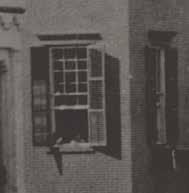
113 white house history quarterly NEW YORK PUBLIC LIBRARY
Beginnings Remembered



114 white house history quarterly CAPTION
The Road to the White House

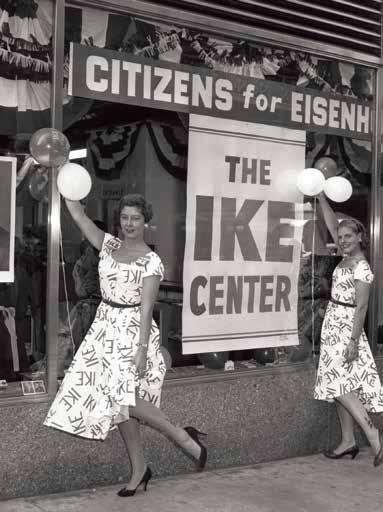

115 white house history quarterly
Scheduled Appearances, Unexpected Sightings

New York’s Waldorf-Astoria has welcomed presidents, first ladies, and those close to the presidents at political and social events for more than a century.
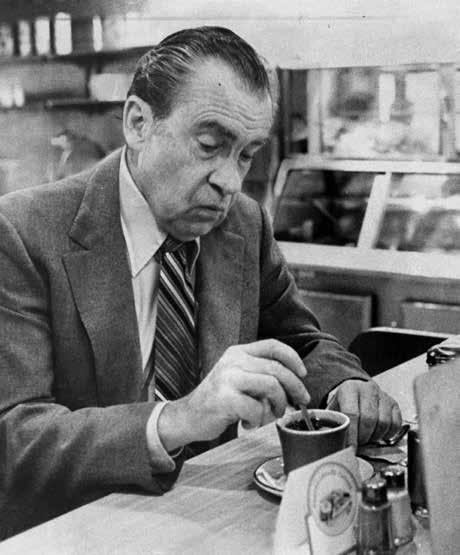


116 white house history quarterly CAPTION


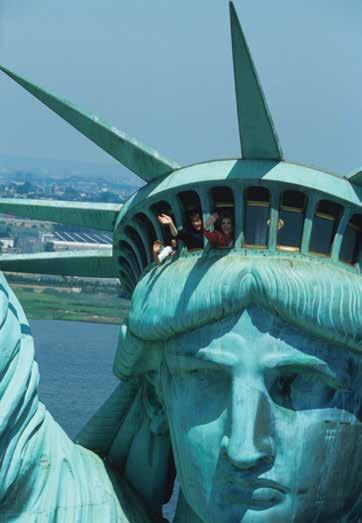
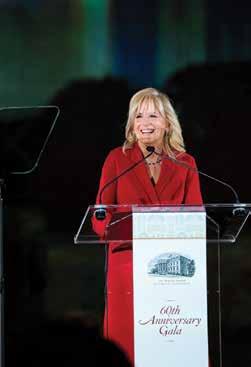
117 white house history quarterly
REFLECTIONS
My Top Ten
text Text
the white house collection of fine arts is among the best in the world. As you walk from room to room on the State Floor or the Ground Floor or in the nonpublic historic spaces upstairs, hundreds of paintings, drawings, and sculptures bring American history to life and speak to the rich and diverse heritage that is represented by, as First Lady Jacqueline Kennedy said, the house that “belongs to the American people.”
Dolley Madison from the fire of 1814, it is the only work in the collection that was in President’s House on November 1, 1800, when President Adams moved in.
Third on my list is a small but very special wax profile of James Hoban, the builder selected by George Washington to design a house for the presidents who would follow him.
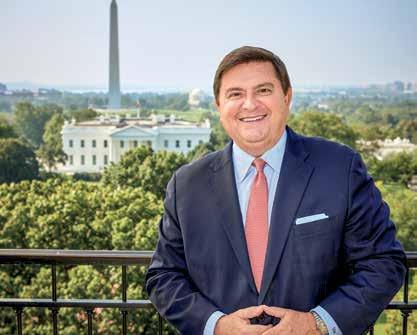
My list includes two important recent acquisitions made for the collection by the White House Historical Association: Jacob Lawrence’s evocative work, The Builders, was given during the years of our collaboration with First Lady Laura Bush, and Alma Thomas’s joyful Resurrection is a gift made during our years working with First Lady Michelle Obama.
East Room. Famously
It is a difficult task to consider one’s favorites from such an amazing collection that has been assembled since before the first occupants, John and Abigail Adams, moved in. In thinking through the works that have inspired me in various ways I share this sampling of ten favorites. My number one favorites are Liberty and Union , a pair of paintings by Constantino Brumidi, which now hang in the West Garden Room. To me the most iconic painting of all is Gilbert Stuart’s portrait of George Washington presently displayed in the East Room. Famously saved by First Lady
The grand spirited sculptural works by Frederic Remington make my list at number five. The Bronco Buster and Coming Through the Rye are powerful expressions of a bygone era on the frontier.
Of course, the portraits of presidents and first ladies themselves are the backbone of the historic collection, and my favorites include four twentieth-century first ladies, Edith Roosevelt, Grace Coolidge, Jacqueline Kennedy, and Nancy Reagan, who were so elegantly portrayed by master portraitists. The White House Historical Association has published a wonderful resource that every follower of this quarterly journal should have. It is Art in the White House by William Kloss, which includes photographs and details on more than five hundred works of art in the collection. It is available in our Washington, D.C., shops or online at shop.whitehousehistory.org.
/
118
white house history quarterly
STEWART D. M C LAURIN PRESIDENT, WHITE HOUSE HISTORICAL ASSOCIATION
reflections Title
116
STEWART D. M C LAURIN PRESIDENT, WHITE HOUSE HISTORICAL ASSOCIATION
white house history quarterly ALL PHOTOS THIS SPREAD AND NEXT: WHITE HOUSE HISTORICAL ASSOCIATION
ALL PAINTINGS THIS SPREAD AND NEXT: WHITE HOUSE COLLECTION
Washington to design a house
OneConstantino Brumidi’s Liberty (above), 1869 and Union (left), 1869
WHITE HOUSE HISTORY Quarterly
white house history quarterly features articles on the historic White House, especially relating to the building itself and life as lived there through the years. The views presented by the authors are theirs and do not necessarily reflect the position or policy of the White House Historical Association.
title page: Model of manhattan, Queen’s Museum, 2023, [bruce white for the white house historical association]
back cover: TK
the white house historical association was chartered on November 3, 1961, to enhance understanding, appreciation, and enjoyment of the historic White House. Income from the sale of White House History Quarterly and all the Association’s books and guides is returned to the publications program and is used as well to acquire historical furnishings and memorabilia for the White House.
address inquiries to:
White House Historical Association
P.O. Box 27624
Washington, D.C. 20038 books@whha.org
© Copyright 2023 by the White House Historical Association. All rights reserved. No part of this publication may be reproduced, stored in a retrieval system, or transmitted, in any form or by any means, electronic, mechanical, photocopying, recording, or otherwise, without prior written permission of the White House Historical Association.
issn: 2639-9822
120
white house history quarterly





 MATT GREEN
MATT GREEN






















 A DISGRUNTLED OFFICE SEEKER.
A DISGRUNTLED OFFICE SEEKER.


















 SCOTT HARRIS
SCOTT HARRIS





























































 FPO Color to be perfected
FPO Color to be perfected
















 DEAN J. KOTLOWSKI
DEAN J. KOTLOWSKI










































